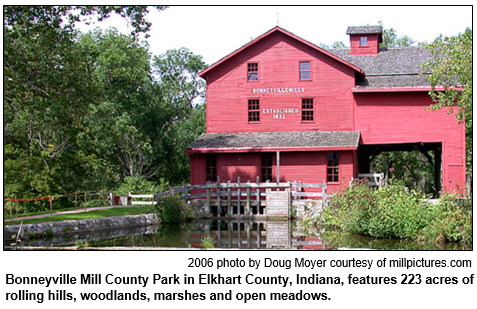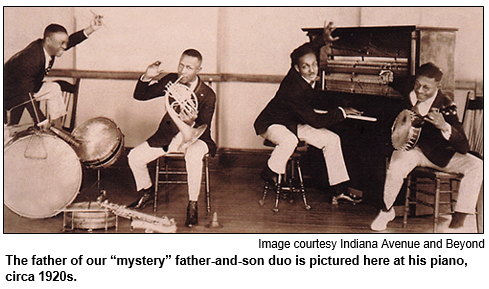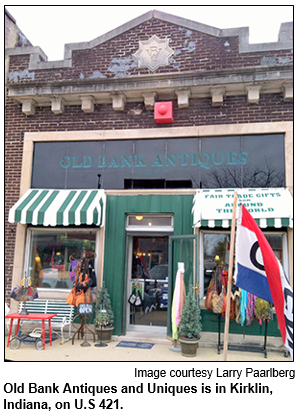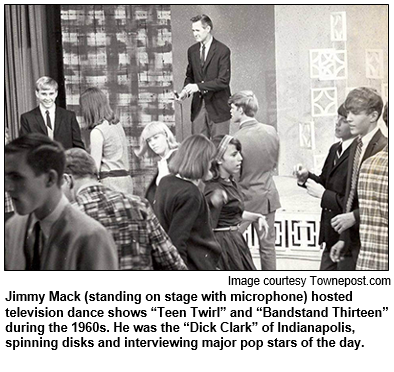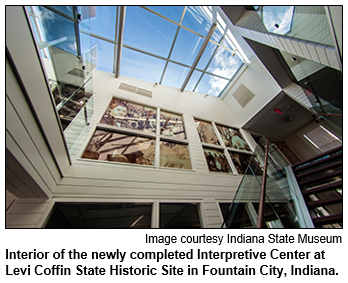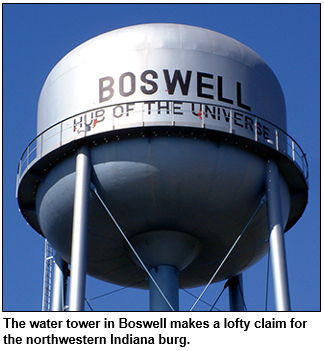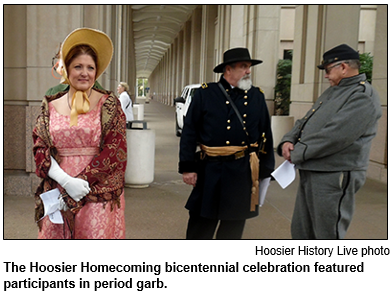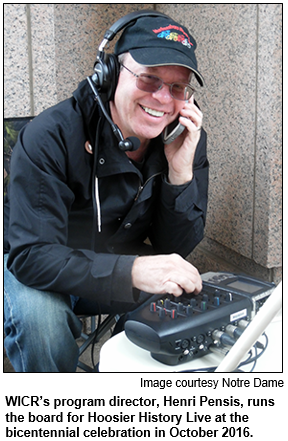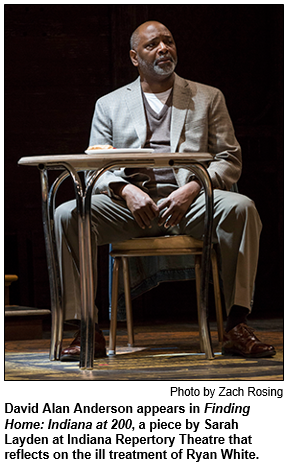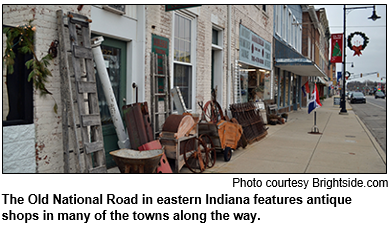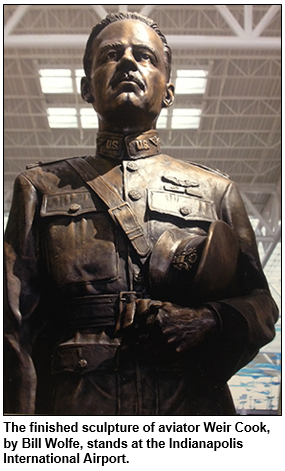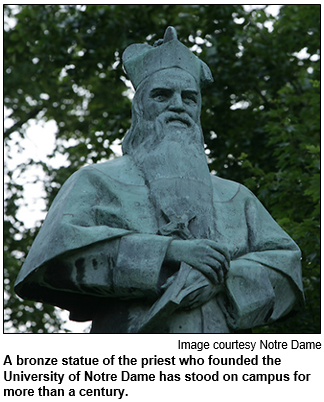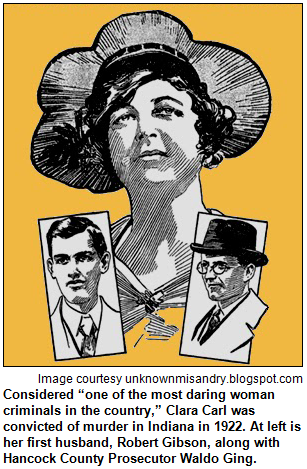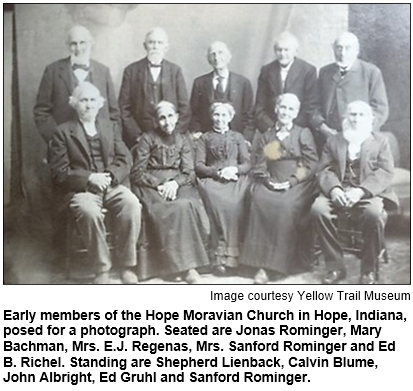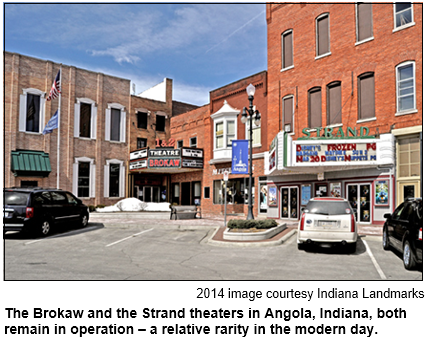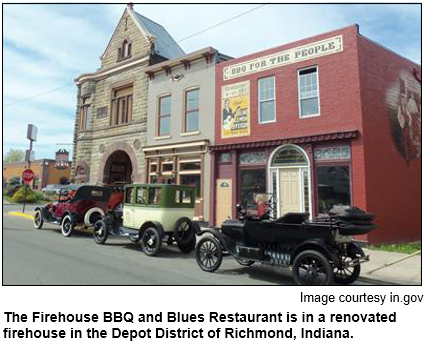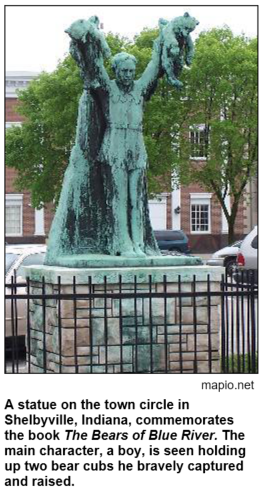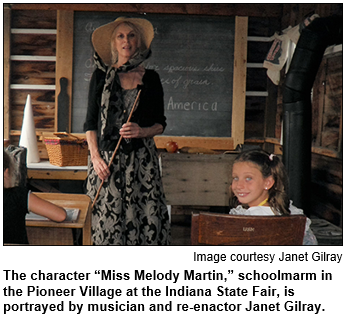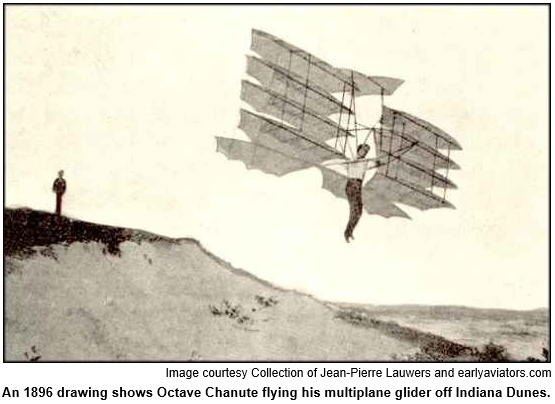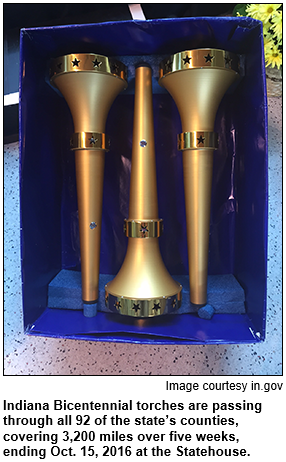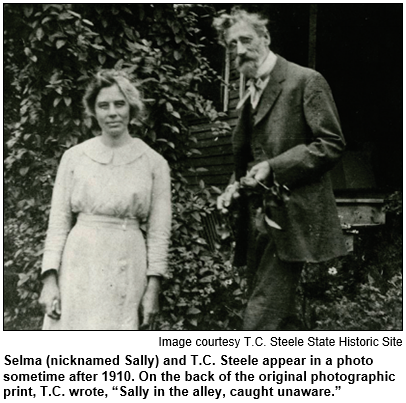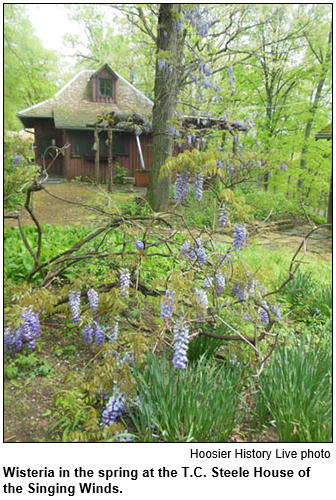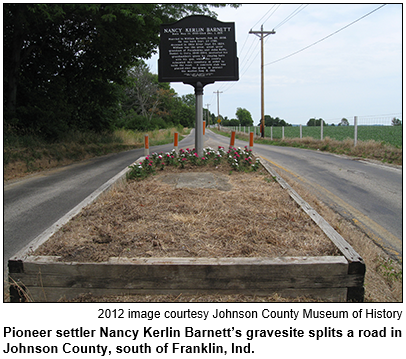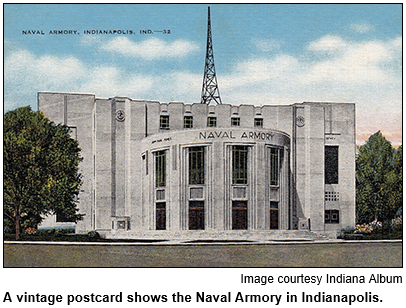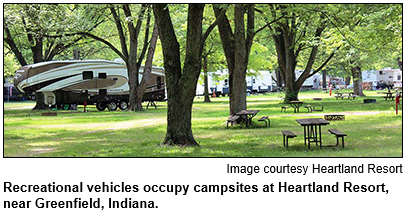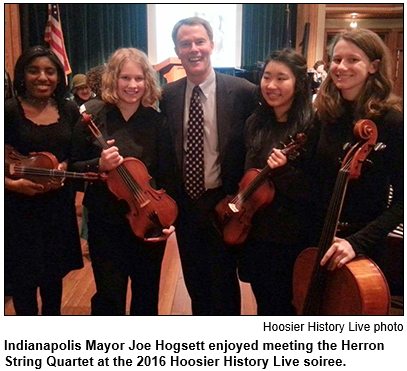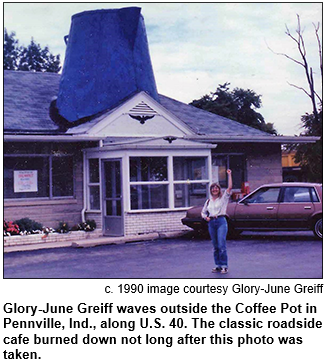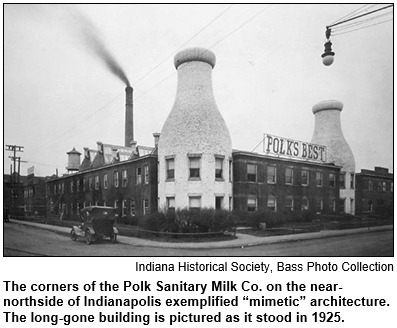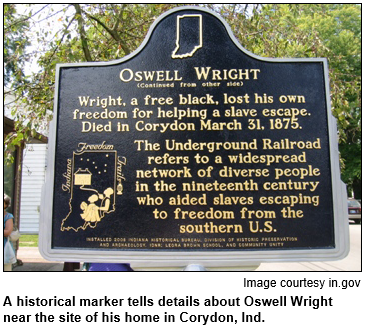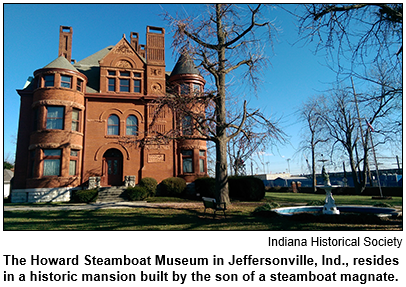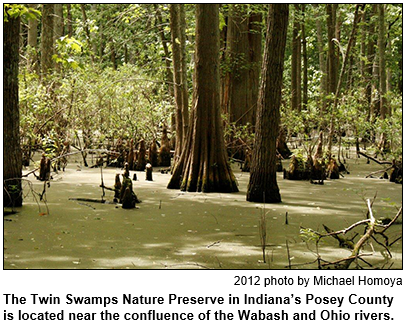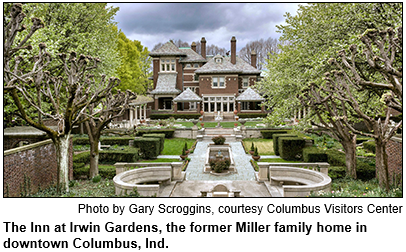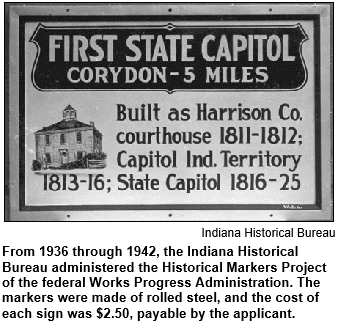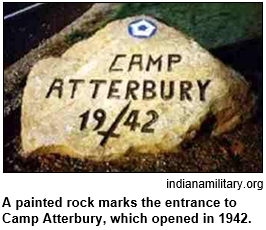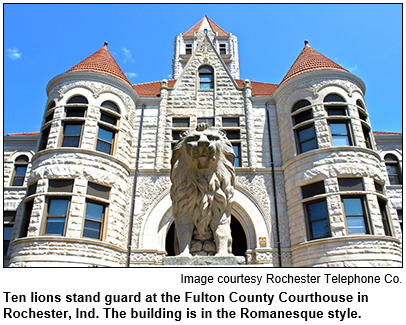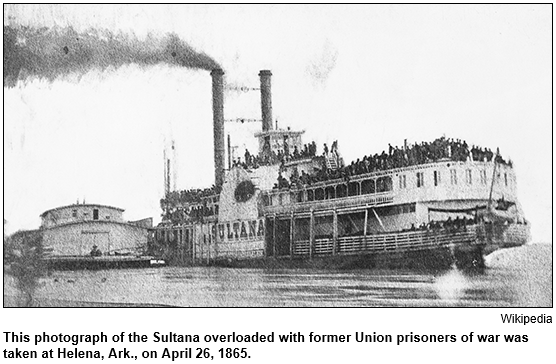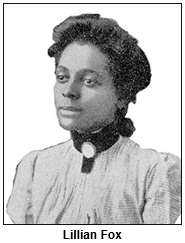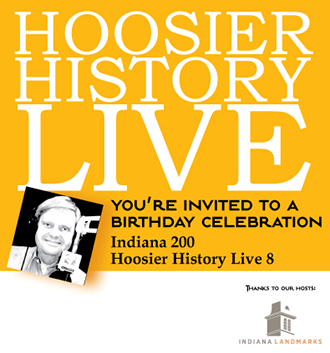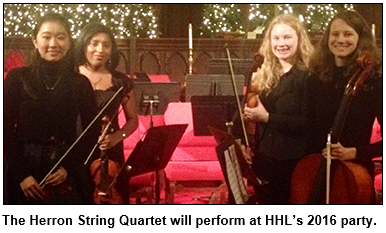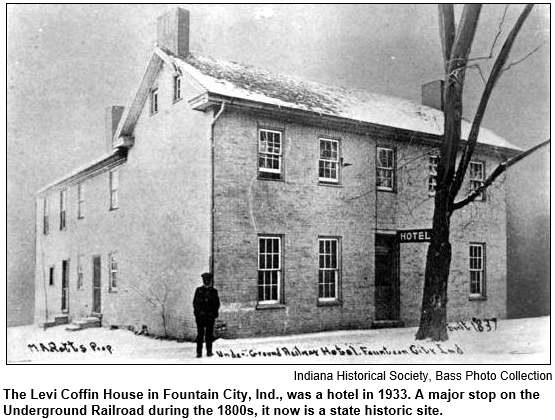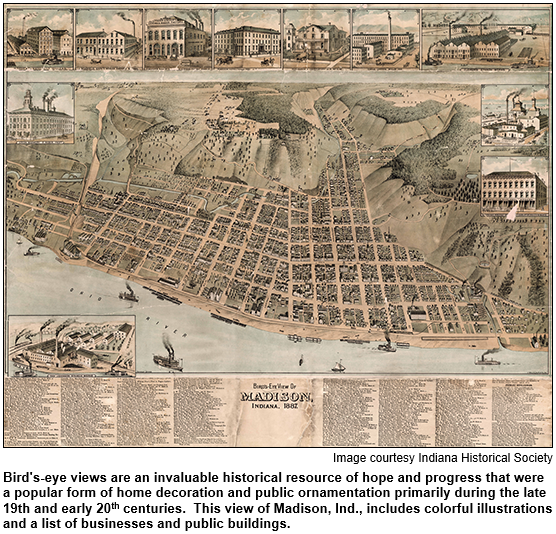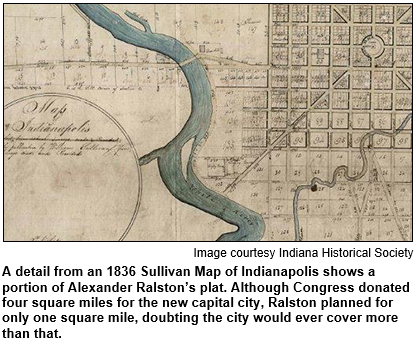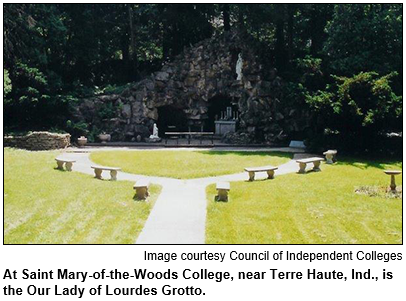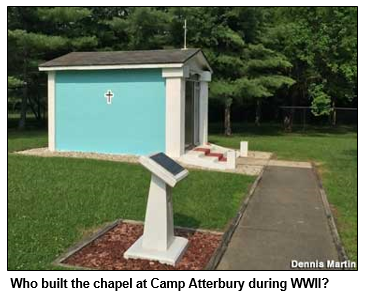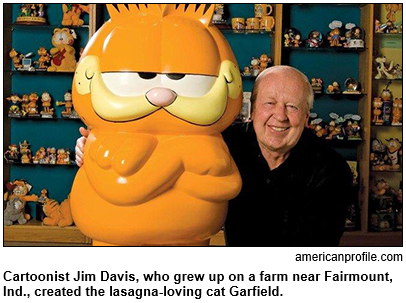Home | About us | Support the show | Contact us | Archives | Listen
2018 | 2017 | 2016 | 2015 | 2014 | 2013 | 2012 | 2011 | 2010 | 2009 | 2008
Archives - 2016
Bygone restaurants in Indy
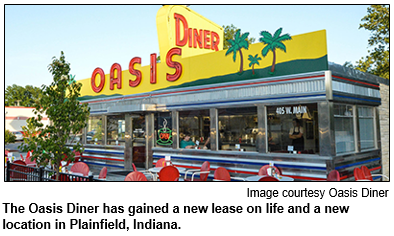 (Dec. 31, 2016) - Baked Alaska, frog legs or chop suey, anyone?
(Dec. 31, 2016) - Baked Alaska, frog legs or chop suey, anyone?
Those dishes were popular at several "destination restaurants" in Indianapolis, during bygone eras when "international" cuisine in the Hoosier capital basically meant Italian, Chinese or "French continental" fare.
The latter was on the menu at the elegant King Cole, a grand (some would say "stuffy") restaurant near Monument Circle that, as a new book puts it, "served the jacket-clad set" for nearly 40 years beginning in 1957. The King Cole, which enforced a strict dress code through the 1980s, is among a platter-sized list of bygone dining establishments, ranging from upscale restaurants to diners and drive-ins, that we explore during our year-end show.
The show doesn't just look at the heydays of places like the Italian Village (which was hugely popular during the 1950s at a North Meridian Street location), the Key West Shrimp House (a Southside destination during an era when dining on fresh seafood in Indy could be a challenge) and La Tour, a French restaurant nestled on an upper floor of what was known as the Indiana National Bank Tower (now Regions Bank Tower) when it opened in 1970.
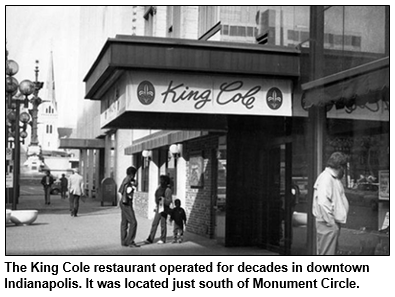 We also explore the evolution of the public's taste in cuisine, insights about collecting vintage menus from bygone dining establishments, and the challenges of restaurant survival.
We also explore the evolution of the public's taste in cuisine, insights about collecting vintage menus from bygone dining establishments, and the challenges of restaurant survival.
Speaking of survival: Our show was broadcast on the same day - New Year's Eve - that the Milano Inn will close after 82 years. Ever since the Great Depression, the Milano Inn served spaghetti, ravioli, chicken cacciatore and other Italian dishes to devoted patrons.
For all of this table talk, Nelson is joined in studio by:
- Jeff Kamm, an Indy-based history buff who is the author of a new book, Classic Restaurants of Indianapolis (The History Press), that includes profiles of - and vintage advertisements for - many of the bygone restaurants we will explore. They range from long-gone dining establishments like the Huddle Restaurants chain (popular, family-focused eateries that were open 24 hours daily and had an ownership relationship with Haag's Drugs, also bygone) to more recently shuttered restaurants such as Chez Jean, a traditional French restaurant in Camby. According to Jeff's book, the final "guests" in 2009 at Chez Jean were firefighters with the Plainfield Fire Department; they burned the vacant building to the ground in a training exercise.
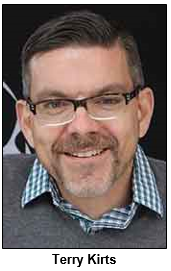 And Terry Kirts, the dining critic for Indianapolis Monthly magazine whose culinary articles and restaurant reviews also have appeared in Nuvo, Indianapolis Dine and other publications. Terry is a senior lecturer in creative writing at IUPUI and the author of To the Refrigerator Gods (Seven Kitchens Press, 2010).
And Terry Kirts, the dining critic for Indianapolis Monthly magazine whose culinary articles and restaurant reviews also have appeared in Nuvo, Indianapolis Dine and other publications. Terry is a senior lecturer in creative writing at IUPUI and the author of To the Refrigerator Gods (Seven Kitchens Press, 2010).
Terry sets the stage for the emergence of the classic Indianapolis restaurants by sharing history tidbits about Delmonico's, an elegant New York City restaurant during the late 19th century.  It became the model (in terms of decor and menu items, including French continental dishes) for "fine dining" establishments across the country, including Indianapolis.
It became the model (in terms of decor and menu items, including French continental dishes) for "fine dining" establishments across the country, including Indianapolis.
The epitome of such establishments on the local scene was the King Cole. "The decor was intentionally stuffy," Jeff writes, noting that it was popular for wedding anniversaries, business meetings and prom dates.
The restaurant's old English interior included oil paintings from the 17th and 18th centuries, leather-upholstered chairs and oak tables. History buffs will be intrigued to learn that the King Cole replaced an upscale restaurant on the site called the Seville; it opened in 1929 in the building at the northeast corner of Meridian and Washington streets.
At the other end of the dining spectrum, bygone diners and drive-ins featured during the show will include the beloved TeePee, the legendary drive-in located next to the Indiana State Fairgrounds that became the epicenter for the "cruising" scene in Indy during the 1950s. The TeePee - which was demolished in the 1980s despite howls from preservationists and enthusiasts of pop culture - was so iconic that it's worth another whirl even though Hoosier History Live explored it and other drive-ins across Indiana during a show in November 2011.
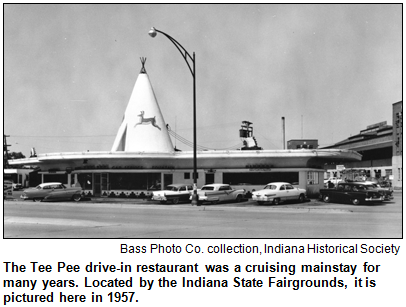 We also update a show about diners across Indiana that aired in July 2010. At that point, the Plainfield Diner - a landmark on U.S. 40 (the Old National Road) that also became known as the Oasis Diner - was vacant and topped the "10 Most Endangered List" by Indiana Landmarks of threatened historic sites across the state.
We also update a show about diners across Indiana that aired in July 2010. At that point, the Plainfield Diner - a landmark on U.S. 40 (the Old National Road) that also became known as the Oasis Diner - was vacant and topped the "10 Most Endangered List" by Indiana Landmarks of threatened historic sites across the state.
Since then, the "rail car" diner - with its original pink-and-black interior from 1954 - has been moved within Plainfield and has been extensively renovated and is enjoying an Act II. So the roadside diner doesn't quite fit our "bygone" theme, but its story is too enticing to resist, particularly with Jeff Kamm as a guest. Jeff, who grew up in Plainfield and has patronized the diner for most of his life, shares its saga, including how it beat the odds when demolition looked likely.
During the show, Jeff also offers statistics about percentages of restaurants that don't make it beyond a one-year anniversary.
Some other morsels of the bygone restaurant heritage in Indy:
- Celebrity chef Wolfgang Puck, a native of Austria, got his start in America by working in the kitchen at La Tour in 1973. He has been quoted about his appalled reaction to local dining preferences during the "India-No-Place" era.
- Merrill's Hi-Decker - which, like the TeePee, was a drive-in located near the state fairgrounds - featured a popular disc jockey in a studio perched atop the circular building, as per Jeff's description in Classic Restaurants of Indianapolis. The sites of both drive-ins are now overflow parking lots for the fairgrounds.
- For nearly 40 years, Jong Mea served Chinese entrees (not, as Jeff puts it in his book, "heavily Americanized chop suey") at a high-visibility site in the 2100 block of North Meridian Street. The family-owned restaurant, which was in a single-story limestone building, closed in 1999.
History Mystery
The oldest still-operating restaurant in Indianapolis opened in 1894.
The restaurant is located inside a distinctive downtown building that recently was named a historic landmark. The restaurant's cuisine is associated with an ethnic heritage group.
Question: What is the restaurant?
The prize is a gift certificate to Story Inn, a bed and breakfast in Brown County, courtesy of Story Inn.
Roadtrip: Bonneyville Mill County Park
|
Guest Roadtripper Jane Ammeson recommends Roadtrip to Bonneyville Mill County Park in Elkhart County in north central Indiana. The park has a unique blend of regional history and natural beauty, including 223 acres of gently rolling hills, woodlands, marshes and open meadows.
Seven miles of hiking trails meander through the park, providing nature enthusiasts a chance to view abundant wildlife and beautiful wilflowers. A six-mile designated mountain bike trail provides mountain bikers a thrilling ride through a wooded and rolling terrain. Learn more on Saturday!
Dec. 24, 2016 - show pre-empted for Christmas music
Merry Christmas and happy holidays from us to you!
(Dec. 20, 2016) - Hoosier History Live will be taking the week off on Saturday, Dec. 24, and WICR will be playing Christmas music for the duration.
To help keep our loyal listeners warm and happy until the next Hoosier History Live program, we heartily recommend this video of a crackling fire in an old-fashioned fireplace.
Merry Christmas to you and yours!
Jazz notables from Indy history - a sequel
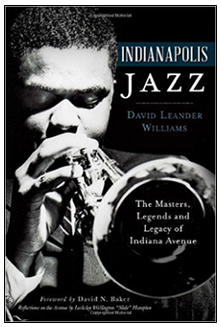 (Dec. 17, 2016) - So many historic jazz entertainers emerged from Indianapolis - from instrumentalists and singers to dancers and educators - that one Hoosier History Live show can merely scratch the surface.
(Dec. 17, 2016) - So many historic jazz entertainers emerged from Indianapolis - from instrumentalists and singers to dancers and educators - that one Hoosier History Live show can merely scratch the surface.
Last month, following the recent death of the last of the Hampton Sisters, we explored their lives and impact, along with those of other multitalented families, including Wes Montgomery and his brothers. Because a parade of many other jazz notables came out of Indy, particularly its Indiana Avenue scene, we have invited our guest, music historian David Leander Williams, to return and share additional insights.
David, a graduate of Attucks High School (like most of the notables we will explore), grew up near Indiana Avenue and is the author of Indianapolis Jazz (The History Press, 2014). His book features profiles of notables whom we will explore during this "sequel" show. Several had the same musical mentor: Harold Brown, a beloved band director at Attucks who was on the original staff when the school opened in 1927.
In fact, a quartet of Attucks alums called themselves the Brown Buddies in the 1930s as a tribute to their favorite teacher. During this show, we will explore the Brown Buddies, who dressed in tuxedos, performed with synchronized movements and, according to Indianapolis Jazz, "captivated their audiences ... in overflowing nightclubs wherever they performed."
Also during our show, David shares insights about:
- Leonard & Leonard, a dancing duo that appeared on Ed Sullivan's TV show in the 1950s and drew rave reviews during a world tour that included stops in Australia. The dancers were not related to each other, but both shared names that included "Leonard": Leonard Chester Thomas and Paul Leonard Harrell.
- Flo Garvin, a singer-pianist who enjoyed a devoted following for decades at nightclubs in Indy and across the Midwest. In 1951, she became the first African-American entertainer to appear on TV in Indiana.
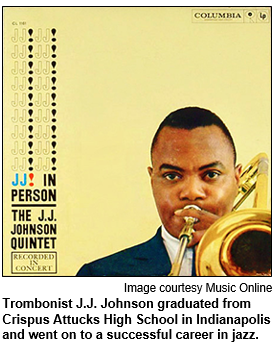 She was the headliner on Sentimental Journey, a music program broadcast on Channel 6/WFBM (now WRTV). Wes Montgomery and his brothers Monk and Buddy were Flo Garvin's instrumental accompanists on the show.
She was the headliner on Sentimental Journey, a music program broadcast on Channel 6/WFBM (now WRTV). Wes Montgomery and his brothers Monk and Buddy were Flo Garvin's instrumental accompanists on the show. - And J.J. Johnson, a widely acclaimed trombonist and Attucks grad. After performing at Indiana Avenue clubs, Johnson "left in the late 1940s and thrilled jazz aficionados on both coasts," David notes in his book.
During our previous show with David, we played a rare Hampton Sisters recording on the Savoy label from 1953. We only had time to enjoy their rendition of Hey Little Boy, an upbeat, fast-paced song.  During this show, we air a much different tune the sisters recorded during the same session, a song David describes as "a slow-moving, sensual love ballad."
During this show, we air a much different tune the sisters recorded during the same session, a song David describes as "a slow-moving, sensual love ballad."
Dawn Hampton, the last surviving sister, was 88 when she died in New York City earlier this year. David shared details about her life and career - as well as those of her sisters Carmelita, Aletra and Virtue - on our previous show. This time, we will discuss the next generation of the multitalented family. For example, Virtue's son, Pharez Whitted, is a noted jazz trumpet player and composer.
Speaking of trumpet players: We explore the impact of Indy native Freddie Hubbard (1938-2008), a Tech High School graduate who, according to Indianapolis Jazz, was "considered by jazz historians as one of the two greatest trumpeters in jazz history along with Miles Davis."  In 1972, Freddie Hubbard's album First Light won a Grammy Award.
In 1972, Freddie Hubbard's album First Light won a Grammy Award.
Hubbard was one of the top trumpeters in the world during the 1960s and '70s. His stardom was diminished in the 1980s following surgery on his lip that, according to Indianapolis Jazz, "impeded his ability to hit those ... soaring notes that were so characteristic of his earlier works of art."
(David's book describes how Hubbard was expelled from the Jordan Conservatory of Music at Butler University for insisting on playing jazz rather than classical music.)
One of Hubbard's classmates at Butler - and his bandmate in his early performing years - was Larry Ridley, a bass and violin player. Our show features details about Ridley, who went on to create the jazz department at Rutgers University, and his younger brother, Michael, a trumpet player.
The Ridley brothers were altar boys at Bethel African Methodist Episcopal Church. Michael Ridley eventually moved to the East Coast and, as Indianapolis Jazz puts it, "dazzled New York jazz aficionados in the nightclubs."
Additional research courtesy Michael Armbruster.
History Mystery
|
During a Hoosier History Live show in November, we explored the careers of the Hampton Sisters and other families who were influential in Indianapolis jazz history.
The families included a father and son with the same name: Sr. and Jr. The father was a popular bandleader during the 1910 and '20s who served as a musical mentor to a young Hoagy Carmichael. He taught ragtime and jazz to the future composer of Stardust and other classics. The father's piano - on which he gave informal instruction to young Hoagy - is frequently displayed at the Indiana History Center.
The son performed with many Indiana jazz groups and taught music for more than 30 years in the Indianapolis Public Schools system.
Question: Who were the father and son with the shared name?
The prize is a gift certificate to Story Inn, a bed and breakfast in Brown County, courtesy of Story Inn.
Roadtrip: Great antiquing in Kirklin in Clinton County
|
Guest Roadtripper Larry Paarlberg, who by day is the director of the General Lew Wallace Study & Museum in Crawfordsville, will be telling us about an historic small town where he makes his home. That town is Kirklin, which is no more than a half-hour drive north of Indianapolis along the Michigan Road, U.S. 421.
If you like to shop local and shop small, Larry will tell us about the great antiquing available in Kirklin. His favorite shop is Old Bank Antiques and Uniques, which is a Fair Trade Store supporting people in Third World countries who produce wonderful works of art and sustainable food items.
Other shops and places to eat in Kirklin? Mimi's Place, Empire Pizza, Clementine's, The Tin Rooster, Ten Thousand Treasures, Shoup's Country, White River Mercantile and an eatery called Momma Jeannie's that Larry tells us has great pies. Enjoy exploring another wonderful Indiana small town!
Rock and roll across 1960s Indiana
|
(Dec. 10, 2016) - Across the Indiana landscape during the 1960s, there may not have been much surf and sand of the sort celebrated in the music of The Beach Boys. But there were plenty of garage bands, rock and roll concerts by national touring groups and jam-packed venues for the music that was captivating Hoosier teenagers during the era.
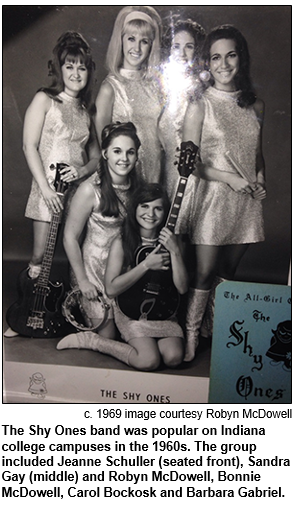 As we explore local music of that time period, Nelson is joined in studio by the author of a new book that offers snapshots of the 1960s rock era (including excerpts from diaries by fans and vintage concert reviews); the host of a popular, local TV show modeled on Dick Clark's American Bandstand; and a member of an all-girl pop rock group based in Indianapolis.
As we explore local music of that time period, Nelson is joined in studio by the author of a new book that offers snapshots of the 1960s rock era (including excerpts from diaries by fans and vintage concert reviews); the host of a popular, local TV show modeled on Dick Clark's American Bandstand; and a member of an all-girl pop rock group based in Indianapolis.
You'll be fascinated by our trio of guests as they share details about everything from a native Hoosier who is the widow of the lead singer for the Dave Clark Five and a rollicking Jimi Hendrix concert in Muncie in 1968 to Hoosier dance bands like the Workmon of Anderson, the Chosen Few of Muncie, the Boys Next Door of Indianapolis and the Teen Tones of South Bend.
During the show, we also embark on radio road trips to explore venues of rock and roll concerts during the 1960s, including the Indiana State Fairground Coliseum, Indiana Beach on Lake Shafer and the Allen County War Memorial Coliseum in Fort Wayne.
The show is sure to be fun, fun, fun (even without daddy's T-bird). Our guides are:
- David Humphrey, a freelance writer-photographer based in Pendleton who is the author of The Golden Years of Rock and Roll in the Hoosier State (M.T. Publishing Co.). David grew up in Anderson and remembers sneaking into a teen dance when he was 10 years old to hear The Chalets, a regionally popular rock and roll group based in his hometown.
- Jimmy Mack, the host of Bandstand 13, a popular teen dance show broadcast on Channel 13 (then WLWI, now WTHR) from 1965 through 1969. Jimmy, who turned 94 this year, also was a well-known disc jockey and appeared at concert venues to play records before nationally known groups performed. In the mid-1960s, he was at the Fairgrounds Coliseum for an appearance by the Rolling Stones.
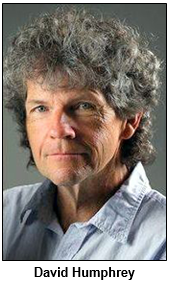 And Robyn McDowell, who joined the Shy Ones, an all-female pop rock group, about a year after graduating from North Central High School in 1968. Robyn's sister Bonnie also was a member of the Indy-based group, which enjoyed an enthusiastic following on college campuses. Robyn is the daughter of Jimmy Mack, whose real name is Jimmy McDowell; today, father and daughter live in the Broad Ripple area.
And Robyn McDowell, who joined the Shy Ones, an all-female pop rock group, about a year after graduating from North Central High School in 1968. Robyn's sister Bonnie also was a member of the Indy-based group, which enjoyed an enthusiastic following on college campuses. Robyn is the daughter of Jimmy Mack, whose real name is Jimmy McDowell; today, father and daughter live in the Broad Ripple area.
"During the golden years of rock and roll in the Hoosier state, there seemed to be a continuous flow of concerts to attend, records to buy or songs to hear on the radio," our guest David Humphrey writes in his new book. 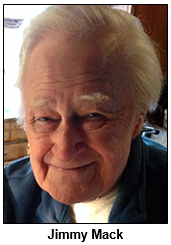 He also is the author of All Those Years Ago (2014), which explores the two historic Beatles concerts during the 1964 Indiana State Fair.
He also is the author of All Those Years Ago (2014), which explores the two historic Beatles concerts during the 1964 Indiana State Fair.
His new book features an interview with Miss Indiana of 1964, who later married Mike Smith, lead singer of the Dave Clark Five. He died in 2008, just 10 days before the group was inducted into the Rock and Roll Hall of Fame; his widow, Charlie Smith, lives in Valparaiso today.
In David's book, Jimmy Mack describes his deejay gigs at dances and sock hops during the 1960s, as well as his extensive TV career.
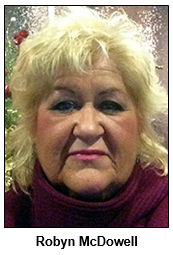 "In the early days of Bandstand 13, boys were required to wear suits, and girls wore dresses," Mack recalls of the show, which featured performances by live acts and local teens dancing to hit records. The TV program also featured on-location footage of recent concerts in Indiana by headliners like Sonny and Cher. Bandstand 13 was broadcast in the morning and evening on Saturdays.
"In the early days of Bandstand 13, boys were required to wear suits, and girls wore dresses," Mack recalls of the show, which featured performances by live acts and local teens dancing to hit records. The TV program also featured on-location footage of recent concerts in Indiana by headliners like Sonny and Cher. Bandstand 13 was broadcast in the morning and evening on Saturdays.
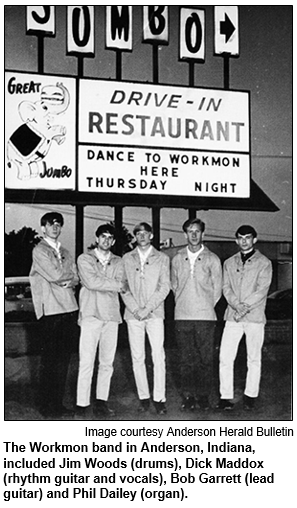 During that era, many of the Indiana-based bands were described with comparisons to nationally known groups. The Boys Next Door, for example, were often called "the Midwestern version of the Beach Boys." According to David's book, the Boys Next Door actually played several shows with the Beach Boys - as well as with Herman's Hermits, The Rascals and many other groups that were household names.
During that era, many of the Indiana-based bands were described with comparisons to nationally known groups. The Boys Next Door, for example, were often called "the Midwestern version of the Beach Boys." According to David's book, the Boys Next Door actually played several shows with the Beach Boys - as well as with Herman's Hermits, The Rascals and many other groups that were household names.
The Indy-based Shy Ones, featuring women playing rhythm guitar, drums and bass, had been performing for several years before our guest Robyn McDowell and her sister joined the group, providing lead vocals. After Robyn and Bonnie left the Shy Ones in 1970, they performed in Vietnam for U.S. troops. Later, Bonnie lived in New York City for 10 years and sang in cabarets. She continues to sing today at weddings and retirement centers.
Back in the early 1960s, venues for many rock and roll concerts - even by national touring groups - included Indiana high school gyms and shopping centers. But, as David's book documents, as the rock industry grew, particularly after the British Invasion, larger venues had to be secured.
Descriptions of concerts in David's book include a diary account of a fan who attended a State Fairgrounds concert in 1964 by Chad and Jeremy, a folk duo known for such hits as Yesterday's Gone and A Summer's Song. There also are recollections of a concert during which Jimi Hendrix, angered by fans using cameras with flash cubes, played the guitar with his back to the audience for the rest of the performance.
On a happier note, David describes how a Hoosier band called The Collegiates (they "ruled the DePauw University music scene from 1962 to 1966") were chosen to be part of a Dick Clark's Caravan of Stars tour stop in Vincennes. Other Indiana-based groups enjoyed opportunities to be the opening acts for The Byrds or The Lovin' Spoonful.
Click the links to hear and see some of these great '60s bands!
Additional research courtesy Michael Armbruster.
History Mystery
In 1965, a local rock and roll group in Anderson performed a concert at a brand-new mall in the city. The mall was the first enclosed shopping center in Anderson, so it generated much excitement among the city's shoppers in the mid-1960s.
 The performance at the new mall by the Anderson-based group The Chalets lasted three hours, according to our guest David Humphrey's book The Golden Years of Rock and Roll in the Hoosier State. In future years, the Chalets opened for some nationally known touring groups, including the Byrds.
The performance at the new mall by the Anderson-based group The Chalets lasted three hours, according to our guest David Humphrey's book The Golden Years of Rock and Roll in the Hoosier State. In future years, the Chalets opened for some nationally known touring groups, including the Byrds.
The shopping mall in Anderson opened with a Montgomery Ward store as an anchor. Although that store was closed years ago, the mall remains open. Current tenants include movie theaters, a shoe store, a pizza restaurant, a cake shop and a pub.
Question: Name the mall in Anderson that opened in 1965.
The prize is four admissions to Glow Golf, the miniature golf course inside the Circle Centre Mall in downtown Indianapolis, courtesy of Glow Golf. Great family fun during the cold-weather months!
Roadtrip: Levi Coffin historic site in Fountain City
|
Guest Roadtripper Dona Stokes-Lucas, an African-American history researcher, will report on the opening of the newly completed Interpretive Center at Levi Coffin State Historic Site in Fountain City, Indiana, just north of Richmond in the eastern part of the state.
The Levi Coffin State Historic Site was considered the Grand Central Station of the Underground Railroad.
The Levi Coffin House was recently featured by Smithsonian Magazine as one of 12 new museums to visit in 2016.
Learn more:
- Underground Railroad reality and myths in Indiana - Newsletter for June 29, 2013 Hoosier History Live radio program.
Statehood Day!
Host Nelson Price will speak Sunday on famous Hoosier women
(Dec. 9, 2016) - Hoosier History Live host Nelson Price will give a presentation this upcoming weekend as part of Statehood Day celebrations. Indiana became the 19th state to join the Union on Dec. 11, 1816. The public is invited to the free event:
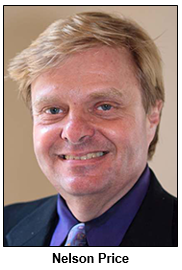 What: Author and Hoosier History Live host Nelson Price speaks about famous Hoosier women
What: Author and Hoosier History Live host Nelson Price speaks about famous Hoosier women- When: 2 p.m. on Sunday, Dec. 11, 2016.
- Where: Indianapolis Public Library's Central Library, 40 E. St. Clair St.
An extensive display of photos will accompany Nelson's talk, which will explore the impact of historic and contemporary women from all walks of life. His presentation will cover:
- Florence Henderson, who died Nov. 24.
- Authors:
- Gene Stratton-Porter (A Girl of the Limberlost).
- Jessamyn West (The Friendly Persuasion).
- Emily Kimbrough (Our Hearts Were Young and Gay).
- Entrepreneur Madam Walker.
- Mother Theodore Guerin, the pioneer Catholic nun who was named Indiana's first saint.
- Suffragette May Wright Sewall.
- Artist Nancy Noel.
- TV newswoman Jane Pauley.
- Caroline Scott Harrison, Indiana's only first lady.
- Movie stars:
- Carole Lombard.
- Irene Dunne.
- Marjorie Main.
- and many others.
Nelson describes the presentation - and chats about the success of Hoosier History Live - during an interview on the library system's cable TV show. No RSVPs are needed for this presentation.
Shopping center history in Indy
(Dec. 3, 2016 - encore presentation) - Retail frenzy is at its peak, ideal for an exploration of the dawn of shopping centers in the Hoosier capital.
So during this encore show (its original air date was Dec. 19, 2015), Hoosier History Live time-travels to the 1950s, which included the openings of what originally were known as Eastgate Shopping Center and Glendale Center.
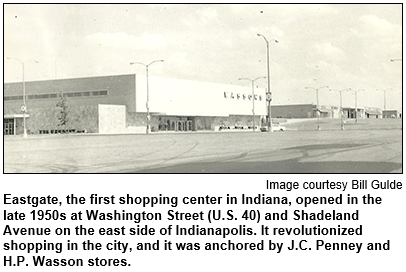 According to our guest Jeff Kamm, Eastgate became "the first large-scale suburban shopping center in Indianapolis" when it opened in 1957 at East Washington Street and Shadeland Avenue on the far eastside
According to our guest Jeff Kamm, Eastgate became "the first large-scale suburban shopping center in Indianapolis" when it opened in 1957 at East Washington Street and Shadeland Avenue on the far eastside
With our guide Jeff, who has researched and written about the early shopping-center scene for Historic Indianapolis, we will explore Southern Plaza, Eagledale, The Meadows and other shopping centers, including some that are bygone and others that have evolved substantially since their debut.
When Glendale opened in 1958 at East 62nd Street and Keystone Avenue with the first "suburban" store of beloved L.S. Ayres, it was an open-air mall. In 1969, a roof was added, a blessing for shivering shoppers during the cold months in Indy. In 2008, Glendale returned to its origins as an open-air center. Today it is known as Glendale Town Center.
 Glendale also had Ayres' rival retailer, a Block's department store, "in its original lineup," as Jeff puts it.
Glendale also had Ayres' rival retailer, a Block's department store, "in its original lineup," as Jeff puts it.
Eastgate, which featured a Sears and J.C. Penney when it opened, flourished for nearly 20 years. As Jeff notes in his Historic Indianapolis article, Eastgate early on also was the site of a Sam's Subway, a popular eatery with several Indy locations.
But by 2004, when Eastgate closed, it had been in a long, steady decline that included an era as a consumer mall.
On the Southside, Southern Plaza Shopping Center opened in 1961, with Block's and Penney as the anchors.
Eagledale on the westside and The Meadows on the near-northside both date to the 1950s.
"These were more neighborhood-oriented and featured discounters such as Zayre's at Eagledale and Danner's at The Meadows," our guest Jeff Kamm notes. "Both featured large supermarkets."
Jeff, a history lover with a background in the hospitality industry, is the operations manager of the International Center. In May 2015, he was a studio guest for a show about the history of another of his passions: bygone roadside motels.
Learn more:
- A Guide to Downtown Shopping - Jeff Kamm, Historic Indianapolis.
- BackStory with the American History Guys, A History of Shopping.
- The Department Store Museum.
- The Meadows - Historic Indianapolis.
- RetroIndy - H.P. Wasson and Co. - Indianapolis Star.
- L.S. Ayres and Company history - Hoosier History Live show audio, originally aired Jan. 19, 2013.
- L.S. Ayres and Company history- Hoosier History Live e-newsletter for Jan. 19, 2013 show.
Modern political history in Indiana with Jim Shella
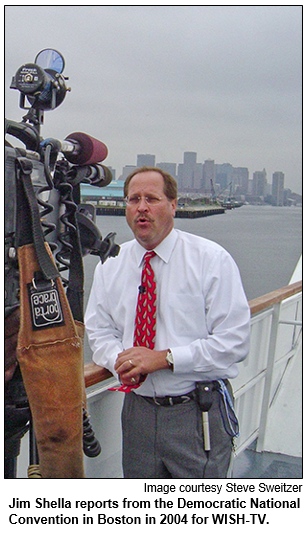 (Nov. 26, 2016) - For 34 years, beginning when Robert Orr was governor of Indiana and Bill Hudnut was mayor of Indianapolis, he has been part of the political press corps.
(Nov. 26, 2016) - For 34 years, beginning when Robert Orr was governor of Indiana and Bill Hudnut was mayor of Indianapolis, he has been part of the political press corps.
After covering the election earlier this month, Jim Shella of WISH-TV/Channel 8 retired. But Jim, who also served for 25 years as the host of Indiana Week in Review on WFYI-TV/Channel 20, returns to the airwaves as our guest.
The widely acclaimed broadcasting veteran joins Nelson in studio to share insights, highlights and challenges from his long career, which was based at the Indiana Statehouse - but that stretched to all corners of the Hoosier state as he covered rallies, press conferences and other events involving political figures and those who aspired to be. He reports the most difficult event to cover was the 1992 Republican National Convention.
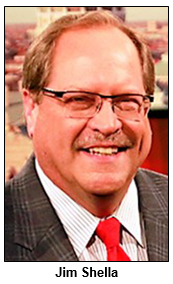 "We had no access to Dan Quayle," Jim says, referring to the then-vice president, a native Hoosier.
"We had no access to Dan Quayle," Jim says, referring to the then-vice president, a native Hoosier.
Jim Shella is a native of Minnesota. But he has been an Indiana fixture ever since December 1982, when he began at WISH by reporting about a special session of the General Assembly.
"I keep records of all the stories that I've done," Jim told Indiana Week in Review panelist John Ketzenberger for a recent story in the Indianapolis Business Journal. "In the days before computers, I would keep all the scripts."
So we will explore that trove with Jim. Asked by Nelson to identify the Indiana political figure who has been the most difficult to interview, Jim responded: "Dan Burton. I had a couple of serious run-ins with him."
Burton, a Republican, served as a U.S. congressman for 30 years, from 1983 to 2013
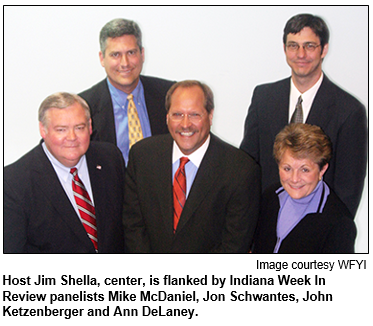 Jim Shella has had an even longer career in the spotlight. During his 34 years covering Indiana politics, he has won a stack of awards and honors; they include being named a Sagamore of the Wabash by three Indiana governors.
Jim Shella has had an even longer career in the spotlight. During his 34 years covering Indiana politics, he has won a stack of awards and honors; they include being named a Sagamore of the Wabash by three Indiana governors.
He has covered six governors and 14 national political conventions during his run on the air in Indiana, where he has reported about the state's politics longer than any other TV journalist in the state.
Jim is credited with breaking the news about the decision by then-U.S. Sen. Richard Lugar to run for president in 1996 (the campaign was short-lived); the selection of Mitch Daniels as Purdue University's president, and other major stories involving Hoosier political figures.
During our show, Nelson asks Jim for his insights about why Vigo County has chalked up an astonishing national record as a historic bellwether in presidential politics. The county in far-western Indiana has voted for the winning presidential candidate in 16 consecutive elections, dating to 1956. In fact, the county, which includes Terre Haute, has picked the winning candidate in all but two presidential elections since 1888.
Asked by Nelson to describe the biggest misconception about politics in Indiana, Jim responded: "I think there is a belief that most politicians are in it for their own good, (but) many really are public servants who do it for the right reasons."
Additional research courtesy Michael Armbruster.
History Mystery
A three-term U.S. congressman represented a district in north central Indiana beginning in 1986. A Democrat known for his advocacy of environmental issues, he represented a district that included Kokomo and Logansport.  In 1992, he was defeated in his crusade for a fourth term on Capitol Hill; two years later, he lost a statewide race for the U.S. Senate against popular incumbent Richard Lugar.
In 1992, he was defeated in his crusade for a fourth term on Capitol Hill; two years later, he lost a statewide race for the U.S. Senate against popular incumbent Richard Lugar.
The former congressman, an IU graduate, early in his career had served five terms as a state representative, then a term in the Indiana Senate. After his final defeat for public office, he moved to Oregon. He died from colon cancer in 2007 at age 55.
Question: Who was the former U.S. congressman from northern Indiana?
The prize is a pair of tickets to Handel's Messiah, courtesy of Indianapolis Chamber Orchestra. You have your choice of either the Dec. 11 regular performance at Tabernacle Presbyterian Church, or the Messiah Sing-Along on Dec. 12 at Indiana Landmarks Center. The Sing-Along is certainly not to be missed if you are a singer!
Roadtrip: 'Hub of the Universe' in Boswell
|
Guest Roadtripper and film historian Eric Grayson wants to take us is to some isolated areas in Northwest Indiana, up U.S. 41. This is a route Hoosiers took to Chicago before the interstates came in.
"Our first stop," says Eric, "is in Boswell in Benton County, which has one of my favorite sites: their water tower has a sign on it proclaiming Boswell the HUB OF THE UNIVERSE. But it's out in the middle of nowhere!
It turns out that Boswell was once a hub for the railroads, and the name stuck. Near the water tower is a beautiful restored 1910 Carnegie library.
Mealtime is a little way north on U.S. 41 in the town of Highland, Indiana, at the historic Blue Top Drive-In. Just recently restored, the Blue Top has a full complement of car hops, with typical 1950s-style food. The food is great, and the sandwiches are huge.
The Blue Top is notable for offering a free Thanksgiving dinner. And in the springtime, Highland has a nesting site where blue herons return every year.
Live from Hoosier Homecoming
200-year celebration was a live history blast
|
On Saturday, Oct. 15, 2016, Hoosier History Live transmitted our show "Live from Hoosier Homecoming" from the new Bicentennial Plaza at the Indiana Statehouse. Indiana's 200-year anniversary party offered up some great live interviews, including:
- Perry Hammock, director of the Indiana Bicentennial Commission.
- Mark Newman, state tourism director.
- Jessica Robertson, state Director of Administration.
- Lewis Ricci, Indiana Arts Commission director.
- A host of torch bearers and historic re-enactors from around the state.
We were proud to participate in and document the historical opening of Bicentennial Plaza and associated events. Our day's challenges - always multitudinous when doing a live remote - included navigating through Secret Service-secured areas due to the current vice-presidential campaign of Indiana Gov. Mike Pence.
Big thanks to Henri Pensis, program director at WICR, who ran the "on location" board as host Nelson Price conducted live interviews. Thanks also to Hoosier History Live's own Garry Chilluffo and Molly Head for "corralling" guests for the live show.
Live from Hoosier Homecoming - Just click to listen!
|
Hampton Sisters, other families in Indy jazz history
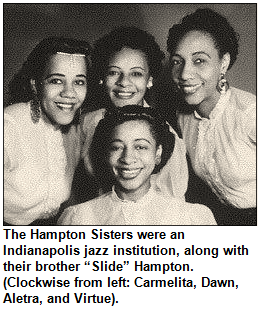 (Nov. 19, 2016) - With the recent death of the last of the beloved Hampton Sisters, we explore a parade of Hoosier families who made an impact - either by performing together or as individual acts - during the heyday of the jazz scene on Indiana Avenue or elsewhere in the state and beyond.
(Nov. 19, 2016) - With the recent death of the last of the beloved Hampton Sisters, we explore a parade of Hoosier families who made an impact - either by performing together or as individual acts - during the heyday of the jazz scene on Indiana Avenue or elsewhere in the state and beyond.
Dawn Hampton, who was 88 years old when she died in New York City in September, not only had famous sisters. (In addition to Dawn, who played the saxophone for many years, the Hampton Sisters included Aletra, Virtue and Carmelita.) Their brother, Slide Hampton, is a two-time Grammy Award winner and one of the most famous trombonists in the world.
To share insights about the Hamptons and other families in jazz music history, Indianapolis-based author and music historian David Leander Williams is Nelson's studio guest.
 A graduate of Attucks High School who grew up near Indiana Avenue, David Leander Williams is the author of the acclaimed book Indianapolis Jazz (The History Press, 2014). It explores "the rise and fall of Indiana Avenue" and features profiles of the Hampton Sisters and other influential families.
A graduate of Attucks High School who grew up near Indiana Avenue, David Leander Williams is the author of the acclaimed book Indianapolis Jazz (The History Press, 2014). It explores "the rise and fall of Indiana Avenue" and features profiles of the Hampton Sisters and other influential families.
David's book has introductions written by Slide Hampton (his real first name is Locksley) and David Baker, the famous jazz cellist, composer and educator who died last March.
Music performed by the Hampton Sisters - particularly their flavorful rendition of Route 66 - frequently is played on WICR-FM (88.7).
"These siblings dominated the music scene on the Avenue in the 1940s and '50s," David writes of the Hampton Sisters. "They recorded their first 78, Hey Little Boy/My Heart Tells Me, on the Savoy Record label."
The Hamptons had moved to Indianapolis in the late 1930s when the family patriarch, Ohio native Deacon Hampton, sensed opportunities for his multitalented children. With Dawn on the alto sax, the band featured Aletra on piano, Virtue on bass and Carmelita on baritone saxophone.
They are not related to the famous bandleader Lionel Hampton, although Slide Hampton toured in Lionel's orchestra, as well as with other groups. In addition to playing the slide trombone, Slide Hampton, now 84, is an award-winning jazz composer and arranger. 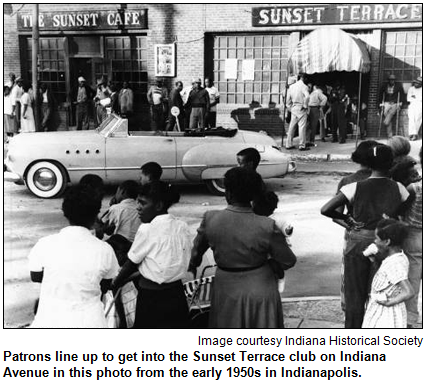 For several years, he lived in Europe, then became the artist-in-residence at Harvard University.
For several years, he lived in Europe, then became the artist-in-residence at Harvard University.
In addition to the Hampton siblings, we explore the notable families of:
- Wes Montgomery, the legendary jazz guitarist and Grammy Award winner. He died at his Indianapolis home in 1968 at age 45 just as he was preparing to tour Japan. With his brothers Monk and Buddy Montgomery, Wes released his first recording, The Wes Montgomery Trio, in 1959. In the early 1950s, Wes and his brothers - Monk was a bassist and Buddy a pianist - performed regularly on a pioneering TV show, Sentimental Journey. It was broadcast on WFBM/Channel 6, the forerunner of WRTV. Wes became internationally famous and the biggest star to emerge from the Indiana Avenue jazz scene.
- Reggie DuValle Sr., a popular bandleader during the 1910s and '20s, and his son, Reggie Jr., who played multiple instruments and taught music in the Indianapolis Public Schools system. Reggie Sr. served as a musical mentor to young Hoagy Carmichael, teaching ragtime and jazz music to the future Academy Award-winning composer. Carmichael grew up in Bloomington and Indianapolis; DuValle Sr.'s piano is now at the Indiana History Center, where it frequently is displayed.
Our guest David Leander Williams graduated from Attucks High School, then earned bachelor's and master's degrees, studying everything from African and Middle Eastern history to biology and music production. 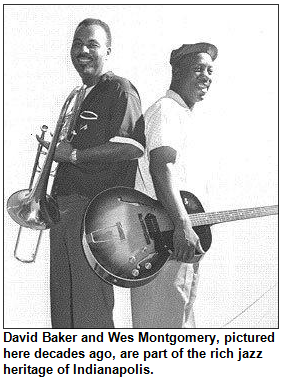 He knew many of the Hamptons, a family of 12 siblings. In Indianapolis Jazz, David notes the family was "replete with great musicians, some of whom left town and performed with leading jazz orchestras."
He knew many of the Hamptons, a family of 12 siblings. In Indianapolis Jazz, David notes the family was "replete with great musicians, some of whom left town and performed with leading jazz orchestras."
All 12 siblings played at least one musical instrument. Slide Hampton, the youngest sibling, performed with the Woody Herman Orchestra early in his career. His compositions include A Tribute to African-American Greatness, which honors icons including Nelson Mandela, Barack Obama and Oprah Winfrey.
The Hampton Sisters recorded two hits early in their career, My Heart Tells Me and Hey Little Boy, during the 1950s. Later in the 1950s, Dawn moved to New York and became a cabaret singer. Her sisters continued to be based in Indianapolis. Carmelita died in 1987. Both Aletra and Virtue died in 2007, but they still were performing concerts until a year earlier.
In addition to the Hamptons, the Montgomery brothers and the DuValles, we also explore other stars to emerge from the Indiana Avenue scene as Leonard & Leonard and the Brown Buddies. They were not family acts but almost were regarded that way. Leonard & Leonard was a dancing duo that appeared on Ed Sullivan's TV show in the 1950s and drew rave reviews during a world tour that included stops in Australia.
The Brown Buddies were a quartet of musicians, all Attucks alums. In the 1930s, they named themselves after their favorite Attucks teacher, band director Harold Brown. Dressed in tuxedos, the Brown Buddies performed with synchronized movements and, according to Indianapolis Jazz, "captivated their audiences ... in overflowing nightclubs wherever they performed."
History Mystery
For more than 30 years beginning in the early 1980s, one of the best-known personalities associated with jazz in Indianapolis wasn't a musician. He was a veteran radio personality, jazz promoter, concert organizer and music columnist for newspapers.
 On WICR-FM, he was the host for two popular weekend jazz shows until his sudden death in 2012. Before that, he could be heard on several other radio stations, including WTLC-FM and WTPI-FM. For nearly 20 years, he was the jazz columnist for NUVO Newsweekly.
On WICR-FM, he was the host for two popular weekend jazz shows until his sudden death in 2012. Before that, he could be heard on several other radio stations, including WTLC-FM and WTPI-FM. For nearly 20 years, he was the jazz columnist for NUVO Newsweekly.
During the 1970s, he became a broadcast pioneer as the first African-American TV sports director in Indiana.
Because of his contributions to jazz - which included organizing and promoting concerts as well as hosting the shows on WICR and other radio stations - he was inducted into the Indianapolis Jazz Hall of Fame.
Question: Who was the popular WICR host of jazz shows?
The prize is two tickets to the Indiana State Museum, courtesy of the Indiana State Museum.
Zionsville town history
(Nov. 12, 2016) - First and foremost, Zionsville probably is known for its Main Street, which has been lauded for decades as "quaint" and "charming."
So Hoosier History Live during this show explores the evolution of Main Street - the 1950s apparently was a pivotal era for creating a "colonial village" theme among merchants - but we also dig deeper during this program about the town in Boone County founded in the early 1850s.
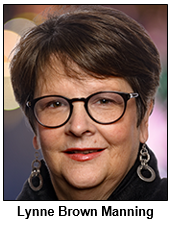 For this program in our rotating series about town and county histories across Indiana, Nelson's studio guests are Boone County historian Marianne Doyle, who lives in a Civil War-era home in Zionsville, and Lynne Brown Manning, a fourth-generation Zionsville resident who is president of the Zionsville Historical Society.
For this program in our rotating series about town and county histories across Indiana, Nelson's studio guests are Boone County historian Marianne Doyle, who lives in a Civil War-era home in Zionsville, and Lynne Brown Manning, a fourth-generation Zionsville resident who is president of the Zionsville Historical Society.
Lynne's grandmother founded the historical society; her mother was executive director of the Greater Zionsville Chamber of Commerce for part of the era when the business revival - known as the "miracle on Main Street" movement - unfolded.
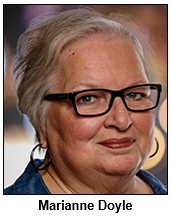 According to Marianne, the town's current population is 28,224. The area primarily was farmland and wilderness prior to the mid-1800s, when promoters of a railroad between Indianapolis and Lafayette encouraged settlement.
According to Marianne, the town's current population is 28,224. The area primarily was farmland and wilderness prior to the mid-1800s, when promoters of a railroad between Indianapolis and Lafayette encouraged settlement.
Railroad promoters included William Zion, an early settler and businessman in Lebanon (who became the new town's namesake, even though he never lived in the village) and landowners Mary Hoover Cross and her husband, Elijah Cross. Zionsville became a stop for trains, with tracks initially located right on Main Street.
Prior to the railroad, the building of Michigan Road was a key factor in the evolution of Boone County and Zionsville. (During a show last month about early Indiana roads, we explored the heritage of Michigan Road. Expect a more localized look in this program.) An early village along the Michigan Road in Boone County - known as Eagle Village - was the forerunner of Zionsville, according to our guest Marianne Doyle.
Early in Zionsville's history, the town was visited by a couple of legendary Americans:
- Abraham Lincoln spoke briefly in Zionsville en route from Springfield, Ill., to Washington D.C. in 1861 as president-elect. At a railroad depot - located on the site of what's now Lincoln Park - he spoke to town residents.
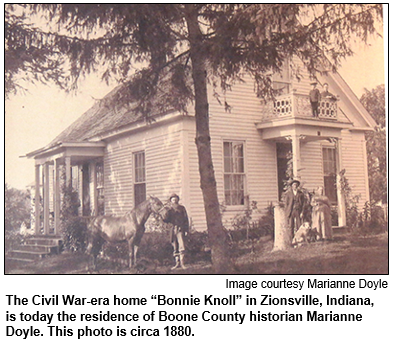 (Later during that trip, Lincoln delivered a speech in Indianapolis that made national news.)
(Later during that trip, Lincoln delivered a speech in Indianapolis that made national news.) - Susan B. Anthony, the famous suffragette, also visited Zionsville and addressed a crowd. That was at an opera house in Zionsville, which early on developed a reputation for nurturing the arts and culture. From 1891 until about 1930, a Chautauqua flourished in the town.
During our show, we also explore the impact of the interurban on Zionsville, as well as the bricking of Main Street in 1911.
Some other Zionsville heritage nuggets:
- Our guests Lynne Manning and Marianne Doyle are the co-founders of the Zionsville Little Theatre Company. Lynne also is the drama club director for Zionsville West Middle School.
- Zionsville got its first mayor in history this year. He is Tim Haak, a former banker and businessman who is a Zionsville High School grad. He was in the news recently with the unveiling of the extensively renovated headquarters of Lids Sports Group in Zionsville. Lids is the country's largest retailer of hats, particularly hats for fans of NBA, NFL and other sports teams.
- Both of our guests have served as board members of Maplelawn Farmstead in Zionsville.
Marianne Doyle has been the Boone County historian for 19 years. A native of New Albany, she began working in Zionsville in 1992 and moved to the town seven years later.
Lynne Brown Manning has worked in areas ranging from advertising and radio/TV production to non-profit management. She credits her interest in Zionsville history to her influential parents and grandparents.
Our previous town and county history shows have explored the heritage of communities from Brownsburg and Plainfield to Jennings County and Vernon. We also have explored, among others. Switzerland County, Frankfort, Tipton County, Fairmount, Wayne County and Carmel.
Additional research courtesy Michael Armbruster.
Roadtrip: Delphi
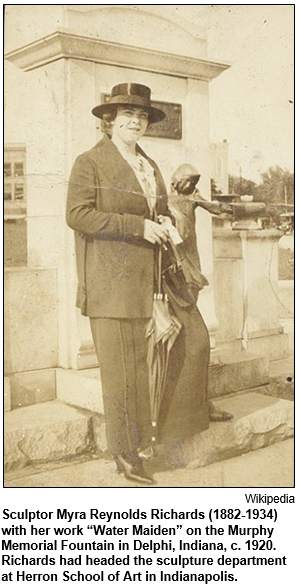 Guest Roadtripper and public historian Glory-June Greiff tells us: "I know I've taken you to Delphi before, around five years ago, but so much is going there, we're going back!"
Guest Roadtripper and public historian Glory-June Greiff tells us: "I know I've taken you to Delphi before, around five years ago, but so much is going there, we're going back!"
Along the preserved stretch of the Wabash and Erie Canal, it seems there is something new every week, Glory says. "The Canal Interpretive Center is an amazing small museum; all along the canal are rehabbed historic buildings and replicas to help interpret the full story of the canal, not to mention several bridges that have been rescued from miles around. If you love hiking and nature, there are numerous trails that nearly all intersect at Canal Park."
Who would have dreamed that the long-neglected 1860s Delphi Opera House could be so beautifully restored? Well, it has, and its success no doubt has been the stimulus for a number of other rehabs taking place. Downtown Delphi is looking better than it has in years!
There are certainly plenty of restaurant choices. The venerable Sandwich Shop, at 112 E. Main Street since 1945, has been remodeled in recent years but still retains its retro ambience. "It's a great little diner," Glory says.
The Stone House Restaurant & Bakery used to be in the same block on the south side of Main, but it moved to new digs last year across the street. (Note: The internet doesn't seem to have caught up with this address change.)
The Garden Gate Tea House at 101 West Franklin used to be in the Opera House building but had to move out because of the rehab going on. Not to worry; they moved to another historic building near the Opera House. Says Glory: "They have the best brownies!"
A fairly new addition to downtown Delphi's food offerings is the Blue Moose, housed in a 150-year-old building at 102 W. Main St. Have a treat of ice cream or frozen yogurt, but they also offer yummy oven-baked sandwiches and pizza.
Before leaving Delphi, don't miss the lovely sculpture "Water Maiden" on the Murphy Memorial Fountain on the southwest corner of the courthouse. "This charming little bronze girl," Glory says, "is one of my personal favorites, the work of Myra Reynolds Richards (1882-1934), who had headed the sculpture department at Herron School of Art."
History Mystery
 A nationally known artist Nancy Noel, who lives on a Zionsville farm, had a gallery in a historic building on the town's Main Street for several years. The spacious structure was built in the 1890s. After purchasing the building and doing a $1 million renovation, Nancy Noel opened her gallery in 2006.
A nationally known artist Nancy Noel, who lives on a Zionsville farm, had a gallery in a historic building on the town's Main Street for several years. The spacious structure was built in the 1890s. After purchasing the building and doing a $1 million renovation, Nancy Noel opened her gallery in 2006.
She is known for her paintings of angels, children, the Amish, and African wildlife and tribal people. Her paintings have been owned by such celebrities as the Beach Boys, Robert Redford and the late Nelson Mandela.
Her gallery on Main Street became a popular destination for visitors to Zionsville. Although Nancy Noel continues to live on her Zionsville farm, she placed the historic building on Main Street for sale in 2014 so she could move her gallery out of state.
Question: What was the original use of the historic building in the 1890s?
The prize is a gift certificate to Story Inn in Brown County, courtesy of Story Inn.
Maps of Indiana
(Nov. 5, 2016 - encore presentation) - On a map created in 1778, the name "Indiana" appears for a region that later became part of West Virginia. Other maps from the late 1700s and early 1800s reflect border disputes between Michigan, Ohio, Illinois and the Hoosier state.
During the early auto era, the first so-called "highway map" of Indiana may have been one distributed in 1919. 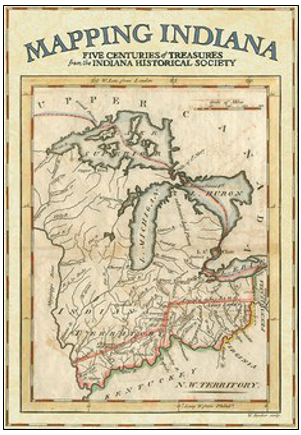 A map of Indiana's gravel roads was produced in 1895, while a bicycle route map helped 1901 travelers.
A map of Indiana's gravel roads was produced in 1895, while a bicycle route map helped 1901 travelers.
All of them are among the historic maps explored during this encore broadcast of a show from our Hoosier History Live archives (its original air date was Feb. 13, 2016). Nelson is joined in studio by two Indiana Historical Society staff members. Eric Mundell and Amy Vedra are co-authors of Mapping Indiana (IHS Press), a book that features 107 of the more than 1,700 maps in the society's collections. The maps include Old World depictions of North America, including the area that became Indiana.
"Early mapmakers often were working with unknown areas," notes Eric, a sixth-generation Hoosier who is the director of collections management at the IHS. Amy, his colleague, is a native of Griffith in northwest Indiana and the IHS director of reference services.
Among the oldest maps in the IHS collection, which spans five centuries, is one created in 1540 by Sebastian Munster, a well-known German mapmaker. Although its depiction of North America is "malformed", as Amy puts it, our guests report that the map has held up well because it, like others during the era, was created on "rag paper," a type of cloth.
In Indianapolis, early mapmakers included civic leader William Sullivan (1803-86), an engineer and surveyor who created hand-drawn "bird's-eye view" depictions of the Hoosier capital during the 1830s. Mapping Indiana also includes "bird's-eye view" depictions of such Hoosier cities as Lafayette, South Bend, Greencastle and Madison.
How to Drive to Brown County is the title of a map produced in 1918 for early motorists. The map includes "road conditions" information as it guides travelers to the isolated, hilly county then becoming known for its colony of artists that included Hoosier Group painter T.C. Steele.
Sanborn maps of cities were created for fire insurance purposes. Because they often include construction details of buildings such as their height, Sanborn maps have been extremely helpful to historic researchers.
According to our guest Eric Mundell, investors in the undeveloped region labeled "Indiana" (that later became a portion of West Virginia) on the 1778 map included Benjamin Franklin. A settlement planned for the area in the 1770s never happened.
But the word "Indiana" continued to pop up on maps of wilderness areas that eventually became parts of other states - indicating the name was being kept in mind as pioneers moved west.
Learn more:
- Mapping Indiana exhibit - Indiana Historical Society.
- Map of early Indianapolis by William Sullivan - Indiana Historical Society.
- Historic Indiana Maps - Indiana University.
Capital move from Corydon to Indy and early roads
 (Oct. 29, 2016) - Have you ever wondered how, during an October in the 1820s, all of the money in the state treasury was moved through the Indiana wilderness from Corydon, our first state capital?
(Oct. 29, 2016) - Have you ever wondered how, during an October in the 1820s, all of the money in the state treasury was moved through the Indiana wilderness from Corydon, our first state capital?
There were no Brink's armored vehicles, no Indiana State Police. And very few roads existed through the dense forest of towering trees that prevailed over much of early Indiana when the new capital city of Indianapolis was created. The site was chosen primarily for its central location as pioneers began to move north.
We explore the transport of the state's property and money in October 1824. The treasury was kept in silver during the move by a caravan of horse-drawn covered wagons. The caravan included state officials and their extended families, some of whom slept by the silver (which was in crates) to protect it during the rigorous journey.
Also during our show, we explore the creation of early roads through the wilderness to the new capital city, including a road that was crucial for the state capital's move.
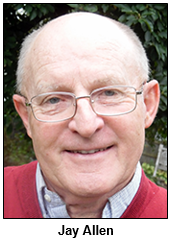 The trip from Corydon to Indy - which takes about two hours today - lasted nearly two weeks then, even with a team of horses hailed as "none finer in Indiana."
The trip from Corydon to Indy - which takes about two hours today - lasted nearly two weeks then, even with a team of horses hailed as "none finer in Indiana."
The first two roads created in the wilderness to Indianapolis were known as Mauxferry (occasionally spelled Mauckferry) Road and the Madison State Road, sometimes called "Indiana's mother roads." There's a direct connection between them and today's Madison Avenue on the south side of Indianapolis.
We also delve into the creation of Michigan Road. It was built in the 1830s to connect Ohio River towns with Indianapolis - and, eventually, to Lake Michigan.
Our guide for this time-traveling journey is Jay Allen, an Indianapolis-based historic researcher and author who owns and lives in the historic Bates-Hendricks House, which is listed on the National Register of Historic Places. The original part of the home (one of the oldest in Indy) was built in the early 1820s.
Many of the details about the move of the precious treasury have endured thanks to the sister-in-law of Samuel Merrill, the state's treasurer. His sister-in-law, Mary Catherine Anderson (later Mary Catherine Naylor), wrote a memoir that included a description of the journey, on which she was a participant. In addition to the treasury, the property that was moved included the state's printing press.
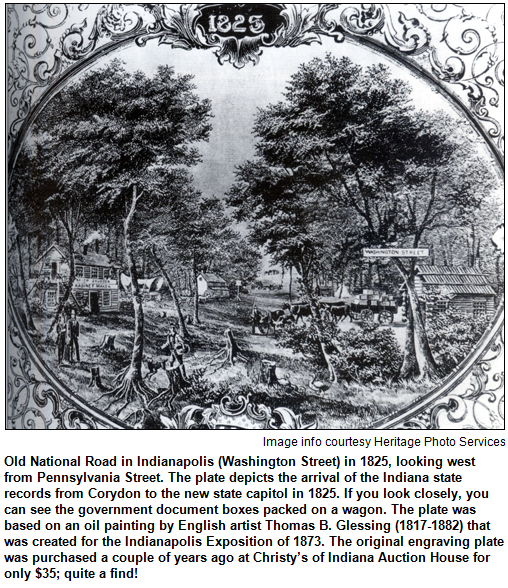 The creation of roads in the Indiana wilderness was hardly a breeze. Tall trees had to be felled, stumps removed (if possible) and muck endured.
The creation of roads in the Indiana wilderness was hardly a breeze. Tall trees had to be felled, stumps removed (if possible) and muck endured.
On previous Hoosier History Live shows, we have explored the creation of the Old National Road (now U.S. 40 in Indiana) and the Lincoln Highway in northern Indiana.
The Mauxferry Road started at the Ohio River at the town of Mauckport, then went to Corydon. Completed in 1824 to Indianapolis, the Mauxferry Road was used to move the state's treasury and property from the old capital to the new.
Madison State Road was completed the next year, connecting Madison with Indianapolis. (At that point, Madison, as a bustling river town, was much larger than the new state capital in the wilderness.)
The Mauxferry and Madison State roads met - or joined with each other - before reaching Marion County, where the "mother road" became Madison Avenue. According to research by our guest Jay Allen, construction workers doing excavations on the south side of Indy during the 1920s were startled when they discovered a pioneer wooden road under Madison Avenue.
Michigan Road, built during the 1830s and often described as "one of Indiana's earliest highways", began as a dirt path through dense forest. It eventually connected Madison and Indy with South Bend and what became Michigan City on Lake Michigan.
According to the Historic Michigan Road Association, almost all of the original route survives of Michigan Road, which opened "the state to commerce and settlement." Michigan Road goes through 14 counties and cities, including Greensburg, Logansport, Rochester and Plymouth.
Our guest Jay Allen, an Indy native, is the former president of the Indiana Photographic Society and the Bates Hendricks Neighborhood Association. He runs a grandfather clock repair company.
Learn more:
- The Removal of the State Capital to Indianapolis - Indiana Magazine of History.
- Indiana's Mother Road - Jay Allen.
- Madison State Road - Rowlandweb.
- Historic Michigan Road - Historic Michigan Road Association.
Roadtrip: Finding Home at IRT
|
Our guest Roadtripper is none other than acclaimed Indiana Repertory Theatre equity actor David Alan Anderson, who will invite listeners to the Indiana Repertory's bicentennial production Finding Home: Indiana at 200, which runs through Nov. 20. Mr. Anderson has several roles, including pieces that cover Indiana Avenue, slavery and the underground railroad, basketball and the NAACP, and Ryan White.
Finding Home: Indiana at 200 is a collaboration of more than 30 Hoosier writers. The material is split into two evenings: blue and gold; and nearly 70 percent of the content is unique.
Come hear from Madame C.J. Walker, James Whitcomb Riley and other notable Hoosiers as they tell their stories, set to live music by the Grimm Family Band.
And our own Nelson Price will be facilitating a Q&A with the audience after the Sunday, Oct. 30 matinee performance at 2 p.m. and then again after the Nov. 8 performance at 6 p.m.!
History Mystery
|
A town located on the Old National Road (U.S. 40) in eastern Indiana was founded in the 1830s. Known for its antique shops and a historic district listed on the National Register of Historic Places, the town is named after a city in England.
The eastern Indiana town has a population of about 1,900 people. It has the word "city" in its name.
Question: What is the town on the Old National Road/U.S. 40?
The prize is a Family 4-Pack to Conner Prairie, including 4 tickets to the 1859 Balloon Voyage, courtesy of Conner Prairie.
Sculpting famous Hoosiers
|
(Oct. 22, 2016) - From a fur trader of French Canadian heritage during the 1700s who established Vincennes, Indiana's oldest city, to Peyton Manning, the former Indianapolis Colts quarterback, sculptures of famous Hoosiers have been erected - or are in the process of being created - across the state.
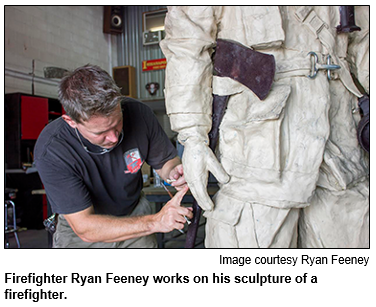 In addition to the Manning sculpture, which will stand tall and proud at Lucas Oil Stadium, and the sculpture of Francois Vincennes, notables depicted with bronze statues or other pieces of artwork include James Whitcomb Riley. A new sculpture of the Hoosier poet was dedicated earlier this month in his hometown of Greenfield.
In addition to the Manning sculpture, which will stand tall and proud at Lucas Oil Stadium, and the sculpture of Francois Vincennes, notables depicted with bronze statues or other pieces of artwork include James Whitcomb Riley. A new sculpture of the Hoosier poet was dedicated earlier this month in his hometown of Greenfield.
You can see the sculptures of aviation pioneer Weir Cook at Indianapolis International Airport and basketball icon Larry Bird at Indiana State University, his alma mater. Elsewhere across the state are sculptures honoring Hoosiers who sacrificed as law enforcement and public safety officers, as well as statues of military veterans.
Nelson is joined by three studio guests involved in the creation of many of the sculptures:
 Steve Giese, owner of Sincerus, a bronze art foundry on the eastside of Indy. The foundry works with patrons and artists - including our two other guests - to create a range of statuary and other artwork. The foundry at 6800 E. 32nd St. oversees casting, assembling and other aspects of the process. According to Steve, Sincerus is a Latin word meaning "without wax."
Steve Giese, owner of Sincerus, a bronze art foundry on the eastside of Indy. The foundry works with patrons and artists - including our two other guests - to create a range of statuary and other artwork. The foundry at 6800 E. 32nd St. oversees casting, assembling and other aspects of the process. According to Steve, Sincerus is a Latin word meaning "without wax."- Bill Wolfe, a sculptor based in Terre Haute. He created the new sculpture of the Hoosier poet - it was unveiled Oct. 8 at the James Whitcomb Riley Boyhood Home and Museum - as well as the sculptures of Larry Bird, Francois Vincennes, Weir Cook and many others.
- And Ryan Feeney, an Indianapolis firefighter and artist who was chosen to create the 10-feet-tall bronze statue of Manning that will be installed in 2017. Ryan, the owner of Indy Art Forge, also is creating the bronze statue of a firefighter that will be displayed on Massachusetts Avenue at the union hall of the Indianapolis Fire Department. (It will be a memorial to firefighters killed during a major fire at the Indianapolis Athletic Club in 1992.)
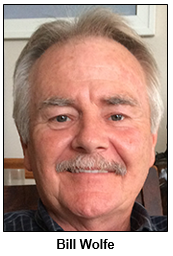 According to a recent article in the Indianapolis Star, Ryan has been poring over more than 400 photos of Manning; he was flown by Colts owner Jim Irsay to meet the retired quarterback, who led the team to a Super Bowl win in February 2007.
According to a recent article in the Indianapolis Star, Ryan has been poring over more than 400 photos of Manning; he was flown by Colts owner Jim Irsay to meet the retired quarterback, who led the team to a Super Bowl win in February 2007.
 The giant (16 feet tall) statue of "Larry Legend" created by our guest Bill Wolfe is at the Hulman Center on the Indiana State campus. Its dedication ceremony in November 2013 was attended by Bird, who grew up in French Lick and followed his astounding success at Indiana State by becoming an NBA superstar with the Boston Celtics. Since retiring as a player, Bird has been involved with the Indiana Pacers as the team's coach and, currently, as president.
The giant (16 feet tall) statue of "Larry Legend" created by our guest Bill Wolfe is at the Hulman Center on the Indiana State campus. Its dedication ceremony in November 2013 was attended by Bird, who grew up in French Lick and followed his astounding success at Indiana State by becoming an NBA superstar with the Boston Celtics. Since retiring as a player, Bird has been involved with the Indiana Pacers as the team's coach and, currently, as president.
Francois Vincennes, the namesake of the historic town in Knox County, is often considered to be the first "famous Hoosier." His father, known as the first Sieur de Vincennes, was born in Quebec and traveled to the Indiana wilderness; Francois Vincennes established a fort on the Wabash River in the 1730s that evolved into a frontier village.
Our guest Ryan Feeney has been a firefighter since 1999 and has been creating art even longer, ever since his school days in Indianapolis. Ryan is a graduate of Cathedral High School and Miami University of Ohio, where he studied sculpture and graphic design.
His sculptures include a bronze eagle at the Indianapolis 9/11 Memorial on the Central Canal. 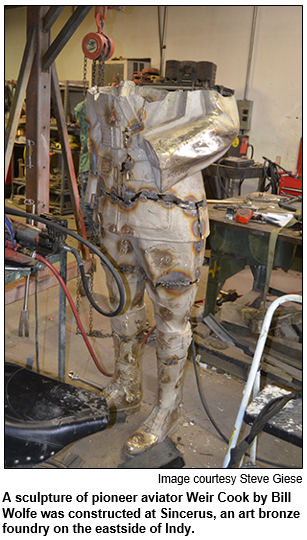 The eagle is perched atop one of two 11,000-pound bronze beams at the memorial, which was dedicated on Sept. 11, 2011, the 10th anniversary of the terrorist attacks. Ryan also created the Peace Dove sculpture that "soars" atop the atrium of the central branch of the Indianapolis Public Library; the dove was created from guns confiscated by local law enforcement agencies.
The eagle is perched atop one of two 11,000-pound bronze beams at the memorial, which was dedicated on Sept. 11, 2011, the 10th anniversary of the terrorist attacks. Ryan also created the Peace Dove sculpture that "soars" atop the atrium of the central branch of the Indianapolis Public Library; the dove was created from guns confiscated by local law enforcement agencies.
During our show, foundry owner Steve Giese explains how sculptures evolve from ideas through the finished product. According to Steve, the idea for a towering sculpture of Larry Bird was sparked when Indiana State boosters noticed a sculpture at Michigan State honoring Bird's arch-rival (and close friend) Magic Johnson. Marching orders for the Bird sculpture were to make it taller than the Johnson statue.
In addition to the sculptures of Bird, Vincennes, James Whitcomb Riley and Weir Cook (a World War I fighter pilot born in Hancock County), Bill Wolfe has created dozens of other statues across Indiana, as well as murals of famous Hoosiers. They include a mural depicting various eras in the life of Saint Mother Theodore Guerin, a pioneer Catholic nun who founded St. Mary-of-the-Woods College, orphanages and schools in the Indiana wilderness.
The mural honoring her is in the Vigo County Courthouse, where another of Bill's murals also adorns the rotunda. It's a depiction of famous Hoosiers from all walks of life (including Tony Hulman and Birch Bayh) who have connections to the county. Elsewhere in Indiana, his sculptures include the Carmel Veterans Memorial.
In Indianapolis, Ryan created the Fallen Deputy Memorial in front of the Marion County Jail. To create the high-profile sculpture of Manning, which was commissioned by the Colts, Ryan was selected over dozens of other artists from across the country.
Additional research courtesy Michael Armbruster.
Roadtrip: Rugged Martin County
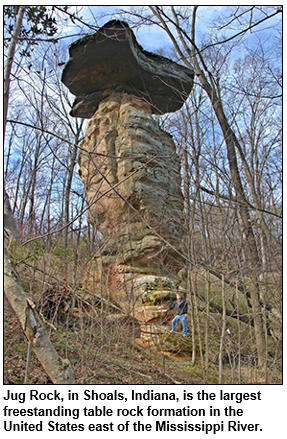 Guest Roadtripper and public historian Glory-June Greiff tells us: "Rugged Martin County is a great place to spend the day. It's got great hiking opportunities - many quite vigorous! - and lots of oddities to see."
Guest Roadtripper and public historian Glory-June Greiff tells us: "Rugged Martin County is a great place to spend the day. It's got great hiking opportunities - many quite vigorous! - and lots of oddities to see."
Scenic views and rugged hills abound at Martin County State Forest, which also has several structures built by the Civilian Conservation Corps - including a lookout tower that you are welcome to climb. What sights await you at the top!
If you're hungry after all that hiking, go into Shoals, the county seat, and stop at Velma's Diner, right downtown - downhome cooking and downhome folks.
Take a drive around the county for a variety of rock formations and historic sites. Probably the most famous is Jug Rock, a rare table rock formation, just on the edge of Shoals off Highway 50. But there are other geological wonders if you brave the winding county roads - you'll hardly believe you're in Indiana! - with names like Pinnacle Rock, House Rock, and Beaver Bluffs.
Along the way you may note amazing old structures; Martin County even sports two surviving stagecoach inns!
And of course there is the storied site of Hindostan, the first county seat. Don't believe all the wild legends; the town was once a thriving community where a major stagecoach route crossed the White River. Today the spot is renowned for fishing, but you can still see the holes in the rock where mills once stood.
After all that exploring, time for a treat - or even another meal? Says Glory: "Stop at Bo-Mac's Drive In on the east side of Shoals on US 50!"
History Mystery
|
An 8-foot bronze statue of the Catholic priest who founded the University of Notre Dame has stood on the South Bend campus for 110 years. The priest who founded Notre Dame in the 1840s - and who served as its first president - was an immigrant from a European country.
Even though Notre Dame has been associated with the Irish for generations - its sports teams are known as the Fighting Irish - the founding priest was not from Ireland.
Question: What country was he from?
The prize is a Family 4-Pack to Conner Prairie, including 4 tickets to the 1859 Balloon Voyage, courtesy of Conner Prairie.
Live from Hoosier Homecoming
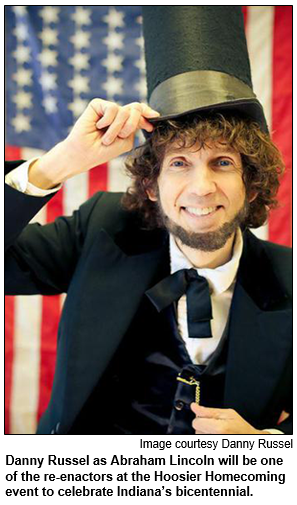 (Oct. 15, 2016) - Thousands of Hoosiers celebrated the state's 200th birthday at the debut of the Bicentennial Plaza next to the Indiana State Capitol. And Hoosier History Live was amid the hoopla at the Hoosier Homecoming for a live "remote" (on-location) broadcast as Nelson interviewed an array of attendees.
(Oct. 15, 2016) - Thousands of Hoosiers celebrated the state's 200th birthday at the debut of the Bicentennial Plaza next to the Indiana State Capitol. And Hoosier History Live was amid the hoopla at the Hoosier Homecoming for a live "remote" (on-location) broadcast as Nelson interviewed an array of attendees.
During the festivities, the Bicentennial torch arrived from its 92-county journey that began in early September in Corydon, the state's first capital.
Historic re-enactors of famous Hoosiers, top state and civic leaders, artists, food vendors and residents from across Indiana attended the Hoosier Homecoming. So did many of the 2,000 people who carried the torch during its 2,300-mile relay.
Designed and constructed at a cost of about $2 million, the Bicentennial Plaza is an outdoor public gathering space with artwork and a water element. Located just west of the Indiana Statehouse, the plaza now serves as a legacy of the state's 200th anniversary. Indiana became the country's 19th state in 1816.
Nelson's lineup of guests in this show includes:
- Perry Hammock, director of the Indiana Bicentennial Commission.
- Mark Newman, state tourism director.
- Jessica Robertson, state Director of Administration.
- Lewis Ricci, Indiana Arts Commission director.
- A host of torch bearers and historic re-enactors from around the state.
 Included in interviews was a re-enactor of "Honest Abe" Lincoln (1809-1865), whose family moved to the Indiana wilderness just before statehood was achieved. Danny Russel - in his stovepipe hat, boots and other Lincoln-like garb - participated in the festivities and shared insights on-air with Nelson.
Included in interviews was a re-enactor of "Honest Abe" Lincoln (1809-1865), whose family moved to the Indiana wilderness just before statehood was achieved. Danny Russel - in his stovepipe hat, boots and other Lincoln-like garb - participated in the festivities and shared insights on-air with Nelson.
Other historic re-enactors featured on the show included Matt Jones of Fort Wayne (who portrays Johnny Appleseed); Adrienne Provenzo of Indy (Amelia Earhart), and Lori Roberts of Harrison County (Ann Jennings, the state's first First Lady). The state's first governor, Jonathan Jennings, was re-enacted by Alex Jones of Corydon, who also was interviewed; Alex had the distinction of being the first Hoosier to light the Bicentennial torch.
During the show, Nelson also interviewed torch carriers Virginia Perry of Mooresville and Douglas Frye of Greene County. In addition , the show featured interviews with two Civil War re-enactors from Jennings County: Terry Ferguson (who portrayed Gen. Lew Wallace), and Mike Ochs of North Vernon. Harrison County resident Ann Windell, a descendant of one of the signers of the state's first constitution, also was interviewed.
Guest Perry Hammock, executive director of the Bicentennial Commission, has been a frequent Hoosier History Live guest during the last 18 months. Perry and his crew oversaw the Hoosier Homecoming.
During a guest appearance on our show in July, Hammock noted the creation of the plaza initially was planned in 1916 during the state's 100th birthday celebrations; construction never occurred, though. So instead of being a Centennial Plaza as originally proposed, the public space is now a Bicentennial Plaza - and it will serve as a future setting, officials hope, for a range of outdoor events including rallies for sports teams, concerts and festivals. Construction of the plaza began in spring of 2016.
Inspired by the Olympic torch, the Bicentennial torch was designed by a team of more than 50 engineering students at Purdue University. The torch relay project has had a budget of $1.6 million.
The relay began in Corydon. The torch was carried along U.S. 40 (the Old National Road) and to landmarks including the Indianapolis Motor Speedway, the Indiana Dunes, the Indiana Basketball Hall of Fame in New Castle and the Lincoln Boyhood National Memorial in Spencer County.
Mark Newman, director of the Indiana Office of Tourism, went out on the road with the torch. He shares insights about the relay during our show at the Hoosier Homecoming.
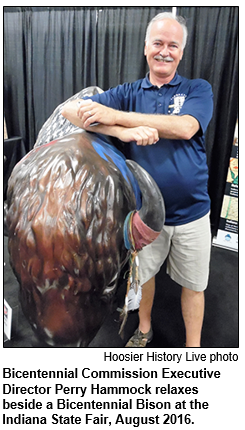 Also during the festivities, the new Statehouse Education Center and the new plaza were dedicated. Jessica Robertson, commissioner of the Indiana Department of Administration, which has been overseeing construction of both projects, was among Nelson's guests on the show.
Also during the festivities, the new Statehouse Education Center and the new plaza were dedicated. Jessica Robertson, commissioner of the Indiana Department of Administration, which has been overseeing construction of both projects, was among Nelson's guests on the show.
The Hoosier Homecoming had "family flavor," with multi-sensory, interactive activities for children. Face-painting and scavenger hunts were among them. In addition to Danny Russel as "Honest Abe," re-enactors portrayed notable Hoosiers such as Jonathan Jennings, Indiana's first governor, and Ernie Pyle, the World War II journalist who was born in the town of Dana in far-western Indiana.
The Pyle interpreter, in fact, performed a one-man show on the south steps of the Indiana State Capitol. (You can listen online to a podcast of our Hoosier History Live show about Ernie Pyle and his international impact as a war correspondent.)
Inside the Statehouse, both of Indiana's constitutions (from 1816 and 1851) were displayed in the rotunda.
Notorious murders in 1868 near White River
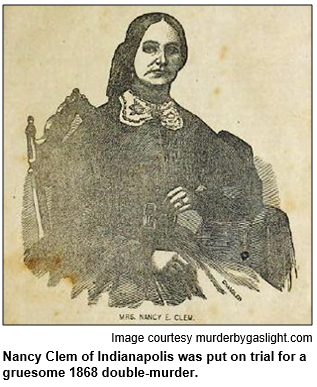 (Oct. 8, 2016) - A gruesome scene was discovered on the banks of the White River just northwest of Indianapolis in September 1868: the mutilated bodies of a married couple.
(Oct. 8, 2016) - A gruesome scene was discovered on the banks of the White River just northwest of Indianapolis in September 1868: the mutilated bodies of a married couple.
The unlikely suspect in the murders was Nancy Clem, an Indianapolis housewife and businesswoman who has been described as "the supposed originator of the Ponzi scheme." The sensational crimes, which put Indianapolis in the national spotlight, are the focus of a new book, The Notorious Mrs. Clem: Murder and Money in the Gilded Age (Johns Hopkins University Press), by Wendy Gamber, an Indiana University history professor.
Wendy is Nelson's guest to explore the social history involved with the crimes and Mrs. Clem's subsequent trials. Her prosecutors included none other than Benjamin Harrison, who in 1888 became the only U.S. president elected from Indiana.
The murders of Jacob and Nancy Young (he was killed with a shotgun, she with a pistol) drew national attention for several reasons, including the unusual suspect in the double homicide (a woman) and the rare method involved. According to Wendy Gamber, only 5 percent of women murderers in the 19th century used firearms.
 The shocking episode - with business dealings as the alleged motive - also is illuminating about, as Wendy puts it, "women's active participation in 19th-century economics." She describes Mrs. Clem as, "by turns, a farm girl, respectable urban housewife, boardinghouse keeper, street broker, supposed originator of the Ponzi scheme, peddler of patent medicines and 'female physician'."
The shocking episode - with business dealings as the alleged motive - also is illuminating about, as Wendy puts it, "women's active participation in 19th-century economics." She describes Mrs. Clem as, "by turns, a farm girl, respectable urban housewife, boardinghouse keeper, street broker, supposed originator of the Ponzi scheme, peddler of patent medicines and 'female physician'."
At one point, Mrs. Clem presented herself as a physician and sold various tonics.
According to The Notorious Mrs. Clem, her father was one of the earliest white settlers of Pike Township in Marion County. At the time of the murders in 1868, Mrs. Clem was in her mid-30s and had been married twice.
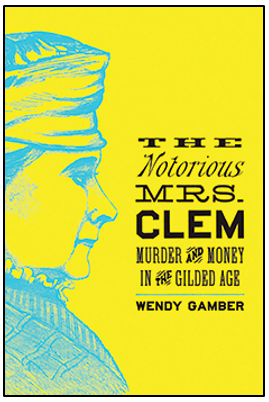 The murders were covered by one of Indiana's first woman journalists, Laura Ream, the Indianapolis-based correspondent for a Cincinnati-based newspaper. According to The Notorious Mrs. Clem, Benjamin Harrison's courtroom skills during the trials "did much to secure the future president's reputation as a brilliant attorney, a reputation that launched his political career."
The murders were covered by one of Indiana's first woman journalists, Laura Ream, the Indianapolis-based correspondent for a Cincinnati-based newspaper. According to The Notorious Mrs. Clem, Benjamin Harrison's courtroom skills during the trials "did much to secure the future president's reputation as a brilliant attorney, a reputation that launched his political career."
Nancy Clem, once the nation's best-known accused murderess, eventually was "eclipsed by others with more lasting claims to fame," our guest Wendy Gamber writes, referring to Lizzie Borden of Massachusetts. Borden stood trial for the axe murders in 1892 of her father and stepmother.
Jacob Young, one of the victims of the White River murders, had business entanglements with Nancy Clem. The wife of an Indianapolis grocer, she teamed up with Young and another entrepreneur, William Abrams, in investment scams that have been compared to modern-era Ponzi schemes.
During the late 1860s, Indianapolis was enjoying a period of explosive growth, so many residents had discretionary money, making them prey for shady investors as well as loan sharks. According to The Notorious Mrs. Clem, investors in schemes devised by Clem, Abrams and Young included "some of the city's most prominent businessmen."
The footprints of a woman and a man were discovered near the bodies of the Youngs. Their mutilated, bullet-riddled bodies were found off the banks of the White River near what is today the intersection of Cold Spring and Lafayette roads.
A series of trials of Nancy Clem ensued.
Learn more:
- Cold Spring Murders - Historic Indianapolis.
- Indy's Ten Most Notorious Crimes - Indianapolis Monthly.
Additional research courtesy Michael Armbruster.
Roadtrip: The bridges of Putnam County
 Guest Roadtripper and travel writer Jane Ammeson tells us: "While Parke County holds the honor of being the Covered Bridge Capital of the Midwest, Putnam, the county just east of Parke, also has its share of treasures."
Guest Roadtripper and travel writer Jane Ammeson tells us: "While Parke County holds the honor of being the Covered Bridge Capital of the Midwest, Putnam, the county just east of Parke, also has its share of treasures."
Jane continues: "With nine covered bridges tucked along the winding country roads just outside of Greencastle, Putnam boasts the second-biggest collection of historic covered bridges in the state. You skip a lot of traffic in Putnam County, and even better, it has the only covered bridge named after a woman, and just one of a few said to be haunted."
The Edna Collins bridge spans the slow-moving waters of Walnut Creek, and the nearby woods are still and serene. But the stories about this covered bridge and others nearby are anything but tranquil, invoking tales of restless spirits who refuse to move on.
"Almost a century ago," says Jane, "the mailman stopped at the bridge's entrance each day and honked three times. It was a signal for the young girl who lived nearby to run across the bridge to get the mail. One day the mailman sounded his horn but no one appeared. She had, he would later learn, fallen into Walnut Creek and drowned."
Now, adventure seekers stop at the Edna Collins Bridge at midnight, honking three times. And it is said that the little girl runs towards them as if to get the mail; and that just as quickly as she appears, she disappears again into the dark night.
Well, if ghost stories don't thrill you this October, remember that a delightful little Clinton Falls is just southeast down the road from Edna Collins bridge. The gurgling rapids are especially pretty this time of year.
Says Jane: "Worth the Roadtrip."
History Mystery
The banks of the White River northwest of Indianapolis was the setting for a double murder in 1868, but a positive development is unfolding elsewhere along the river - on West 30th Street.
A Naval Armory built during the 1930s - and used to train U.S. Navy radio operators during World War II - will house a new high school next fall.  A former drill hall will be converted into a gymnasium along with other changes that will enable the opening of the public charter high school. It will be the second campus for Herron High School, which is at 16th and Pennsylvania streets.
A former drill hall will be converted into a gymnasium along with other changes that will enable the opening of the public charter high school. It will be the second campus for Herron High School, which is at 16th and Pennsylvania streets.
The conversion of the landmark building on White River was the focus of Hoosier History Live show last month that also explored the re-use of a historic building in the Irvington neighborhood into a charter school.
Question: What will be the name of the new high school on the White River?
The prize is two tickets to Frightful: A Silent Halloween, a film screening of the 1920 silent version of Dr. Jekyll & Mr. Hyde at Indiana Landmarks Center on Oct. 28, courtesy of Indiana Landmarks. Organ accompaniment by Mark Herman, and expect an appearance by Sammy Terry.
All about Ben-Hur
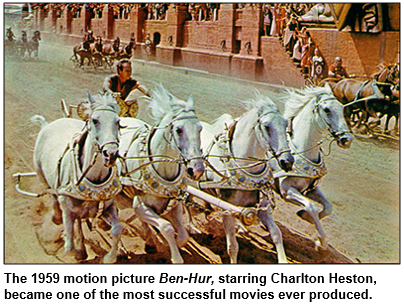 (Oct. 1, 2016) - First, it was an enormously popular novel of the 1880s written by Lew Wallace, an adventurous, flamboyant Hoosier who was a Civil War general, attorney, diplomat and politician. Many historians believe that, other than the Bible, Ben-Hur was read by more people in its era than any other book.
(Oct. 1, 2016) - First, it was an enormously popular novel of the 1880s written by Lew Wallace, an adventurous, flamboyant Hoosier who was a Civil War general, attorney, diplomat and politician. Many historians believe that, other than the Bible, Ben-Hur was read by more people in its era than any other book.
Ben-Hur also has been the basis for blockbuster movies and theatrical productions. The 1959 film version starring Charlton Heston won a then-record eleven Academy Awards.
In the wake of yet another movie remake (released in August) of Ben-Hur, Nelson is joined by three experts to explore all aspects of the cultural phenomenon associated with chariot races, the Roman Empire and slave ships.
Wallace (1827-1905), the son of Indiana's sixth governor, wrote Ben-Hur without ever having visited the Middle East - although, following his book's spectacular success, President James Garfield appointed him diplomat to Turkey. Earlier, President Rutherford B. Hayes had appointed him governor of the New Mexico Territory.
Our guests are:
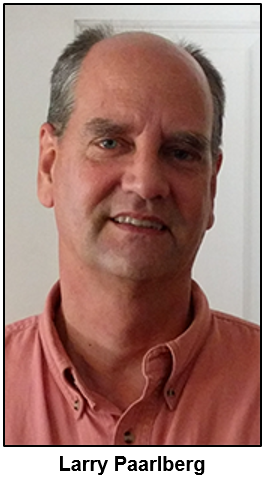 Larry Paarlberg, director of the Gen. Lew Wallace Study & Museum in Crawfordsville. In addition to housing an array of Wallace's personal possessions, the museum has artifacts from the various movie versions of Ben-Hur, including a silent film in 1925 that became one of the top-grossing motion pictures of its era.
Larry Paarlberg, director of the Gen. Lew Wallace Study & Museum in Crawfordsville. In addition to housing an array of Wallace's personal possessions, the museum has artifacts from the various movie versions of Ben-Hur, including a silent film in 1925 that became one of the top-grossing motion pictures of its era.- Chandler Lighty, director of the Indiana Historical Bureau. A native of Montgomery County, Chandler was the public historian at the Gen. Lew Wallace Study & Museum early in his career.
- And Howard Miller, an emeritus professor at the University of Texas-Austin and a renowned Ben-Hur scholar. He is working on a book about its cultural impact and will join us during a visit to Crawfordsville, Wallace's adopted hometown.
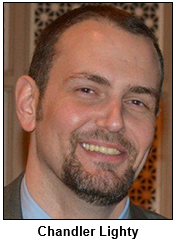 The title character in Ben-Hur is a Jewish prince who lives in Roman-occupied Jerusalem during the coming of Christ.
The title character in Ben-Hur is a Jewish prince who lives in Roman-occupied Jerusalem during the coming of Christ.
Some history facts: Wallace apparently wrote most of the novel underneath a beech tree near his Crawfordsville home; he completed it while serving as governor of the New Mexico Territory. (During his stint in the West, Wallace dealt with various gunslingers, including Billy the Kid.)
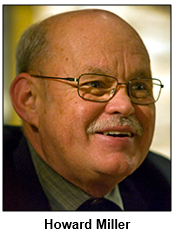 And by 1900, Ben-Hur had become the best-selling novel of the 19th century, exceeding the legendary Uncle Tom's Cabin.
And by 1900, Ben-Hur had become the best-selling novel of the 19th century, exceeding the legendary Uncle Tom's Cabin.
The subtitle of Ben-Hur is A Tale of the Christ. Set during the early Roman Empire, the novel intertwines the story of Judah Ben-Hur, a former galley slave, with the coming of Christ. In addition to chariot racing scenes, the saga involves pirates, lepers, camels, gladiators and pageantry, and historical figures.
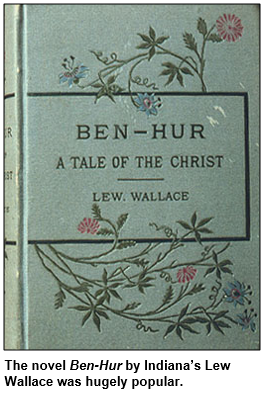 According to our guest Chandler Lighty, the recently released remake of Ben-Hur is the fifth movie version of the novel.
According to our guest Chandler Lighty, the recently released remake of Ben-Hur is the fifth movie version of the novel.
Although the 1959 epic with Heston is the best-remembered, Chandler prefers a 1925 silent movie, explaining that the earlier adaptation is closer to the book. (He also feels the chariot race is better in the 1925 version.) An even earlier film version, released in 1907, resulted in a landmark U.S. Supreme Court decision protecting "copyrighted works from unauthorized motion picture adaptation," Chandler noted in an Indiana Historical Bureau blog.
Lew Wallace was born in Brookville in southeastern Indiana in 1827. His father, David Wallace, became the state's governor in 1836. By his own account later in life, Lew Wallace was an indifferent student (a frequent truant) and a thrill seeker.
But in order to write Ben-Hur without having visited Rome or the Middle East, he became an avid reader and researcher. He is said to have benefited from, as Chandler puts it, "a boom in biblical scholarship during the era".
The epic novel was first published in 1880. A stage production of Ben-Hur first opened in New York in 1899.
Learn more:
- Ben-Hur and Lew Wallace. - Slate magazine.
Roadtrip: Genealogy Center in Fort Wayne
October is Family History Month at the Genealogy Center at the Allen County Public Library Center in Fort Wayne, Indiana. Our guest Roadtripper, author Kay Reusser of Bluffton in northeastern Indiana, will tell us more about what's going on this month.
Open seven days a week, the Genealogy Center is world-renowned for its immense collection, which includes 370,000 printed volumes, 590,000 microforms, military records that go back to the 1700s, city directories, census records, passenger lists, and so much more. And expect the staff to treat you like family, especially if you are new to genealogy!
The Genealogy Center is also active in several initiatives to make significant public domain portions of its collection available online. Learn more on Saturday.
History Mystery
 In 1902, a spectacular theatrical production of Ben-Hur was performed at a magnificent theater on Monument Circle in downtown Indianapolis.
In 1902, a spectacular theatrical production of Ben-Hur was performed at a magnificent theater on Monument Circle in downtown Indianapolis.
Audiences at the theater - which featured the largest stage then in the entire state of Indiana - were thrilled by the lavish production of Ben-Hur, particularly the chariot races scenes. They involved eight horses running on treadmills on the stage. According to a blog by our guest Chandler Lighty, the Indianapolis production in 1902 featured - in addition to the horses on treadmills - "cycloramic scenery and other apparatus."
He writes: "All of this equipment and animals imposed an estimated weight of over 50 tons on the stage, which required pouring a special cement foundation."
The ornate theater was part of a majestic opera house and hotel complex on Monument Circle. Amid public outcry, the theater, hotel and opera house were torn down in the late 1940s.
Question: What was the name of the lavish theater?
The prize is a Family 4-Pack to Conner Prairie, including 4 tickets to the 1859 Balloon Voyage, courtesy of Conner Prairie.
Landmark buildings reborn as schools
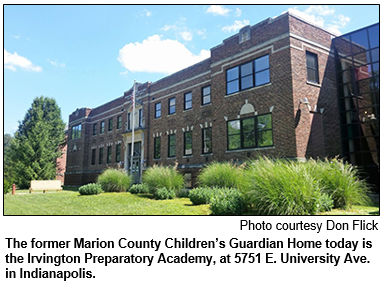 (Sept. 24, 2016) - Shaped like a ship in some ways, one building is on the banks of the White River and was used to train radio operators in the U.S. Navy during World War II.
(Sept. 24, 2016) - Shaped like a ship in some ways, one building is on the banks of the White River and was used to train radio operators in the U.S. Navy during World War II.
Another building was the home of an art institute and a gallery that preceded the Indianapolis Museum of Art.
And a third historic building housed generations of children who were abused, neglected or abandoned.
All three landmarks in Indianapolis have been - or will be - converted into charter schools.
The newest, to be called Riverside High School, is expected to open next fall in the former Heslar Naval Armory, a white Art Moderne structure built in the 1930s on West 30th Street. It will be the second campus of Herron High School, a widely acclaimed charter school that opened in 2006 on the former site of what began as the John Herron Art Institute in 1902.
In Irvington, the historic neighborhood on the east side of Indy, the former Marion County Children's Guardian Home has become the site of Irvington Preparatory Academy.
The Marion County Children's Guardian Home opened the building in 1918 for children in need of emergency shelter. (According to an article in Connections magazine, a publication of the Indiana Historical Society, an earlier structure that served as a county guardian home on the Irvington site was destroyed by a fire.)
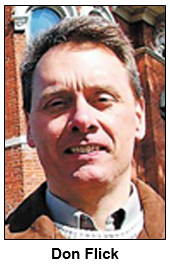 To share insights about the three landmark buildings and the process of converting them into schools, Nelson is joined in studio by three guests:
To share insights about the three landmark buildings and the process of converting them into schools, Nelson is joined in studio by three guests:
- Janet McNeal, president and head of school at Herron High, which is at 16th and Pennsylvania streets. When Riverside High School opens, she will serve as the president and head of both schools. Herron, which is attended by more than 830 freshmen through seniors, currently has a waiting list of more than 400 students. Riverside is expected to open with 200 freshmen in 2017, with another class added annually until it also serves 9th- through 12th-graders.
- Sharon Gamble, vice president for development at Indiana Landmarks, the statewide historic preservation organization that has played a key role in the planned re-use of the Naval Armory. The highly distinctive structure is 60,000 square feet and has dozens of nautical elements. They include porthole windows on interior doors, a room used to simulate conditions on a submarine, and a naval officers' barroom that will become a coffee lounge for teachers. A former drill hall will become a gym used by students at both Riverside and Herron high schools.
- And Don Flick, an Irvington-based architect who converted the Marion County Children's Guardian Home into a charter school. Don, a principal of Pyramid Architecture, also is the board president of the Irvington Historical Society. In 2010, Irvington Prep moved into the historic building after opening (with a different name) elsewhere in the neighborhood four years earlier.
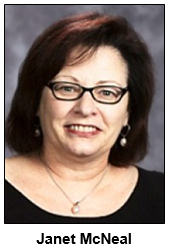 The Naval Armory trained naval officers until 2015. When radio operators were being trained in the building during World War II, "it is believed that top-secret planning for important battles occurred there," according to an article in Indiana Preservation,a magazine published by Indiana Landmarks.
The Naval Armory trained naval officers until 2015. When radio operators were being trained in the building during World War II, "it is believed that top-secret planning for important battles occurred there," according to an article in Indiana Preservation,a magazine published by Indiana Landmarks.
After World War II, the armory trained naval reservists. The building also served as a meeting space for reservists and their families.
 Many students in the new high school in the historic building are expected to come from the Riverside neighborhood, where the former armory is located. Even before the armory was built during the Great Depression, the site along the White River had distinctive uses. In the early 1900s, the Indianapolis Canoe Club was located there.
Many students in the new high school in the historic building are expected to come from the Riverside neighborhood, where the former armory is located. Even before the armory was built during the Great Depression, the site along the White River had distinctive uses. In the early 1900s, the Indianapolis Canoe Club was located there.
The beginnings of the Marion County Children's Guardian Home even predate that. An emergency shelter program for neglected, abused and abandoned children in Indianapolis was begun in 1889.
"Thousands of children went through the home's program over its 120-year history. ... For many, it was the only stable home they had ever known," according to the Connections article.
"This was a new concept. It was not an orphanage or reformatory, but a rescue program for children, initially ages newborn to 15 years, who were neglected, abused or abandoned by family or guardians."
The Connections article notes that the last child to reside at the Marion County Children's Guardian Home departed in 2009. The guardian home - now Irvington Prep - is located at 5751 E. University Ave.
At the Herron site, generations of students from across Indiana and beyond studied at what became the John Herron School of Art. Now part of IUPUI, the art school moved to the main campus - along with the Herron Gallery - before the launch of the charter school.
With a classical liberal arts curriculum, Herron High requires all students to take Latin, grammar, logic and rhetoric. U.S. News and World Report has ranked Herron in the top one percent of the country's public high schools.
So, with the waiting list, the need for a second campus has been apparent. The Naval Armory has been owned by the city since the Navy moved out. The city has been shifting ownership to Indiana Landmarks, which, in turn, will transfer the title to the high school. Herron High officials are in the midst of fund-raising for the conversion project.
Another example of the evolution planned for the Naval Armory: A mess hall - with paintings done by the WPA during the Depression - will be converted into a student cafeteria for the Riverside High School students.
Roadtrip: Thorntown, Stookey's and Serum Plant Road
Guest Roadtripper Bonnie Carter of Zionsville suggests a visit to Thorntown in Boone County, just northwest of Indianapolis. Thorntown is celebrating its Festival of the Turning Leaves this weekend. Enjoy a parade, a corn hole tournament, and a banjo and fiddle contest; all that a small Indiana town has to offer as we celebrate the coming fall season.
Hungry? Bonnie recommends Stookey's Family Dining in Thorntown for home cooking, including steaks, catfish and onion rings.
And don't forget to drive down Serum Plant Road; Bonnie became fascinated with the name of this road and did a little research. It turns out that hog cholera was a huge problem in the country a hundred years ago, and in 1916 a group of local hog breeders put together the Swine Breeder's Pure Serum Company, which had a big manufacturing plant along this road. The plant no longer exists, but Bonnie will share a little more local history on Saturday.
History Mystery
A historic structure built of limestone in downtown Indianapolis has had several vastly different uses. It opened in 1901 as a Protestant church. In the late 1940s, though, the congregation moved to the north side.
The limestone building became an educational institution, offering post-high school training. Even though the structure housed a training institution for more than 50 years, minimal alterations were made to its interior, which included a sanctuary from its decades as a church. The training institution moved out in 2003.
In recent years, the limestone structure in downtown Indy was converted into condos.
Question: Name either the church that initially was housed in the historic building or the training institution that was located in it for more than 50 years.
Hint: The historic building is near the downtown (central) branch of the Indianapolis Public Library.
The prize is a Family 4-Pack to Conner Prairie, including 4 tickets to the 1859 Balloon Voyage, courtesy of Visit Indy. Still some nice weather left in the season to soar up in the sky with this tethered balloon!
Two sensational murders in the 1920s
|
(Sept. 17, 2016 - encore presentation) - One murder case involved a bootlegger who killed his wife - and attempted to pin the crime on their chauffeur. The other case involved a woman, called a "feminine Bluebeard" by journalists in the 1920s, who poisoned her husband. Make that two husbands. She probably poisoned one of her fathers-in-law as well.
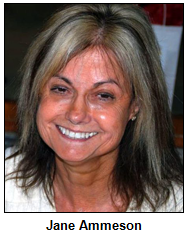 The setting for the first case during the Roaring '20s was urban: East Chicago, which was a boom town in 1923. That's when handsome bootlegger Harry Diamond shot his wife, Nettie Herskovitz Diamond, who had been a wealthy widow when she married him.
The setting for the first case during the Roaring '20s was urban: East Chicago, which was a boom town in 1923. That's when handsome bootlegger Harry Diamond shot his wife, Nettie Herskovitz Diamond, who had been a wealthy widow when she married him.
The setting for the other crimes was much more rural: Hancock County. That's where Clara Carl poisoned her husband, Frank Carl, when the couple was living in the small Indiana town of Philadelphia. She probably also poisoned Frank's father, 85-year-old Alonzo Carl, as well as her first husband, Robert Gibson.
In this encore broadcast of a show from our Hoosier History Live archives (its original air date was July 18, 2015), we explore two murder cases that drew national attention to Indiana during the early 1920s. Nelson is joined by two studio guests who have researched the lurid crimes:
- Jane Ammeson, author of A Jazz Age Murder in Northwest Indiana: The Tragic Betrayal of Nettie Diamond (The History Press). Jane grew up in East Chicago near several sites associated with the Diamond family. In fact, Jane's mother once dated the son of Nettie Herskovitz Diamond, whose past remains mysterious.
 It's unclear whether Nettie (who became a pharmacist, a rarity for women during the era) was married three or four times.
It's unclear whether Nettie (who became a pharmacist, a rarity for women during the era) was married three or four times. - Brigette Cook Jones, the Hancock County historian. Brigette began researching the Carla Carl case after inquiries from a cable TV show that broadcast a program about the murders. After the death in 1921 of Frank Carl by arsenic poisoning, the bodies of his father and Robert Gibson were exhumed. Both of them also were found to have shockingly high levels of arsenic in their systems. As a speaker about historic topics, Brigette has been doing presentations about the murders and subsequent trial of Clara Carl.
Both murder cases became "tabloid fodder," to use a phrase from Jane's book. When Nettie Diamond was shot and savagely beaten on Valentine's Day 1923 by her husband in their Hudson sedan, some newspapers described it as "the most famous murder case in the history of Lake County."
With both of the murder cases that we will explore, sensational trials followed the crimes. During the trial of Clara Carl, the Hancock County prosecutor referred to her as "rotten to the core."
Tune in to our show to hear Nelson's guests describe the eventual outcomes of both cases.
Moravian heritage of Hope, Indiana
|
(Sept. 10, 2016) - Although Columbus, Indiana, in Bartholomew County, south of Indianapolis, is known as a "Modernist Mecca" for midcentury architecture, the small town of Hope in the county's northeast Haw Creek Township has its own unique heritage.
Hope was founded in 1830 by Protestant Moravian Martin Hauser from Salem (now Winston-Salem) North Carolina. The Moravian Church had its origins in 1457 in Moravia, an area now a part of the Czech Republic. Moravians pre-dated the Protestant Reformation with breaks in belief from the Roman Catholic Church and were likewise subject to persecution.
![]() Like many groups seeking autonomy and religious freedom, Moravians moved into different parts of Europe and on to America, where they settled mostly in North Carolina and Pennsylvania. German was the language spoken by Moravians coming to America.
Like many groups seeking autonomy and religious freedom, Moravians moved into different parts of Europe and on to America, where they settled mostly in North Carolina and Pennsylvania. German was the language spoken by Moravians coming to America.
Hope was originally settled as a "congregational town" for Moravians only, with land and property being owned and managed by the church and leased to church members. Simply put, the church owned and ran the town. Somewhat similar to social experiments in New Harmony with communal property, the "congregational town" concept ended in Hope in 1837 when the town was opened up to individual property ownership, and non-Moravians also were allowed to settle there.
Some early residents of Hope were descendants of the settlers of the ill-fated Moravian Mission that operated near Anderson, Indiana, along the White River from 1801 to 1806. The mission's purpose was to bring Christianity to the Native Americans in the area. The mission members and its Native American "converts" were met with strong resistance by local tribes, and in particular by "The Prophet," the brother of Shawnee leader Tecumseh. Learn more about The Prophet's "Indian witch hunts" on the show.
 The Hope Moravian Church, founded in 1830 and originally a log cabin on the town square, remains the only Moravian Church in Indiana. Many of its traditions continue today, such as display of the "putz," or elaborate Christmas scene in miniature, in the church at Christmastime, the tradition of hanging Moravian stars, and the making of Moravian sugar cakes, a type of sweet raised coffee cake widely sold at local festivals.
The Hope Moravian Church, founded in 1830 and originally a log cabin on the town square, remains the only Moravian Church in Indiana. Many of its traditions continue today, such as display of the "putz," or elaborate Christmas scene in miniature, in the church at Christmastime, the tradition of hanging Moravian stars, and the making of Moravian sugar cakes, a type of sweet raised coffee cake widely sold at local festivals.
 The historic section of the Hope Moravian Church Cemetery is known as "God's Acre," with its first burial in 1833. Members were buried in the "choir" system, where burials are by gender, with a section for boys, unmarried men, married men, girls, unmarried women, married women and paupers. This follows the early Moravian custom of burial as done originally in Herrnhut, Germany.
The historic section of the Hope Moravian Church Cemetery is known as "God's Acre," with its first burial in 1833. Members were buried in the "choir" system, where burials are by gender, with a section for boys, unmarried men, married men, girls, unmarried women, married women and paupers. This follows the early Moravian custom of burial as done originally in Herrnhut, Germany.
Since the 1830s, Hope Moravians have also gathered in God's Acre for the Easter Sunrise Service, which includes a trombone choir and a processional by all church members that involves singing songs and watching the sun rise in the east.
This show is guest-hosted by producer Molly Head, giving Nelson time off to conduct one of his famous tours that delve into Indiana history and notable Indiana people.
Molly's guests include two retired Hope elementary school teachers who also are great storytellers: Barb Johnson and Beth Newman. Both Barb and Beth have taught 4th-grade Indiana history and also have been schoolmarms at the Simmons School, which is a brick one-room schoolhouse that was moved from its original location in the country to the "back yard" of the Hope Elementary School in 1989. And guests Barb and Beth are involved in the Yellow Trail Museum, the history museum located on the town square. Much of downtown Hope and surrounding residential areas is listed on the National Register of Historic Places.
On Sept. 17-18 in nearby Hartsville, Haw Creek Township's Bicentennial Festival will feature music, old-fashioned games for children and tours of Hartsville. The Bicentennial torch is expected to pass through Hartsville at 5 p.m. on the 18th. We also expect a call in to the show from Perry Hammock, executive director of the Indiana Bicentennial Commission. And don't forget to call in with your questions and comments at (317) 788-3314.
Roadtrip: Meet Col. Eli Lilly
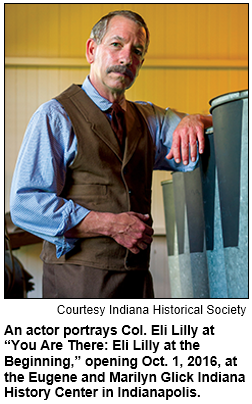 Guest Roadtripper Rachel Hill Ponko of the Indiana Historical Society says she is learning all about Eli Lilly and Company's strong Hoosier ties.
Guest Roadtripper Rachel Hill Ponko of the Indiana Historical Society says she is learning all about Eli Lilly and Company's strong Hoosier ties.
"I'm not a native Hoosier," says Rachel. "While there's no denying Eli Lilly and Company is a household name, I didn't realize this successful, multinational corporation got its start just blocks away from where I've lived and worked for the past few years."
Today, a plaque marks the site where Colonel Lilly (the "first" Eli Lilly; his grandson also had the same name) opened his original laboratory on Pearl Street in Indianapolis in 1876. Visitors can use their imagination to envision the small two-story red-brick building in the early days of the city's wholesale district.
On Saturday, Oct. 1, visitors to the Eugene and Marilyn Glick Indiana History Center can take it a step further - quite literally. IHS's new exhibition, You Are There: Eli Lilly at the Beginning, will allow guests to step through an image of the storefront, projected on a fine sheet of mist, to go back in time to the company's second year of operation. Guests will meet actors portraying characters from the company's past, including Eli Lilly and several of his first employees, as they toil in the drug-making business.
"Construction on the exhibit is well under way," says Rachel. "What I'm most excited about, though, is the opportunity to pull back the curtain on the man behind the business. Visitors will learn how Colonel Lilly overcame several challenges in his personal life and career to reach his eventual success."
History Mystery
In addition to Hope's unique Moravian heritage, the town holds the distinction of having a "first" that is related to the U.S. Postal Service.
Question: What is that distinction?
Hint: There is a tiny "museum" dedicated to this distinction on Hope's town square.
The prize is a gift certificate to the fish fry at the Hartsville Bicentennial Celebration in Hartsville in Bartholomew County on Sept. 17-18, courtesy of our guests, and a gift certificate to Story Inn in Brown County, courtesy of Story Inn.
Ask Nelson - and Bob Hammel, too
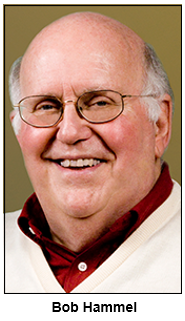 (Sept. 3, 2016) - A few times every year, Hoosier History Live opens the phone lines so listeners can inquire about any aspects of our state's heritage.
(Sept. 3, 2016) - A few times every year, Hoosier History Live opens the phone lines so listeners can inquire about any aspects of our state's heritage.
On these shows our host, Nelson Price, is joined by a media colleague who serves as a co-host. This time, Nelson is joined by a fellow author/journalist. Bloomington-based Bob Hammel, who has been inducted into the Indiana Journalism Hall of Fame, is well known across the state - and not just because of his long career as a sportswriter and as a close friend of Bob Knight, the former Indiana University coach.
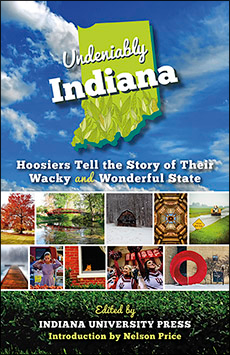 In recent years, Bob Hammel has written biographies of Bill Cook, the billionaire entrepreneur, philanthropist and historic preservationist who was described as the richest man in Indiana when he died in 2011. During our show, Bob asks Nelson about two new books - both published and endorsed by the Indiana Bicentennial Commission - in which our host has been involved.
In recent years, Bob Hammel has written biographies of Bill Cook, the billionaire entrepreneur, philanthropist and historic preservationist who was described as the richest man in Indiana when he died in 2011. During our show, Bob asks Nelson about two new books - both published and endorsed by the Indiana Bicentennial Commission - in which our host has been involved.
They include Undeniably Indiana, the first-ever "crowd-sourced" book published by IU Press. Nelson has written the introduction for the book, which features vignettes and anecdotes about (as well as photos of) Indiana submitted by dozens of Hoosiers. Topics range from Hoosier cuisine and bygone drive-in restaurants to the state's unpredictable weather and Carmel's fame as the country's "roundabout capital."
The other new book is So You Think You Know Indiana? (Newspapers in Education), an illustrated collection of articles Nelson has written for young readers about various aspects of the state's heritage.  Copies of the book - which includes sections focusing on Native Americans, misconceptions about Indiana and our often-quirky pattern of place names - will be donated to every elementary school in the state.
Copies of the book - which includes sections focusing on Native Americans, misconceptions about Indiana and our often-quirky pattern of place names - will be donated to every elementary school in the state.
Primarily, though, the show is an opportunity to call in and ask questions of the co-hosts.
Between phone calls from listeners, Nelson asks co-host Bob Hammel about the influential Hoosier who was the focus of two of his most recent books, The Bill Cook Story: Ready, Fire, Aim! (IU Press, 2008) and The Bill Cook Story II: The ReVisionary (IU Press, 2015.) Bill Cook and his wife, Gayle, launched a Bloomington-based medical equipment business (they began by assembling catheters in their spare bedroom) that evolved into what's now The Cook Group.
Of course, Nelson also asks Bob Hammel to share insights about Bob Knight - Bob Hammel was the co-author of the controversial coach's autobiography, Knight: My Own Story (St. Martin's Press, 2003) - as well as other athletes, coaches and public figures he has covered.
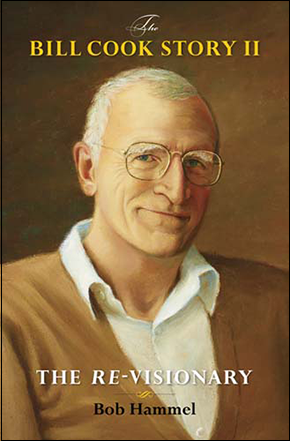 Although Bob is best-known for his 30-year career as a sportswriter and columnist at The Bloomington Herald-Times, he has worked for media in many other Indiana cities. A native of Huntington, Bob has written for newspapers in Fort Wayne, Peru and Kokomo, among others.
Although Bob is best-known for his 30-year career as a sportswriter and columnist at The Bloomington Herald-Times, he has worked for media in many other Indiana cities. A native of Huntington, Bob has written for newspapers in Fort Wayne, Peru and Kokomo, among others.
Residents of those cities also contributed to Undeniably Indiana. Not only does the book feature an introduction by Nelson, several Hoosier History Live guests are among the contributors.
They include Allen County historian Tom Castaldi, who shares details about yuletide decorations in Fort Wayne, Ray Boomhower of the Indiana Historical Society and Bluffton resident Kayleen Reusser, who writes about her first job as a teenage waitress in a restaurant beloved for its sugar cream pie. Other contributors - and Hoosier History Live guests - include Frankfort resident Janis Thornton; Tom Spalding, who writes about chimney sweeps; and Indiana Department of Natural Resources botanist Michael Homoya, who shares insights about a wildflower found only in Indiana.
Nelson's other books include Indiana Legends: Famous Hoosiers from Johnny Appleseed to David Letterman (Hawthorne Publishing, 2005), which features profiles 160 historic and contemporary notables; The Quiet Hero: A Life of Ryan White (Indiana Historical Society Press, 2015), and Indianapolis Then and Now (Pavilion Books), a visual history of the Hoosier capital. An extensively revised edition of Indianapolis Then and Now was published earlier this year; Nelson's collaborators on the book are his co-author, Joan Hostetler, and photographer Garry Chilluffo.
Our show's co-host Bob Hammel traveled extensively during his Bloomington-based newspaper career. He was in Munich for the 1972 Summer Olympics when IU swimmer Mark Spitz won a then-record seven gold medals; Bob also covered the 1996 Atlanta Olympics.
In 1968, he was in Pasadena for IU's only appearance in the Rose Bowl; he also covered the NCAA championships won in 1976, 1981 and 1987 by IU's basketball teams coached by Knight. So listeners are invited to phone in during our show and ask about any of those historic events.
Roadtrip: Great old still-open theaters in Angola, Indiana
|
Guest Roadtripper Eric Grayson, also known as Dr. Film, suggests going to parts of Angola in northern Indiana that you probably never noticed before.
"Angola is famous for its car auctions and museums, but I'm a film historian, and there's something really cool in Angola," Eric tells us. "The Strand and the Brokaw (at the intersection of U.S. 20 and U.S. 127) are two historic movie theaters on the main square of the city, both of which are still open!"
Eric says this may be the only place in Indiana where you can find two historic movie theaters in the same block that both are still open.
Says Eric: "The Brokaw has just been restored and is in beautiful shape. (I haven't been in it since the restoration.) It's a 1931 Art Deco theater designed by architect Alvin M. Strauss."
He continues: "The Strand is still operating much as it ever has been. It's an older building, but the theater has been remodeled in an Art Deco style. If you get a chance to go in, the projection booth is really tiny; you can see it from the concession stand."
The Strand is one of the few theaters in Indiana still running real movie film, as opposed to digital. The owner has a cool collection of memorabilia.
"For lunch, just around the corner from the Strand is Sutton's Deli," says Eric, "which has always been closed when I've been there, but is a place I want to try."
History Mystery
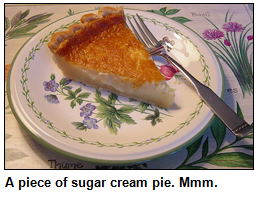 Both of the two new books to which our host Nelson Price has contributed - Undeniably Indiana and So You Think You Know Indiana? - include references to sugar cream pie.
Both of the two new books to which our host Nelson Price has contributed - Undeniably Indiana and So You Think You Know Indiana? - include references to sugar cream pie.
Often marketed as Indiana's state pie, sugar cream pie has several historic connections to Hoosiers. Among them: The world's largest maker of sugar cream pie is located in a town in Indiana. The family-owned pie factory in the town ships sugar creams and other pies to customers across the country. The multi-generational family been making pies in the Indiana town for nearly 70 years.
Question: Name the Indiana town that is home to the world's largest maker of sugar cream pie.
Hint: The town is in eastern Indiana.
The prize is two tickets to the Hoosier Hops and Harvest Craft Beer Festival in Brown County, courtesy of the Story Inn, and a gift certificate to Iozzo's Garden of Italy restaurant, courtesy of Iozzo's.
History of police training in Indiana
 (Aug. 27, 2016) - Our guest is attorney and WICR-FM colleague Charles Braun, who has been training police officers on every level of law enforcement - from Indiana State Police officers to those on town and city forces across the state - for 39 years.
(Aug. 27, 2016) - Our guest is attorney and WICR-FM colleague Charles Braun, who has been training police officers on every level of law enforcement - from Indiana State Police officers to those on town and city forces across the state - for 39 years.
A popular instructor for decades at the Indiana Law Enforcement Academy in Plainfield, Charles is the host of Legally Speaking, the longest-running legal advice show on American radio.
During his distinguished career, Charles, a history lover and Fort Wayne native, has extensively researched the evolution of police training in Indiana since the 1800s.
During our show, he describes the law enforcement scenario during the 1800s when many untrained citizens - akin to vigilantes - offered to help local law enforcement. Sometimes their offers were accepted - and sometimes major problems resulted.
"Prior to ... 1972, anyone could become a police officer in Indiana," Charles says. He notes that "Old West-style posses and bounty hunters" still can be formed in the state.
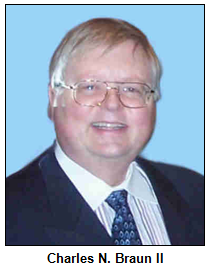 According to Charles, Indiana's two state constitutions - the first in 1816, the second in 1851 - established the elected office of county sheriff across the state. But the constitutions included few requirements for those seeking the post.
According to Charles, Indiana's two state constitutions - the first in 1816, the second in 1851 - established the elected office of county sheriff across the state. But the constitutions included few requirements for those seeking the post.
Among the courses Charles has taught to state, city and other police officers are classes on interpersonal communications. Beyond that, he played a key role in developing basic training, as well as in developing continuing education of Indiana's law enforcement officers.
So who better to share insights on this timely history topic?
As a history enthusiast, Charles' interests include the origins of county names across Indiana. He has joined Nelson on two previous Hoosier History Live shows - in May 2013 and September 2010 - to share insights about that topic.
 He launched Legally Speaking in 1983. The call-in legal advice show airs at 11 a.m. Saturdays on WICR 88.7 FM in Indianapolis.
He launched Legally Speaking in 1983. The call-in legal advice show airs at 11 a.m. Saturdays on WICR 88.7 FM in Indianapolis.
According to the "How we began" section on the Indiana State Police website, the agency dates to the formation in the 1920s of the Indiana Motor Vehicle Police. During the early automobile era, "criminals soon took advantage of the power and speed of the 'horseless carriage' as a means of quick escape after committing their crimes," the history notes. "Once they crossed county lines, the local sheriff had no jurisdiction in the neighboring counties, thus criminal apprehension was extremely difficult."
The motor vehicle police became the first Indiana agency to have statewide jurisdiction to enforce traffic laws. During the Great Depression, the agency was consolidated with other state departments and its law enforcement powers broadened, resulting in the Indiana State Police.
Many current Indiana State Police officers - as well as other law enforcement officers - have received some of their training from Charles Braun, who is a master law enforcement instructor. He notes that the Indiana Department of Correction has its own police force. Private colleges and universities in Indiana also can form their own police departments.
Even cemeteries in Indiana, Charles adds, can operate their own police departments.
Learn more:
- National Law Enforcement Museum.
- Indiana State Police.
- Living in "Wild West": Valley was hot area for notorious desperadoes - Mike McCormick, "Historical Perspectives" column in the Terre Haute Tribune Star, Jan. 11, 1998, about pursuit of the Birch-Fox-Long gang by bounty hunter Edward Bonney in 1845.
Roadtrip: Richmond's Depot District and more
|
Guest Roadtripper Jake Oakman suggests a Roadtrip to the Richmond Depot District, where historic renovation, walkability and commercial vitality come together. Richmond is east of Indianapolis along the Old National Road. The historic city is in Wayne County, which was established in 1811 in the Indiana Territory, several years before Indiana achieved statehood in 1816.
The Depot District in downtown Richmond includes the Pennsylvania Railroad Depot, which was built in 1902 by Daniel Burnham, the Model T Museum, and Firehouse BBQ and Blues. You can also check out the Gennett Records Walk of Fame and the Levi Coffin House in Fountain City, the "Grand Central Station on the Underground Railroad." You can also visit Warm Glow Candles and follow the Chocolate Trail!
Learn more on Saturday!
History Mystery
A tragedy in 1963 involved the most emergency response vehicles - ambulances, police squad cars, fire trucks and other vehicles - in Indiana history.
The horrific event happened in Indianapolis. Casualties included 74 deaths and nearly 400 injuries. Emergency response and law enforcement teams from many agencies responded to help with the crisis.
Question: What was the tragedy in 1963 that necessitated so many emergency response vehicles?
Hint: The tragic event occurred on a holiday.
The prize is two admissions to the Tavern on South in downtown Indy, courtesy of Visit Indy, and two tickets to the Hoosier Hops and Harvest Craft Beer Festival in Brown County, courtesy of the Story Inn.
Calvin Fletcher, first major Indianapolis civic leader
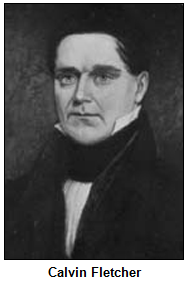 (Aug. 20, 2016) - He left his family's home in Vermont at age 17 and eventually, nearly penniless, made his way to Indianapolis in 1821 just as the new state capital was getting under way.
(Aug. 20, 2016) - He left his family's home in Vermont at age 17 and eventually, nearly penniless, made his way to Indianapolis in 1821 just as the new state capital was getting under way.
From that inauspicious start, Calvin Fletcher (1798-1866) became an attorney. A wealthy banker. A farmer and major landowner. A state legislator. And the first major civic leader in his adopted hometown.
Not to mention an abolitionist and the writer of an extensive diary that, since its publication in nine volumes by the Indiana Historical Society, has been a trove for anyone seeking insights about daily life in early Indianapolis.
 Fletcher's name has come up during many previous Hoosier History Live shows. They have ranged from a program in December 2014 that explored the evolution of outreach to families and children (during the 1830s, Fletcher helped found the city's first social service organization, which then was known as the Indianapolis Benevolent Society) to a program about the notorious Massacre at Fall Creek. (As an influential attorney, Fletcher was brought in to represent some of the white men accused of slaughtering Native Americans in Madison County.)
Fletcher's name has come up during many previous Hoosier History Live shows. They have ranged from a program in December 2014 that explored the evolution of outreach to families and children (during the 1830s, Fletcher helped found the city's first social service organization, which then was known as the Indianapolis Benevolent Society) to a program about the notorious Massacre at Fall Creek. (As an influential attorney, Fletcher was brought in to represent some of the white men accused of slaughtering Native Americans in Madison County.)
So isn't it time for us to explore the colorful life of the self-made early power broker whose name continues to live on nearly 200 years after he first showed up in Indy? The Fletcher Place Neighborhood on the near-Southside is on the former site of its namesake's 269-acre farm. On Virginia Street in that neighborhood, Calvin Fletcher's Coffee Company is just one of the other ways his legacy continues.
To explore the life and impact of Calvin Fletcher - as well as those of some descendants and members of his extended family - Nelson is joined by two guests:
- Daniel Blake Smith, the St. Louis-based author of a new book about the Calvin Fletcher and his family, Our Family Dreams: The Fletchers' Adventures in Nineteenth-Century America (St. Martin's Press). Dan, who also is a screenwriter and former American history professor, recently gave a presentation about his book at the Eugene and Marilyn Glick Indiana History Center in Indianapolis.
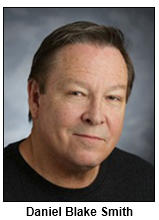 And Georgia Cravey, an Indianapolis-based historic researcher and scholar who lives in a historic home in Fletcher Place. A former reference librarian for the Indianapolis Public Library, Georgia was one of our guests on a show in November 2014 about the kidnapping of free blacks in early Indiana.
And Georgia Cravey, an Indianapolis-based historic researcher and scholar who lives in a historic home in Fletcher Place. A former reference librarian for the Indianapolis Public Library, Georgia was one of our guests on a show in November 2014 about the kidnapping of free blacks in early Indiana.
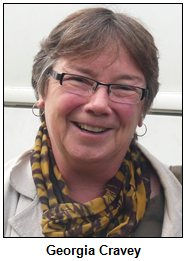 According to the Indiana Historical Society, Dan Blake Smith uses Fletcher's diary - as well as the family's letters, which also are found in IHS collections - "to demonstrate (that) the Fletchers dream, fret, fight and love in a way that is similar to many American families today."
According to the Indiana Historical Society, Dan Blake Smith uses Fletcher's diary - as well as the family's letters, which also are found in IHS collections - "to demonstrate (that) the Fletchers dream, fret, fight and love in a way that is similar to many American families today."
Calvin Fletcher began his diary before he left Vermont, where his father, Jesse, had a "hardscrabble farm" and "struggled with debt and depression," as Dan Blake Smith puts it in Our Family Dreams. Calvin Fletcher continued writing his diary until days before his death.
During the Civil War, Calvin Fletcher supported the formation of the 28th Regiment U.S. Colored Troops, an infantry of African Americans from Indiana. As our guest Georgia Cravey describes during our show, the recruits trained at Camp Fremont, which was set up on Fletcher's land.
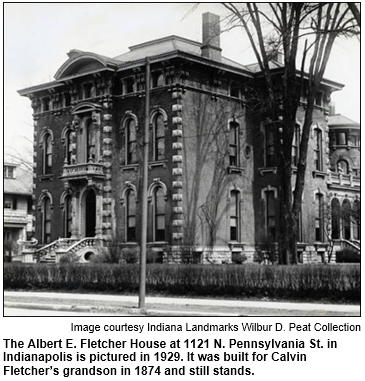 Georgia also describes the vast expanse of Fletcher's land holdings, which included much of Brookside Park on the eastside of Indy, as well as Fletcher Place. In Our Family Dreams, Dan Blake Smith notes that in 1834 Fletcher even bought 1,200 acres in LaPorte County," launching a long career of mostly profitable land speculation."
Georgia also describes the vast expanse of Fletcher's land holdings, which included much of Brookside Park on the eastside of Indy, as well as Fletcher Place. In Our Family Dreams, Dan Blake Smith notes that in 1834 Fletcher even bought 1,200 acres in LaPorte County," launching a long career of mostly profitable land speculation."
Nelson and his guests also explore Fletcher's staunch religious beliefs. According to Georgia, he instructed a daughter that reading novels was unseemly; he also made his sons return money and retrieve a horse they had sold on the Sabbath. Calvin's close friends included Rev. Henry Ward Beecher, then the pastor at Second Presbyterian Church - and later a nationally influential preacher based in New York
Calvin Fletcher became the first practicing attorney in Indianapolis and helped organize Indiana's first state bank.
His first wife, Sarah Hill Fletcher, also kept a diary; they had had 11 children. After Sarah's death in 1854, Fletcher married his second wife, Keziah, a teacher who, like most of the Fletchers, highly valued education.
When Fletcher died in 1866, his funeral cortege to Crown Hill Cemetery stretched, according to Our Family Dreams, "for nearly a mile."
Learn more:
- Historic Indianapolis, Libby Cierzniak, Indianapolis Collected: The Fall of the House of Fletcher.
Additional research courtesy of Michael Armbruster.
Roadtrip: Selmier State Forest in Jennings County
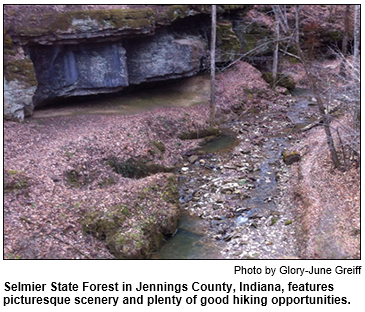 Guest Roadtripper and public historian Glory-June Greiff tells us: "Put on your hiking shoes and take a trip to Jennings County, about an hour and a half southeast of Indianapolis."
Guest Roadtripper and public historian Glory-June Greiff tells us: "Put on your hiking shoes and take a trip to Jennings County, about an hour and a half southeast of Indianapolis."
Says Glory, a longtime Indiana explorer: "A visit to the little-known Selmier State Forest, just a bit northeast of North Vernon, the county's largest town, will give you fine trails through forested lands and along the Muscatatuck River."
Break for lunch and stroll around the tiny county seat of Vernon, a very old town with lots of pre-Civil War architecture and a stunning courthouse that was built in 1859. Just northwest of the courthouse square is an impressive stone arch railroad overpass.
Vernon has some interesting restaurants for its tiny size; you might try the Log Cabin Inn on the south side of the courthouse square.
Walk off your meal at Muscatatuck County Park just on the northwest edge of Vernon on Highway 7 (between Vernon and North Vernon). Also on the Muscatatuck River, the park features a more rugged terrain plus several structures built by the Works Progress Administration, which worked on the property in the 1930s. Muscatatuck actually started out as a state park, our third, and briefly was named Vinegar Mills. Remnants of that early 19th-century mill site remain in the park.
History Mystery
Alexander Ralston, a surveyor and engineer, was hired to plan the new city of Indianapolis in the early 1820s. Previously, Ralston had helped French architect Pierre L'Enfant design Washington D.C. With his plan for Indiana's new state capital of Indianapolis, Ralston suggested the Mile Square, with a circular drive in the center.
Although he spent the rest of his life in Indianapolis after designing the city, Ralston was not a native American. He was born in another country and immigrated to the United States after the Revolutionary War.
Question: Where was Alexander Ralston born?
The call-in number is (317) 788-3314. Please do not call into the show until you hear Nelson pose the question on the air, and please do not try to win the prize if you have won any other prize on WICR during the last two months. You must be willing to give your name and address to our engineer and be willing to be placed on the air.
The prize is two admissions to the Rhythm Discovery Center, courtesy of Visit Indy, and two tickets to the Hoosier Hops and Harvest Craft Beer Festival in Brown County, courtesy of the Story Inn.
Political campaign memorabilia from Indiana history
 (Aug. 13, 2016) - With campaign season in full swing, Hoosier History Live delves into buttons, stickers, hats, bobble-heads, ribbons, tintypes or other memorabilia associated with Indiana political figures clear back to the state's earliest history.
(Aug. 13, 2016) - With campaign season in full swing, Hoosier History Live delves into buttons, stickers, hats, bobble-heads, ribbons, tintypes or other memorabilia associated with Indiana political figures clear back to the state's earliest history.
One of our guests, David Yount, a former state legislator from Columbus, owns a letter written in 1823 by Indiana's first governor, Jonathan Jennings, who by then was a U.S. congressman. Jennings wrote the letter to President James Monroe.
David, who is now a financial investment manager based in Carmel, also owns buttons from George Washington's first presidential inauguration in 1789.
Nelson also is joined in studio by Michael McQuillen, an Indianapolis City-County councilman who also has a vast collection of historic political memorabilia.
 Michael, a Republican who is the city council's minority leader, writes about antiques and collectibles for publications such as Antique Week and Collectors' Classified. With his wife Polly, he buys, sells and appraises political memorabilia and other collectibles at politicalparade.com.
Michael, a Republican who is the city council's minority leader, writes about antiques and collectibles for publications such as Antique Week and Collectors' Classified. With his wife Polly, he buys, sells and appraises political memorabilia and other collectibles at politicalparade.com.
 With Michael and David, we share insights about hunting for rare finds, the value of political collectibles and the range of promotional products that have touted Hoosier politicians for 200 years. Specialties of both of our guests include memorabilia related to Indiana's governors.
With Michael and David, we share insights about hunting for rare finds, the value of political collectibles and the range of promotional products that have touted Hoosier politicians for 200 years. Specialties of both of our guests include memorabilia related to Indiana's governors.
Michael's specialties also include the 1940 presidential campaign of Wendell Willkie (the Elwood native lost to FDR) and the campaigns of Dan Quayle, as well as memorabilia related to the World War II homefront and the Indiana State Fair.
The array of memorabilia touting political campaigns during the 1800s and early 1900s went far beyond traditional posters. Our guest David Yount has a clothes brush promoting the 1840 U.S. presidential campaign of William Henry Harrison, who was Indiana's first territorial governor earlier in his career. (Memorabilia associated with William Henry Harrison also is among David's specialties.)
Rare campaign memorabilia are permanently displayed in the historic home associated with Harrison's grandson, the Benjamin Harrison Presidential Site in Indianapolis.
In Logansport, Julian and Sue Ridlen own theMuseum of American Political Communication. The two-story museum, which may be visited by appointment, has an extensive collection of memorabilia - some dating to the 1790s - of everything from soap and sheet music to T-shirts and license plates.
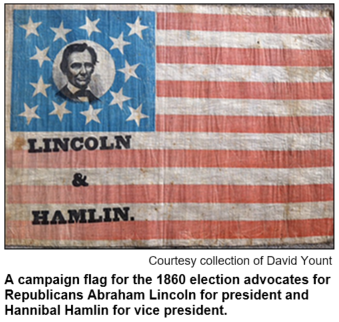 Our guest Michael McQuillen, who is regional vice president of the American Political Items Collectors, has had his memorabilia collection featured on national and local TV. His collection even includes, as he puts it, "3D items" such as glassware, lighters and other novelties.
Our guest Michael McQuillen, who is regional vice president of the American Political Items Collectors, has had his memorabilia collection featured on national and local TV. His collection even includes, as he puts it, "3D items" such as glassware, lighters and other novelties.
Because our guest David Yount also collects Indiana State Fair memorabilia, we explore that timely aspect, as well as political artifacts.
In addition to owning a letter written by Jennings, Indiana's first governor (who was seeking a U.S. Navy appointment for a Hoosier constituent from James Monroe), David even has a letter written by Thomas Posey, one of Indiana's territorial governors. Posey was the third governor of the Indiana Territory from 1813 to 1816.
Both of our guests buy historic Indiana memorabilia from a variety of sources, ranging from eBay to other collectors and antique shows.
Michael McQuillen, a graduate of Perry Meridian High School and the University of Indianapolis, first was elected to the Indianapolis City-County Council in 2007. He has been a licensed auctioneer since 1994; his collections also include Indiana police and fire badges.
David Yount represented the Columbus area in the Indiana House of Representatives for 10 years beginning in 1996. A graduate of Indiana University, he is the former editor of a national journal dedicated to the preservation of cultural artifacts related to Abraham Lincoln and the Civil War.
Additional research courtesy of Jeff Kamm.
Roadtrip: Shelbyville revisited
|
Guest Roadtripper John Pratt, a history teacher at Greensburg Community High School, will take us on a quick tour of Shelbyville in Shelby County; not too far southeast of Indianapolis along I-74. John will tell us about historical figures with ties to Shelbyville, including Charles Major, Sandy Allen, Thomas Major and Bill Garrett.
John's stops will include the Grover Museum and Anderson Orchard, and then we'll really step back in time with stops at the Skyline Drive-In movie theater and a visit to the Bear's Den, where your food is served by a real car hop!
History Mystery
Indiana's only First Lady, Caroline Scott Harrison, started a White House collection. The wife of Benjamin Harrison, who was elected U.S. president in 1888, was convinced that the White House had fallen into neglect and crusaded to upgrade the historic home.
As part of that, Mrs. Harrison began a collection that continues to this day in the White House. A portrait painting of Mrs. Harrison occasionally is displayed in the White House - on a rotating basis - in part because of her role with the collection of White House artifacts.
Question: What is the collection?
The prize is two admissions to the Indianapolis Zoo and a gift certificate to Tavern on South in downtown Indianapolis, courtesy of Visit Indy.
Unheralded historic Olympians from Indiana
 (Aug. 6, 2016) - As the 2016 Summer Olympics kick off in Rio de Janeiro, many links between Indiana athletes and the Olympic games are well remembered.
(Aug. 6, 2016) - As the 2016 Summer Olympics kick off in Rio de Janeiro, many links between Indiana athletes and the Olympic games are well remembered.
The gold-medal winning "Dream Team" of U.S. basketball players at the 1992 Barcelona Olympics included Larry Bird. At the 1960 Rome Olympics, Oscar Robertson was the star of the triumphant U.S. team.
Who can forget the connections between swimmer Mark Spitz, the sensation of the 1972 Munich Olympics, and Indiana University? Greenfield native Jaycie Phelps was just 16 years old when, as a member of the "Magnificent Seven" team during the 1996 Atlanta Olympics, she won a gold medal in gymnastics.
So rather than exploring those well-remembered Olympians, Hoosier History Live digs deeper. With two Indiana-based sports historians as Nelson's studio guests, we spotlight the Olympic careers and colorful lives of other Hoosiers dating back nearly to the beginning of the modern-era Olympics in 1896.
We explore Hoosiers ranging from a Lafayette track and field star believed to be the first Hoosier to compete in the Olympics - he overcame childhood polio to win gold medals at the 1900 Olympics and subsequent games - to a North Central High School graduate who was part of the U.S. women's relay team that won gold in Atlanta in 1996.
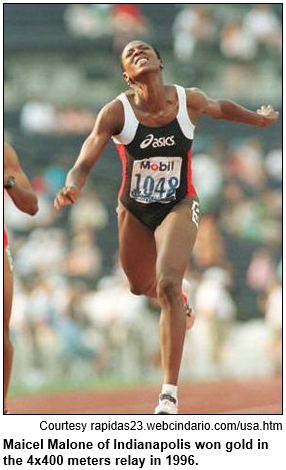 Our guests are Indianapolis-based author and sportswriter Pete Cava, a member of the International Society of Olympic Historians, and Greenwood-based journalist and TV producer Dan O'Brien. With Nelson, they explore historic Olympians, including:
Our guests are Indianapolis-based author and sportswriter Pete Cava, a member of the International Society of Olympic Historians, and Greenwood-based journalist and TV producer Dan O'Brien. With Nelson, they explore historic Olympians, including:
- Ray Ewry (1873-1937) of Lafayette, whose outstanding achievements at three Olympics during the early 1900s are often overlooked. That's in part because many of his medals came in events (like the standing broad jump and high jump) that no longer exist. Ewry contracted polio as a young boy and apparently was told he might be paralyzed for life. Even before the 1900 Olympics, he had graduated from Purdue with a degree in mechanical engineering.
- Maicel Malone, who was born in Indianapolis in 1969. After winning state championships in multiple track events as a North Central student, Malone was part of the U.S. team that won gold in the 4x400 meters relay in 1996.
- Euphrasia "Fraze" Donnelly Bungard (1905-1963), who at the 1924 Paris Olympics became the first swimmer from Indiana to win a gold medal, according to Dan O'Brien. That came for her role on a victorious relay team; the teammates of "Fraze" Donnelly, an Indianapolis native, included Gertrude Ederle, who later reaped international fame as the first woman to swim the English Channel.
- Dr. Greg Bell, a Terre Haute-born track star who won a gold medal in the long jump at the 1956 Melbourne Olympics.
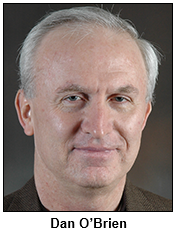 He went on to become a dentist in Logansport and even the director of dentistry at Logansport State Hospital.
He went on to become a dentist in Logansport and even the director of dentistry at Logansport State Hospital. - And Kathy Ellis, a 17-year-old swimmer from Indianapolis who was dubbed the "teenage sensation" of the 1964 Tokyo Olympics. She won four medals, including two golds, and years later was inducted into the International Swimming Hall of Fame.
If those Olympians - as well as others from Indiana whom we explore during the show - are not enough to whet your appetite, our guest Pete Cava shares insights about an astounding "drought" for the United States in a track event. 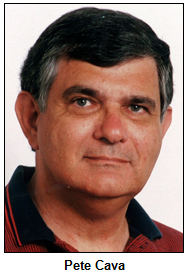 Americans have not won the 1,500 meters (the so-called "metric mile") since their championship team took home the gold in 1906. That long-forgotten team included James Lightbody, a track star who attended high school in Muncie.
Americans have not won the 1,500 meters (the so-called "metric mile") since their championship team took home the gold in 1906. That long-forgotten team included James Lightbody, a track star who attended high school in Muncie.
Modeled after games held in ancient Greece, the modern Olympics began in 1896. So Ewry, the track star from Lafayette, was competing in the second modern Olympics when he won gold medals during the 1900 games, which were held in Paris. (Athens was the site of the 1896 Olympics.)
According to several accounts, Ewry had contracted polio as a young boy and needed a wheelchair. Amid concerns he might be paralyzed for life, Ewry began exercising and became an exceptional athlete. At Purdue, he was the captain of the track and field team. After winning gold medals in various standing-jump events during a series of Olympic games, Ewry retired following the 1908 Olympics. All standing-jump events were dropped after 1912.
In men's swimming, Indiana University athletes dominated the medal stand for decades. In addition to Spitz, well-known Olympic gold medalists included Frank McKinney Jr., who became an influential Indianapolis civic leader before his death in a plane crash in 1992. 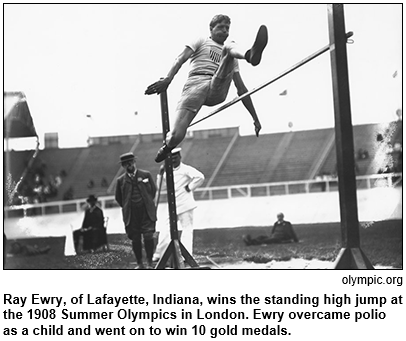 During our show, Nelson and his guests focus on McKinney's teammate at IU and in the 1960 Olympics, Indianapolis native Mike Troy. Despite setting world records and winning two Olympic gold medals - and then becoming a decorated Naval officer during the Vietnam War - Troy, now 75, isn't well-remembered in his home state today.
During our show, Nelson and his guests focus on McKinney's teammate at IU and in the 1960 Olympics, Indianapolis native Mike Troy. Despite setting world records and winning two Olympic gold medals - and then becoming a decorated Naval officer during the Vietnam War - Troy, now 75, isn't well-remembered in his home state today.
Kathy Ellis, the multiple-medal-winning swimming sensation of the 1964 Olympics, also graduated from IU but never competed for the Hoosiers. As our guest Dan O'Brien notes, IU did not have a women's swimming team then.
The dominance of IU's men swimmers at the Olympics ended with the retirement of legendary coach James "Doc" Counsilman. After a drought of 40 years with no IU swimmer on the U.S. Olympic team, three IU swimmers will compete in Rio.
In fact, nearly 20 athletes with Indiana connections will participate in Rio. They include Paul George of the Indiana Pacers and Tamika Catchings of the Indiana Fever (who will be competing for her fourth gold medal), as well as divers David Boudia of Noblesville, the defending gold medalist in the 10-meter platform, and Steele Johnson of Carmel.
Additional research by Heather Kaufman-McKivigan
Roadtrip: Indiana State Fair's Pioneer Village
|
Can you believe it's August? Expect a call into the show from Miss Melody, the schoolmarm in the One Room Schoolhouse in the Pioneer Village at the Indiana State Fair, who will suggest a Roadtrip to the Indiana State Fair!
Miss Melody is portrayed by Janet Gilray of Legacy Keepers Music, an organization dedicated to the preservation of traditional music and song. The schoolmarm is also known for picking up a guitar and singing a song or two, along with her teaching of reading, writing, arithmetic and cursive writing!
Miss Melody tells us that the Pioneer Village is in the northeast corner of the fairgrounds, and she invites us to hear a stellar array of singers at the Songs of Indiana competition in the Pioneer Village Music Hall on Wednesday, Aug. 10, from 10 to 11 a.m.
The fair runs from Friday, Aug. 5 through Sunday, Aug. 21. Looks like the Fair Train won't be running this year, but you can avoid parking hassles by taking the free shuttle from Glendale Mall's Rural Street lot, which operates every 20 minutes from 10 a.m. to 11 p.m. daily. Enjoy!
History Mystery
In 1924, the U.S. Olympic Swimming Trials were in Indianapolis. The venue was Broad Ripple Park's pool, which then was the largest outdoor swimming pool in the entire country.
The star of the swimming trials went on to create a sensation at the 1924 Paris Olympics, winning three gold medals in swimming and one bronze medal in water polo. He also won gold medals at the 1928 Summer Olympics, which were in Amsterdam.
Because of his subsequent, post-Olympics endeavors, the swimming star - who was not a Hoosier - remained famous for the rest of his life.
Question: Who was he?
The prize is two admissions to the Indiana State Fair, and two admissions to the Vanilla Ice, I Love the '90s concert on Aug. 13 at White River State Park, courtesy of Visit Indy.
Bicentennial: today's projects, yesterday's innovators
|
(July 30, 2016) - As Indiana celebrates its 200th birthday, Hoosier History Live periodically has been exploring a range of topics associated with the milestone.
 During this show, we share updates about the major capital projects involved with the Bicentennial, including the creation of a Bicentennial Plaza at the Indiana Statehouse, and the plans to construct a building for the Indiana State Archives, which have been housed in a warehouse on the eastside of Indy - and vulnerable to deterioration.
During this show, we share updates about the major capital projects involved with the Bicentennial, including the creation of a Bicentennial Plaza at the Indiana Statehouse, and the plans to construct a building for the Indiana State Archives, which have been housed in a warehouse on the eastside of Indy - and vulnerable to deterioration.
We also look at historic innovators with Indiana connections who are being honored in grassroots festivities across the state. They include engineer Octave Chanute, whose experiments with gliders on the Indiana Dunes during the 1890s inspired the Wright Brothers.
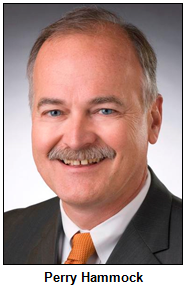 Our guests include Perry Hammock, executive director of the Indiana Bicentennial Commission. He recently participated in an event in northwest Indiana honoring Chanute (1832-1910), who was born in Paris and was based in Chicago for many years. But Chanute conducted many of his most significant experiments with gliders at the Dunes near Miller Beach on Lake Michigan.
Our guests include Perry Hammock, executive director of the Indiana Bicentennial Commission. He recently participated in an event in northwest Indiana honoring Chanute (1832-1910), who was born in Paris and was based in Chicago for many years. But Chanute conducted many of his most significant experiments with gliders at the Dunes near Miller Beach on Lake Michigan.
Nelson's guests also include Jessica Robertson, the commissioner of the Indiana Department of Administration, which is overseeing the Bicentennial's major capital projects.
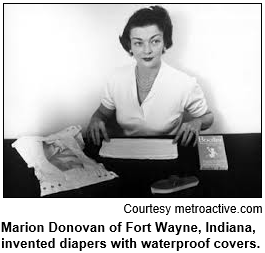 According to Perry Hammock, the Bicentennial Plaza originally was envisioned as a Centennial Plaza to salute the state's 100th birthday in 1916. Perry shares details about the evolution of the plaza, which will be the setting for a major, multi-sensory event - the Bicentennial Hoosier Homecoming - on Oct. 15. The festivities will include the return of the Bicentennial torch after it has traveled to all 92 counties.
According to Perry Hammock, the Bicentennial Plaza originally was envisioned as a Centennial Plaza to salute the state's 100th birthday in 1916. Perry shares details about the evolution of the plaza, which will be the setting for a major, multi-sensory event - the Bicentennial Hoosier Homecoming - on Oct. 15. The festivities will include the return of the Bicentennial torch after it has traveled to all 92 counties.
Speaking of the torch: We also share details about the Hoosiers selected as torch bearers during its route, which begins Sept. 9 in Corydon. According to news accounts, the carriers total nearly 2,000 Hoosiers, including some who have been Hoosier History Live guests, such as filmmaker Angelo Pizzo of Hoosiers and Rudy fame.
In May 2015, Indiana State Archivist Jim Corridan and Stephen Towne, president of the Friends of the State Archives, joined Nelson for a show that explored the range of material (from the two Indiana Constitutions to prison records of John Dillinger) that is housed in the archives. The guests also discussed the dire need for a climate-controlled building to house the archives, following an appropriation of $25 million by the legislature. According to recent news accounts, the most likely site is located near the IUPUI campus.
Our previous shows exploring aspects of the Bicentennial have included a program last January with Perry Hammock and First Lady Karen Pence, the official Bicentennial ambassador, as Nelson's studio guests.
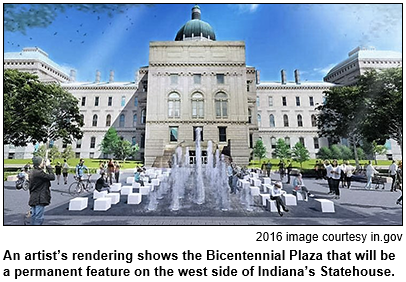 With Perry and Jessica, who oversees more than 200 state employees, we explore - in addition to the Bicentennial Plaza and the planned archives building - the $2.5 million Statehouse Education Center that is being created in the Indiana State Library. The welcome center for visitors to the Indiana State Capitol is expected to be 1,800 square feet with exhibits; according to Perry, the idea for an education center dates to earlier restorations of the statehouse.
With Perry and Jessica, who oversees more than 200 state employees, we explore - in addition to the Bicentennial Plaza and the planned archives building - the $2.5 million Statehouse Education Center that is being created in the Indiana State Library. The welcome center for visitors to the Indiana State Capitol is expected to be 1,800 square feet with exhibits; according to Perry, the idea for an education center dates to earlier restorations of the statehouse.
Bicentennial celebrations across the state are saluting historic innovators with Indiana connections. In addition to Chanute, whose 32-pound glider flew 480 feet and landed in Lake Michigan in 1896, we explore:
- Fort Wayne native Marion Donovan, a mother of two credited with inventing diapers with waterproof covers. During the 1940s, she was frustrated with the frequency that she needed to change her children's cloth diapers. Not only did she create a waterproof diaper (using a shower curtain), she eventually designed one with snap fasteners that replaced safety pins. Her diapers were patented in 1951.
- Connersville native Howard Garns (1905-1989), an architect who loved puzzles. In the 1970s, he published (without bylines) puzzles that eventually gained popularity in Japan. According to the Bicentennial Commission, some of his puzzles in Japan were renamed Sudoko; Garns had died by the time they became internationally famous in the early 21st century.
- And Ermal Cleon Fraze, a Delaware County native who invented a way to attach pull tabs to the tops of beer and soft drink cans. (According to folklore, Fraze was frustrated in 1959 at a picnic without can openers.) He sold the rights to his invention to the Aluminum Company of America.
Additional editorial assistance by Heather Kaufman-McKivigan.
Roadtrip: Marquette Park on Lake Michigan
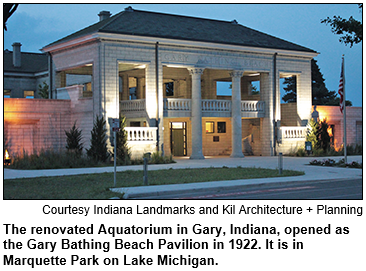 Guest Roadtripper Suzanne Stanis of Indiana Landmarks will tell us about an impressive park along Lake Michigan in the Miller Beach area of Gary with ties to Octave Chanute.
Guest Roadtripper Suzanne Stanis of Indiana Landmarks will tell us about an impressive park along Lake Michigan in the Miller Beach area of Gary with ties to Octave Chanute.
Since its construction in the 1920s, Marquette Park, in the Miller Beach section of Gary, has seen countless weddings, proms, graduation parties and impromptu gatherings big and small. However, as Gary declined beginning in the late 1960s, so did its largest park. But thanks to a series of repairs and restoration work largely performed, the celebrations are back - and in a big way.
Two buildings dominate the landscape at Marquette Park: the Marquette Park Pavilion (opened as the Recreation Pavilion in 1924) and the Aquatorium (opened as the Gary Bathing Beach Pavilion in 1922), both designed by George W. Maher. The Pavilion features a combination of Prairie School and Italian Revival Styles, while the Aquatorium is a model of the Neoclassical Style.
The Aquatorium also houses a museum exhibit commemorating Octave Chanute - a French aviation pioneer who flight-tested his craft from the Gary dunes years before the Wright brothers' flight at Kitty Hawk - and the Tuskegee Airmen, a World War II-era African-American U.S. Army Air Forces squadron that trained at Chanute Air Force base in Illinois.
History Mystery
|
The Bicentennial torch relay, which begins Sept. 9, will go through all 92 counties in Indiana.
The county with the largest population is Marion County, the home of Indianapolis. But Marion County is not the largest county in terms of geographic size.
Question: Which of our counties is the largest in land size?
Hint: It's not in central Indiana.
The prize pack is a food and drink tour of downtown Indy, including gift certificates to Tin Roof, Bee Coffee Roasters and Sun King Brewery, all courtesy of Visit Indy.
Host Nelson Price to appear on WICR's Legally Speaking show
(July 2016) - On Saturday, July 30, tune in to WICR-FM (88.7) one hour prior to Hoosier History Live to listen to Legally Speaking, the call-in legal advice show hosted by our friend, attorney Charles Braun.
Nelson will be Charles' guest to share insights about historic Indiana trials and court proceedings. Legally Speaking runs from 11 to 11:30 a.m.
Nelson will discuss the impact of some trials and court proceedings that have been the focus of Hoosier History Live shows; others are explored in Nelson's various books.
Our intrepid show host plans to talk about the trial resulting from the infamous Massacre at Fall Creek in 1824. For the first time in U.S. history, whites were convicted and executed for the slaughter of Native Americans as a result of the massacre near Pendleton. An alcohol-fueled mob slaughtered nine Seneca Indians, including women and children.
Nelson also will share insights about the trial during the 1920s that helped end the Ku Klux Klan stranglehold on Indiana politicians; KKK leader D.C. Stephenson was convicted of second-degree murder at the trial in Noblesville that involved an all-white, all-male jury.
Also during Legally Speaking, Nelson will discuss the so-called "trial of the century" in Indianapolis during the late 1950s. The lurid case involved a top business executive who was shot to death (in what was called "the Murder at the Meadows") by one of his two mistresses; the crime and resulting trial drew international attention.
We also will hear Nelson's insights about court proceedings during the 1980s that resulted from the crusade by Kokomo teenager Ryan White to attend school despite his AIDS diagnosis.
Unheralded heroes of the Underground Railroad
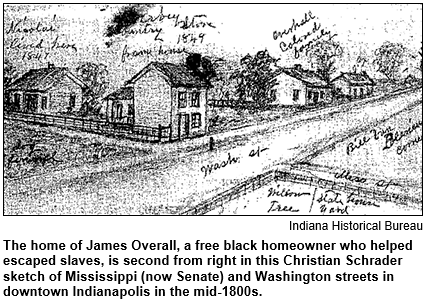 (July 23, 2016) - During the 1830s in Indianapolis, a free African-American landowner named James Overall helped escaped slaves. At one point, Overall, who previously had lived in Corydon, was attacked in his Indianapolis home by a gang of white residents.
(July 23, 2016) - During the 1830s in Indianapolis, a free African-American landowner named James Overall helped escaped slaves. At one point, Overall, who previously had lived in Corydon, was attacked in his Indianapolis home by a gang of white residents.
In September, a historic marker commemorating Overall will be erected on Indiana Avenue, near where he owned property.
As we explore unheralded heroes of the Underground Railroad, Nelson is joined in studio by Corydon-based historic preservationist Maxine Brown, who has researched Overall's efforts and crusaded for the marker to be erected by the Indiana Historical Bureau.
Nelson's guests also include Nick Patler, a graduate of Bethany Theological Seminary who has researched Underground Railroad activity in Wayne County. Nick recently spoke to Indiana Freedom Trails, a nonprofit that is researching and verifying sites and people across the state involved in the Underground Railroad.
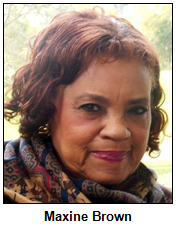 According to Maxine's research, James Overall and his family were listed as "free persons of color" in Corydon in the 1820 U.S. Census; he had purchased property there as early as 1817. By 1830, the family had moved to Indianapolis, where Overall became a trustee of the African Methodist Episcopal Church.
According to Maxine's research, James Overall and his family were listed as "free persons of color" in Corydon in the 1820 U.S. Census; he had purchased property there as early as 1817. By 1830, the family had moved to Indianapolis, where Overall became a trustee of the African Methodist Episcopal Church.
In 1836, Overall was attacked in his home by a white gang. One of the gang leaders was briefly jailed, even though Indiana law at the time prohibited blacks from testifying against whites. The gang leader was freed, but the outcry prompted a Marion County judge to write a lengthy opinion (printed in newspapers) arguing that "the natural rights of man" offered all men, including African Americans, some legal protections to defend themselves, their families and their homes.
During this period, Overall helped with Underground Railroad activity. Those he assisted included Jermain Loguen, an escaped slave from Tennessee who eventually because a well-known Underground Railroad activist based in New York.  The historic marker for Overall, sponsored by the Society of Indiana Pioneers, will be dedicated Sept. 29 at 3:30 p.m.
The historic marker for Overall, sponsored by the Society of Indiana Pioneers, will be dedicated Sept. 29 at 3:30 p.m.
Our guest Nick Patler shares insights about historic figures who helped escaped slaves in Richmond and elsewhere in Wayne County. Most of the attention in eastern Indiana has focused on Levi and Catharine Coffin, Quakers whose home is a state historic site.
But Nick says several unheralded others took great risks. They include Calvin Outland, a freed slave who arrived with a Quaker migration team in 1831 and who "appears to have become one of the main Underground Railroad operatives in the city of Richmond."
Other heroes include two escaped slaves: William Bush, who settled in Wayne County and, as Nick puts it, "went to work helping other African Americans fleeing bondage," and Louis Talbert, who thwarted slave hunters while helping others like himself.
A major organizer of the Underground Railroad in Richmond was Paul Quinn, a leader in the African Methodist Episcopal Church, according to Nick Patler.
Nick, who wrote his master's thesis about Underground Railroad activity in Wayne County, now lives in Staunton, Va., and is an adjunct professor at Elizabeth State University in North Carolina. He is working on a book about African American leaders in the Deep South during Reconstruction.
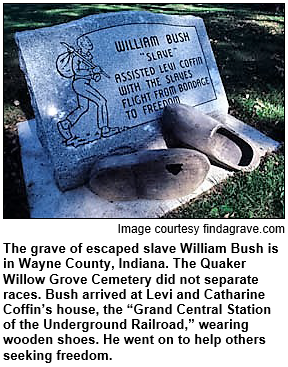 Our guest Maxine Brown is descended from free African Americans who lived in Corydon beginning in the early 1800s. She has been a guest on previous Hoosier History Live shows, including a program about her restoration of a community landmark known historically as the Corydon Colored School. The school, which closed with integration, is now an award-wining cultural center, the Leora Brown School, named in honor of Maxine's aunt, a longtime teacher at the school.
Our guest Maxine Brown is descended from free African Americans who lived in Corydon beginning in the early 1800s. She has been a guest on previous Hoosier History Live shows, including a program about her restoration of a community landmark known historically as the Corydon Colored School. The school, which closed with integration, is now an award-wining cultural center, the Leora Brown School, named in honor of Maxine's aunt, a longtime teacher at the school.
In February 2015, Maxine was our guest on a show about African Americans in Indiana during the Civil War, including those who fought in the Union Army.
Learn more:
- Student seeks help with local Underground Railroad research - Richmond Palladium-Item story, July 16, 2014.
- James Overall, Indiana Free Person of Color and the 'Natural Rights of Man' - Indiana Historical Bureau article, July 15, 2016.
- Hoosiers, the Story of Indiana, Birth of a State -WFYI Education Programs, aired July 7, 2016.
- Civil War and African Americans in Indiana - Hoosier History Live newsletter for Feb. 21, 2015 radio program.
- Early African-American settlements - Hoosier History Live newsletter for Feb. 20, 2010 radio program.
- Underground Railroad reality and myths in Indiana - Hoosier History Live newsletter for June 29, 2013 radio program.
Roadtrip: Hindostan Falls in Martin County
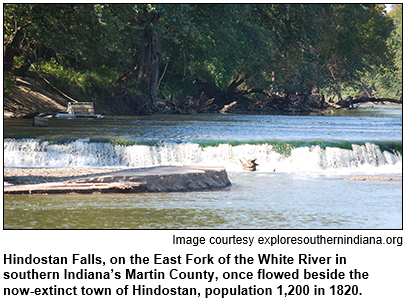 Guest Roadtripper and travel writer Jane Ammeson tells us to visit Hindostan Falls along the East Fork of the White River in Martin County.
Guest Roadtripper and travel writer Jane Ammeson tells us to visit Hindostan Falls along the East Fork of the White River in Martin County.
There's not much there now, Jane tells us, but Hindostan Falls was a much livelier place two centuries ago after the 1816 founding of the town of Hindostan, which was named after a British soldier who had served time in India.
By 1820 the town had a booming population that reached 1,200, making it one of the largest settlements in this part of Indiana. Poised on one of the new state's first stagecoach runs connecting New Albany and Vincennes, Hindostan boasted two mills, a hotel, whetstone factory, post office and even a button factory. Ferries made their way between the river's two banks, and houseboats moored on its waters.
Time wasn't kind to Hindostan, and today all that's left of the thriving community are some square cuts in the flat rocks where one of the mills used to be anchored, and stories of spirits haunting Hindostan Falls.
Some towns just fade away, but much of Hindostan disappeared much more quickly, many of its townspeople wiped out by a terrible sickness - yellow fever or cholera or even, some say, the plague. Homes where entire families had died were burned to the ground, and mass graves, some holding a hundred or so, were dug and then hastily filled up.
Hear more from Jane this Saturday!
History Mystery
The first state constitution for Indiana was written during the summer of 1816 in Corydon, where Underground Railroad activist James Overall lived for several years. More than 40 state leaders met 200 years ago in Corydon, Indiana's first capital, to draft the constitution, which banned slavery.
 Because the weather was hot - and the buildings in Corydon felt stifling - the delegates sought relief by meeting under the shade of an enormous tree.
Because the weather was hot - and the buildings in Corydon felt stifling - the delegates sought relief by meeting under the shade of an enormous tree.
The landmark tree, which was five feet in diameter, finally died during the 1920s. But its stump is preserved in a shrine in Corydon's historic district.
Question: Under what kind of tree did the leaders draft and debate Indiana's first constitution?
The prize is two admissions to the Go Ape (zipline treetop adventure) at Eagle Creek Park, and a gift certificate to Howl at the Moon restaurant in downtown Indy, courtesy of Visit Indy.
Bygone natural landmarks
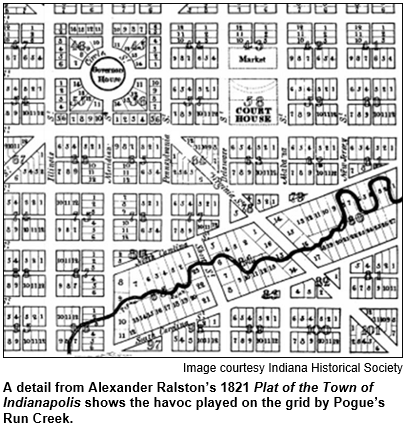 (July 16, 2016) - It was the biggest, by far, of the Indiana Dunes on Lake Michigan. But the Hoosier Slide, a huge, barren sand dune near Michigan City, had disappeared by 1920.
(July 16, 2016) - It was the biggest, by far, of the Indiana Dunes on Lake Michigan. But the Hoosier Slide, a huge, barren sand dune near Michigan City, had disappeared by 1920.
In early Indianapolis, a stream known as Pogue's Run broke the grid pattern of the Mile Square downtown. The urban creek, named after an early settler who suddenly vanished, has mostly disappeared from sight. Parts of Pogue's Run flow underneath Indy and along parkways.
What happened to these bygone natural landmarks that once were household names across the state? To share insights, Nelson is joined in studio by two Hoosiers who have extensively researched the vanished landmarks. His guests are:
- Christopher Taelman, a resident of Granger in far-northern Indiana who is chief development officer of the Hospice Foundation based in Mishawaka. For several years, Chris, a South Bend native and civic leader, was a manager with NIPSCO (Northern Indiana Public Service Co.). It's a utility with a generating station that now sits on the site of the legendary Hoosier Slide, which Chris calls "one of our wonders along Lake Michigan."
- And Indianapolis architect Jim Lingenfelter, owner of Five2Five Design Studio, 660 Virginia Ave. Jim, the past president of the Indianapolis Public Library Board, even embarked on a search last year with a newspaper reporter and others to try to find and follow remnants of Pogue's Run.
"In the mid-1800s, (the Hoosier Slide) had trees and berries (and) cows even grazed there," says the website emichigancity.com. "As the trees were cut and used, the dune became bare, probably by 1870. 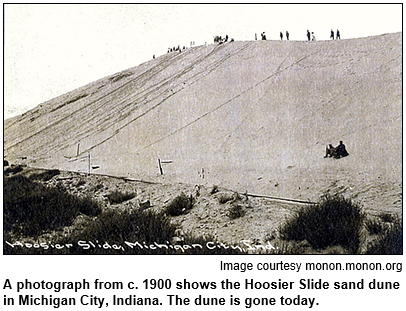 Commercial sand mining began about 1890, when the Monon Railroad built a switching track along the south side of the dune to serve the lumber docks on the west side of the harbor."
Commercial sand mining began about 1890, when the Monon Railroad built a switching track along the south side of the dune to serve the lumber docks on the west side of the harbor."
Postcards of the Hoosier Slide were distributed during the late 19th century to tout what some called "Indiana's most famous natural landmark."
According to various sources, sand from the Hoosier Slide was hauled away - initially via wheelbarrows - and was transported for use by commercial endeavors in Indiana. When natural gas was discovered in east central Indiana during the 1880s, large users of the Hoosier Slide's sand were glass-making companies that sprang up. They included the business of the Ball Brothers in Muncie.
In Indianapolis, the original planner of the new Hoosier capital, Alexander Ralston, had to modify the pattern of his grid because Pogue's Run flowed through the Mile Square.
 Ralston platted the city in 1821, the same year that George Pogue, a blacksmith credited with being one of the earliest white settlers, mysteriously vanished. He disappeared after leaving his home to search for horses that may have been stolen.
Ralston platted the city in 1821, the same year that George Pogue, a blacksmith credited with being one of the earliest white settlers, mysteriously vanished. He disappeared after leaving his home to search for horses that may have been stolen. 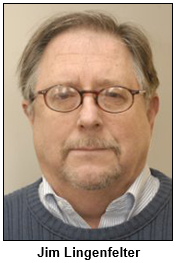 Various theories have been offered to explain why Pogue never returned from the woods, including folklore that Native Americans may have captured him.
Various theories have been offered to explain why Pogue never returned from the woods, including folklore that Native Americans may have captured him.
The stream named in his honor often was regarded as a nuisance by city leaders. To open the Mile Square for development, downtown portions of Pogue's Run were routed underground.
But portions of Pogue's Run still visibly flow near Brookside Parkway on the eastside of Indy. The stream also runs through the campus of Tech High School.
Our guest Jim Lingenfelter is a Tech alum and says he, even before his high school years, "hunted for crawdads" in parts of Pogue's Run on the eastside. In addition, Jim's great-grandfather, a Purdue graduate, was an engineer who was part of the team that erected a viaduct that elevated the Union Station railroad tracks and, in 1913, created the enclosed storm sewer that continues to carry Pogue's Run underneath downtown.
Ever since the founding of Indianapolis in the 1820s, civic leaders had disparaged Pogue's Run as a mosquito-infested source of "pestilence" downtown. One of the state legislature's first appropriations involved $50 to clean up the stream in the new state capital. Because Pogue's Run was too shallow and narrow to be navigable, it was regarded as, at best, useless.
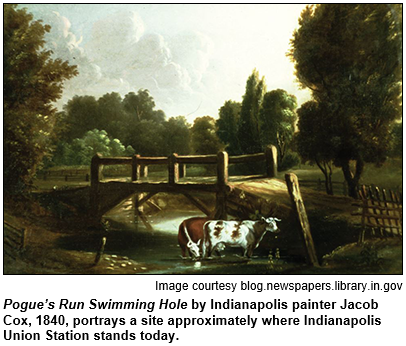 During the Civil War, after Republicans and Democrats clashed during state conventions, there even was an incident derisively known as the "Battle of Pogue's Run". Far from being a battle, the 1863 event merely involved Democrats on departing trains tossing their knives, pistols and other weapons from railcar windows into the stream.
During the Civil War, after Republicans and Democrats clashed during state conventions, there even was an incident derisively known as the "Battle of Pogue's Run". Far from being a battle, the 1863 event merely involved Democrats on departing trains tossing their knives, pistols and other weapons from railcar windows into the stream.
Just as portions of the 11-mile urban stream still can be seen above ground, its name lives on in various ways. Pogue's Run Grocer on East 10th Street is touted as the city's only food cooperative.
The Hoosier Slide, though, is merely a memory. The sand dune's height was estimated at 200 feet.
According to emichigancity.com, two sand companies - including one called the Hoosier Slide Sand Co. - became competitive. They eventually used cranes and electrical conveyor belts to remove the Hoosier Slide.
Sand was shipped for business and commercial use as far away as Mexico. According to some sources, a total 13.5 million tons of sand had been hauled away by 1920, when the Hoosier Slide disappeared.
Learn more:
- Urban Trekkers Seek to Uncover Mystery of Pogue's Run - Will Higgins story in The Indianapolis Star, May 19, 2015.
- Explore Indy's rat-infested underworld - Will Higgins story in The Indianapolis Star, Oct. 31, 2013.
- Natural gas boom of 1880s and '90s - Newsletter for June 7, 2014 Hoosier History Live show.
- Long-forgotten man who designed Indy - Newsletter for Feb. 9, 2013 Hoosier History Live show.
- Uncle Archy Fires His Pistol, or Why Am I Here? - Jim Lingenfelter reading regarding Pogue's Run, April 6, 2015, Indianapolis Literary Club.
- The Pogue's Run Ghosts - May 7, 2015 account by Stephen J. Taylor in Hoosier State Chronicles.
Roadtrip: Chief Menominee Memorial near Plymouth in northern Indiana
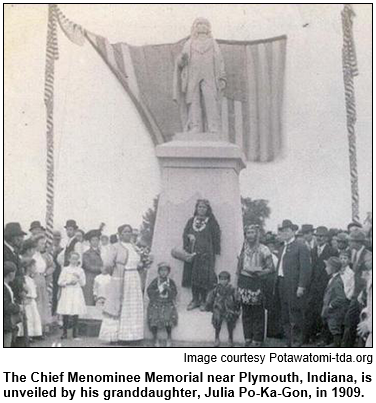 Guest Roadtripper and longtime Hoosier History Live fan Phil Brooks, who works by day as an aircraft dispatcher, invites us to visit the Chief Menominee Memorial south of Plymouth, Indiana, and west of U.S. 31 in Marshall County. It commemorates the Potawatomi Chief Menominee, who lived from the early 1790s to 1841.
Guest Roadtripper and longtime Hoosier History Live fan Phil Brooks, who works by day as an aircraft dispatcher, invites us to visit the Chief Menominee Memorial south of Plymouth, Indiana, and west of U.S. 31 in Marshall County. It commemorates the Potawatomi Chief Menominee, who lived from the early 1790s to 1841.
Menominee's refusal to concede more land to the federal government led to the forced removal of his band of 859 from their village at Twin Lakes in 1838, known as The Potawatomi Trail of Death. Forty-two Potawatomi died on the two-month walk to reservation lands in Kansas. It was the single largest forced removal of Native Americans from the state of Indiana.
The 17-foot-tall granite monument was the first to honor a Native American to be dedicated in the United States under a state or federal legislative enactment. Its dedication was in 1909.
"On a lighter note," Phil tells us, "there's a popular Marshall County event that will be occurring on Labor Day weekend, the Marshall County Blueberry Festival." Held in the town of Plymouth, and celebrating its 50th year in 2016, it of course features blueberry treats of all kinds, as well as entertainment, crafts, a parade, road and swimming races. And best of all, it's free!"
History Mystery
Tech High School, through which Pogue's Run flows, was the third public high school in Indianapolis to open. Located on a 75-acre campus that was the former federal arsenal grounds used by the Union Army during the Civil War (hence, the school's official name of Arsenal Technical High School), its roots date to the early 1900s.
Shortridge High School is considered to be the oldest public high school in the Hoosier capital because it evolved from the city's first, which was known as Indianapolis High School when it opened in the 1860s.
Question: What was the second public high school to open in the city?
The prize is a Family Fourpack for admission to Conner Prairie and two tickets to a performance of Bush and Chevell at White River State Park on July 26, courtesy of Visit Indy.
Latvian and Lithuanian heritage
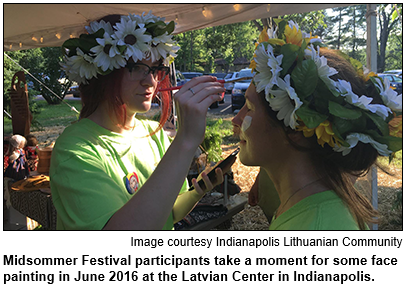 (July 9, 2016) - For nearly 55 years, the Latvian Community Center has been a landmark on the northwest side of Indianapolis. In fact, some of the other ethnic heritage groups featured in our rotating series on Hoosier History Live have their monthly meetings at the Latvian center, 1008. W. 64th St.
(July 9, 2016) - For nearly 55 years, the Latvian Community Center has been a landmark on the northwest side of Indianapolis. In fact, some of the other ethnic heritage groups featured in our rotating series on Hoosier History Live have their monthly meetings at the Latvian center, 1008. W. 64th St.
So isn't it high time we spotlight the heritage in Indiana of the Baltic countries of Latvia and Lithuania? (Because of scheduling challenges, the third Baltic nation, Estonia, isn't in the spotlight this time. We hope to explore Estonian heritage in Indiana down the road.)
Our rotating series about immigration and ethnic heritage already has explored the impact in Indiana of more than a dozen groups. Shows have focused on Scottish, Russian and Cuban immigration, as well as Italian stonecutters, Swedish and Norwegian heritage and even Sikh heritage in the state.
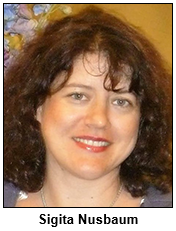 This time around, Nelson's studio guests include Laura Bates, a Terre Haute-based author and English professor at Indiana State University whose parents fled Latvia as refugees after World War II.
This time around, Nelson's studio guests include Laura Bates, a Terre Haute-based author and English professor at Indiana State University whose parents fled Latvia as refugees after World War II.
"They came to this country with sponsors who provided work and housing," Laura reports.  "My mother was a caregiver for an elderly couple, and my father was a dishwasher in a hotel restaurant. My sister and I learned Latvian before English, we always spoke Latvian at home, and we attended Latvian school and church."
"My mother was a caregiver for an elderly couple, and my father was a dishwasher in a hotel restaurant. My sister and I learned Latvian before English, we always spoke Latvian at home, and we attended Latvian school and church."
In Indianapolis, Andris Berzins, president of the Latvian Community Center, also grew up as the child of two immigrants.
Although Andris, who was born in 1968 and works in the insurance industry, is a graduate of North Central High School and Indiana University, he also attended Latvian school, a Saturday school that still continues. In addition to learning the Latvian language, students are taught the culture, geography, grammar, music and traditions of their ancestral homeland.
Andris, who also is a guest on our show, attends the Latvian Lutheran Church, a congregation that meets at Pleasant View Lutheran Church on West 73rd Street. According to Andris, about 80 percent of Latvians are Lutherans, and 20 percent are Catholic.
In contrast, Lithuanians are about 80 percent Catholic, according to several sources, including Sigita Nusbaum, past president of the Indianapolis Lithuanian Community. After graduating from college in Lithuania, Sigita, 42, came to Indiana under an exchange program. Sigita, who joins Nelson in studio, lives in Fishers and owns Delaney Window Fashions, a custom drapery business.
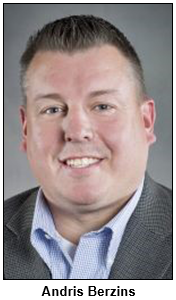 Immigrants from Latvia and Lithuania tended to arrive in two or three waves, according to Peopling Indiana: The Ethnic Experience (Indiana Historical Society Press, 1996). The first wave, during the late 1800s and early 1900s, consisted of immigrants seeking upward mobility. The second followed World War II and included refugees who refused "to return to communist-occupied or dominated homelands."
Immigrants from Latvia and Lithuania tended to arrive in two or three waves, according to Peopling Indiana: The Ethnic Experience (Indiana Historical Society Press, 1996). The first wave, during the late 1800s and early 1900s, consisted of immigrants seeking upward mobility. The second followed World War II and included refugees who refused "to return to communist-occupied or dominated homelands."
For centuries, the Baltic people often were ruled by powerful neighbors, including Germans, Russians, Poles and even Swedes. In 1918, following World War I, all three countries declared independence, only to be overrun during World War II and eventually absorbed into the Soviet Union. With the collapse of the Soviet empire, the three Baltic countries regained independence in 1991.
Peopling Indiana notes that, during the early 1900s, Lithuanians developed "active colonies in the Calumet Region" of Indiana thanks to jobs at the steel mills and other booming industries; many relocated from Chicago, Pittsburgh and other cities to northwest Indiana.
During the last 30 years, Lithuanians who have settled in central Indiana have tended to be college-educated professionals, according to our guest Sigita Nusbaum. She said the Lithuanian heritage organization in central Indiana is one of 56 across the country, with groups in greater Chicago, including northwest Indiana, among the largest.
In fact, Chicago is sometimes called the "Lithuanian-American capital." In northwest Indiana, the resort town of Beverly Shores on Lake Michigan has a high percentage of residents of Lithuanian heritage.
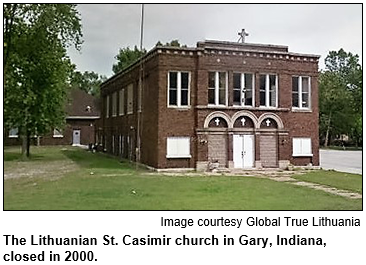 According to our guest Sigita Nusbaum, many Lithuanians who arrived in Indiana after World War II hoped to return to their homeland after Soviet control ended. Because Lithuanian independence took nearly 50 years, though, many "did not live to that day."
According to our guest Sigita Nusbaum, many Lithuanians who arrived in Indiana after World War II hoped to return to their homeland after Soviet control ended. Because Lithuanian independence took nearly 50 years, though, many "did not live to that day."
Sigita also notes the Lithuanian and Latvian languages are considered among the world's oldest. The Lithuanian language is said to retain many of the most "archaic" features of Indo-European languages; they include some aspects only found in ancient Greek and Sanskrit.
Like the Latvians, the Lithuanian community in Indianapolis also offers a Saturday school. Local Lithuanians also have formed a folk band group, Biru Bar, and two folk dance groups.
Other notes about Baltic heritage in Indiana:
- Our guest Laura Bates is working on a book drawn from the hundreds of letters and journals written by her Latvian parents.
- Several ethnic heritage groups - including Latvians, Lithuanians and Estonians - host an annual Midsommer Festival at the Latvian Community Center. This year's festival on June 25 was attended by more than 400 people; the event evolved from ancient celebrations of the summer solstice.
Learn more:
- International Center.
- Hoosier History Live newsletters for our shows about Irish, Scottish, Cuban, Colombian/Venezuelan, Russian, Italian, Swedish and Norwegian, Sikh, and Persian/Iranian immigration.
- Video, Lithuanian Dance Festival in Boston, 2012.
Roadtrip: Ripley, Switzerland and Ohio counties
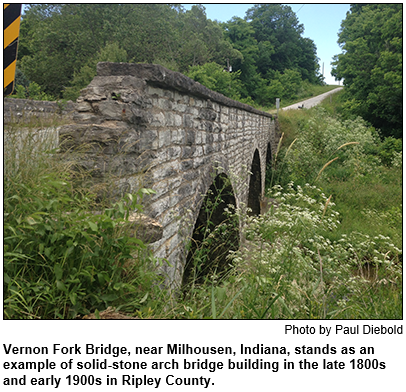 Guest Roadtripper Paul Diebold of the Indiana Department of Natural Resources, Division of Historic Preservation, reports on a recent Roadtrip he took with his wife Peggy wandering down U.S. 421 and State Road 129 in southeastern Indiana. He reports lots of fascinating historic sites and architecture in along those roads, and the journey includes two scenic byways, the Michigan Road and the Ohio River Scenic Byway.
Guest Roadtripper Paul Diebold of the Indiana Department of Natural Resources, Division of Historic Preservation, reports on a recent Roadtrip he took with his wife Peggy wandering down U.S. 421 and State Road 129 in southeastern Indiana. He reports lots of fascinating historic sites and architecture in along those roads, and the journey includes two scenic byways, the Michigan Road and the Ohio River Scenic Byway.
Paul and Peggy they saw the solid stone, arched bridges of Ripley County; early row houses in Napoleon; and even an early French-Swiss farmhouse in Switzerland County called Venoge.
Our Roadtrippers visited the Switzerland County Historical Society's museum in Vevay, where the Greek Revival-style courthouse overlooks a town filled with great architecture. On their way to the Ohio County seat of Rising Sun on the Ohio River Scenic Byway, it seems our Roadtrippers were briefly detained in the Patriot Jail!
Tune in to see how they escaped, and see if they make to the Ohio County Historical Society to meet their new friend, the two-headed calf. Happy Roadtripping!
History Mystery
The resort town of Beverly Shores in far-northern Indiana not only has many residents of Lithuanian heritage, it also is known for some distinctive homes. Some of the historic homes in the town on Lake Michigan were transported by barges from Chicago to Beverly Shores, which is located near the Indiana Dunes.
The distinctive houses, which are now privately occupied in Beverly Shores, had been associated with a famous event in Chicago. Thousands of visitors had seen the houses at the event.
Question: What was the event in Chicago?
This week's prize package includes two tickets to see Peter Frampton and Gregg Allman at White River State Park on Wednesday, July 20, four admissions to the Indiana Experience, and a gift card to Sun King Brewery, all courtesy of Visit Indy.
The wives of artist T.C. Steele
|
(July 2, 2016) - You already may know about the most famous painter from Indiana, T.C. Steele, who won widespread acclaim for his landscapes, particularly of scenic Brown County.
But how much do you know about the two wives who were, in different ways, so influential in the life and work of the Hoosier Group artist who died 90 years ago this month?
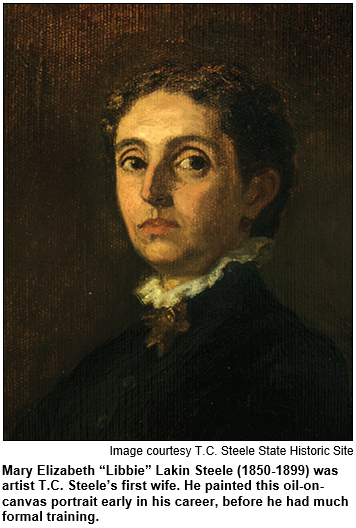 To share insights about Libbie Lakin Steele and Selma Neubacher Steele, acclaimed author Rachel Berenson Perry, the fine arts curator emerita for the Indiana State Museum, is Nelson's studio guest. Rachel has written an introduction about Selma for the newly released House of the Singing Winds: The Life and Work of T.C. Steele, a lavishly illustrated book that the Indiana Historical Society originally published 50 years ago.
To share insights about Libbie Lakin Steele and Selma Neubacher Steele, acclaimed author Rachel Berenson Perry, the fine arts curator emerita for the Indiana State Museum, is Nelson's studio guest. Rachel has written an introduction about Selma for the newly released House of the Singing Winds: The Life and Work of T.C. Steele, a lavishly illustrated book that the Indiana Historical Society originally published 50 years ago.
Rachel also is the curator for an extensive exhibit of paintings by Steele (1847-1926) at the Eugene and Marilyn Glick Indiana History Center; several of the paintings are from private collections and never have been seen in public before. The special exhibit, Indiana Impressions: The Art of T.C. Steele, runs through July 9.
In the new version of the book - which also features an account by Selma of her challenges in moving with her husband to rustic, isolated Brown County during the early 1900s - Rachel calls Selma "the unsung heroine of her artist husband's legacy."
 Even today, at the couple's restored hilltop home studio (which he called the House of the Singing Winds), now the T.C. Steele State Historic Site, Rachel notes: "Potable water continues to be problematic, flooded roads are a seasonal headache, and building maintenance is a perpetual conundrum."
Even today, at the couple's restored hilltop home studio (which he called the House of the Singing Winds), now the T.C. Steele State Historic Site, Rachel notes: "Potable water continues to be problematic, flooded roads are a seasonal headache, and building maintenance is a perpetual conundrum."
The beauty of the area - which Steele depicted in landscapes now cherished by collectors - is undeniable. Before his renown as a landscape artist, though, T.C. Steele (full name: Theodore Clement Steele) was in demand as a portrait painter, the source of his acclaim for many of the years he was married to Libbie, his first wife.
Steele painted portraits of most of Indiana's most prominent residents of the era, including President Benjamin Harrison, poet James Whitcomb Riley, Col. Eli Lilly and retailer Lyman S. Ayres.
Libbie Steele, who died of tuberculosis at age 49, was the mother of the couple's children, Brandt, Daisy and Shirley. The children were under 10 years old when Libbie coped with raising them overseas; that's because T.C. Steele was studying at one of the world's top art schools, the Royal Academy of Art in Munich, Germany.
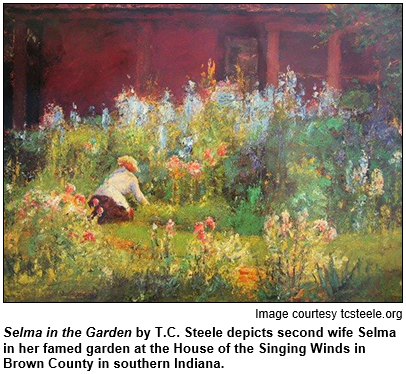 Rachel describes Libbie as a "kindred spirit, nature lover and critic of his paintings from the beginning. Though not an artist herself, (she was) very tuned into his muse."
Rachel describes Libbie as a "kindred spirit, nature lover and critic of his paintings from the beginning. Though not an artist herself, (she was) very tuned into his muse."
Steele was born near Gosport and grew up in Waveland in west-central Indiana. For most of his career as a portrait artist, he was based in Indianapolis; second wife Selma got her first look at their Brown County home shortly after their wedding.
Before that, Selma had been a teacher at Indianapolis Public Schools, Rachel notes in the introduction for the rereleased book about T.C. Steele. Selma also toured Europe and taught at what was then known as the John Herron Art Institute.
After she married Steele in 1907, the couple moved to the House of the Singing Winds, which he had built on 60 hilltop acres near the Brown County town of Belmont. At the House of the Singing Winds, gardening and landscaping became Selma's passions. That inspired her husband to paint garden subjects and still lifes of floral arrangements.
Despite the challenges of what Rachel describes as a "profound cultural divide" between the Steeles and their rural neighbors, many of whom were illiterate, Selma Steele was driven by a "social conscience" to address harmful and unjust conditions, as well as to preserve the area's forests.
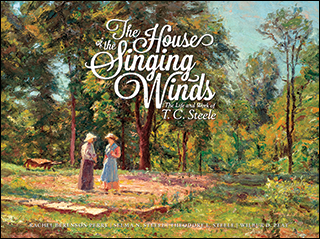 During our show, Rachel shares insights about the ways Selma, who outlived her husband by nearly 20 years, strived to ensure his legacy.
During our show, Rachel shares insights about the ways Selma, who outlived her husband by nearly 20 years, strived to ensure his legacy.
Rachel's books include a biography written for young readers, Paint and Canvas: A Life of T.C. Steele (IHS Press, 2011). She was a guest on Hoosier History Live in 2015 for a show about the life of Steele's Hoosier Group colleague William Forsyth.
Rachel is the author of William J. Forsyth: The Life and Work of an Indiana Artist (IU Press, 2014).
Learn more:
- William Forsyth's colorful life, plus Portfolio Club history - Hoosier History Live newsletter for Jan. 17, 2015 program.
- Indiana Impressions: The Art of T.C. Steele - Indiana Historical Society exhibit and book description.
- On the road with T.C. Steele - Indiana Historical Society story about traveling the state of Indiana collecting the art of T.C. Steele.
- Interview with Rachel Berenson Perry by Ray Boomhower of the Indiana Historical Society.
|
Roadtrip: National Road east, Indianapolis to Richmond
Guest Roadtripper and architectural historian William Selm will focus on the National Road (U.S. 40) from Indianapolis to Richmond in the eastern part of the state. The road arrived in Indiana in the 1830s at the beginning of the Canal Era, before the coming of the railroads.
Expect Bill to talk about the numerous small towns spawned by the road, such as Knightstown, where the road became Main Street. And Cumberland, Greenfield, Knightstown, Centerville, Dublin, East Germantown and Richmond are just a few of these National Road towns that you'll find as you head east. Hear more on Saturday on the radio!
History Mystery
 Before T.C. Steele became renowned primarily for his landscape paintings, he painted the portraits of many of the most famous Hoosiers of his era.
Before T.C. Steele became renowned primarily for his landscape paintings, he painted the portraits of many of the most famous Hoosiers of his era.
His portrait subjects - in addition to President Benjamin Harrison and poet James Whitcomb Riley - included one of the five U.S. vice presidents elected from Indiana. This vice president was a Republican who had been a wealthy attorney in Indianapolis. He was vice president from 1905 to 1909, serving under a U.S. president with whom he had a chilly relationship.
The vice president died in 1918 and is buried at Crown Hill Cemetery in Indianapolis.
Question: Name the vice president whose portrait was painted by T.C. Steele.
The prize pack includes two admissions to the Indianapolis Museum of Art, four admissions to the Indiana Experience at the Indiana History Center, and a gift certificate to Bee Coffee Roasters, all courtesy of Visit Indy.
Astronauts and Purdue
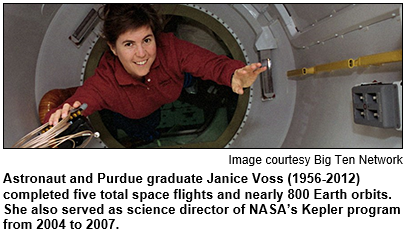 (June 25, 2016) - A significant percentage of American astronauts have spent portions of their lives in Indiana. A major reason is the presence of Purdue University, which has been nicknamed "Mother of Astronauts."
(June 25, 2016) - A significant percentage of American astronauts have spent portions of their lives in Indiana. A major reason is the presence of Purdue University, which has been nicknamed "Mother of Astronauts."
To explore the historic connection between the space program and the university in West Lafayette, Nelson is joined in studio by an author, journalist and historian who is considered the top expert on Indiana and space exploration.
John Norberg, a retired columnist for the Lafayette Journal & Courier and a Purdue historian, is one of the few journalists to whom reclusive Neil Armstrong granted one-on-one interviews. John also is the co-author of a biography of Jerry Ross, a popular retired astronaut who grew up in Crown Point, Ind., graduated from Purdue and is tied for first among all astronauts for the number of space launches.
John Norberg collaborated with Jerry Ross on the book Spacewalker: My Journey in Space and Faith as NASA's Record-Setting Frequent Flier (Purdue University Press, 2013.)
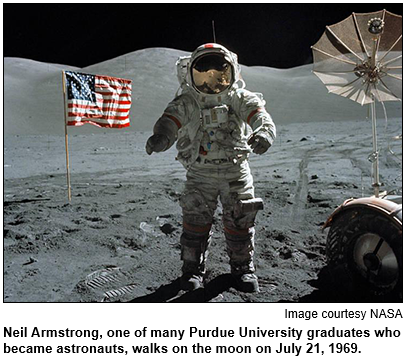 During our show, one of the currently active astronauts who graduated from Purdue joins John and Nelson by phone. Astronaut Drew Feustel, 50, who grew up in Michigan and studied earth sciences at Purdue, is preparing for another space mission. His first space flight in 2009 involved repairing the Hubble Space Telescope.
During our show, one of the currently active astronauts who graduated from Purdue joins John and Nelson by phone. Astronaut Drew Feustel, 50, who grew up in Michigan and studied earth sciences at Purdue, is preparing for another space mission. His first space flight in 2009 involved repairing the Hubble Space Telescope.
As we explore during the show, Purdue's link stretches back to the dawn of interest in space exploration, even before the selection of Purdue grad (and Mitchell, Ind., native) Virgil "Gus" Grissom as one of the original group of American astronauts, known as the Mercury 7, in 1959. Grissom, who became the first person to travel in space twice, was killed in 1967 in a tragic fire during a routine ground test. Hoosier History Live explored Grissom's life during a show in April 2009.
Our guest John Norberg notes that Dr. Steven Beering, Purdue's president emeritus, worked as a physician for the Mercury 7 astronauts.
In addition to Armstrong, an Ohio native who became the first man to walk on the moon, the nearly two dozen astronauts who have attended Purdue include David Wolf, who grew up in Indianapolis; Janice Voss, a South Bend native who died in 2012, and Donald Williams, who grew up as a farm boy near tiny Otterbein, Ind., and became the commander on the space shuttle Atlantis in 1989. (Williams died at age 74 last February.)
 During our show, John Norberg will share insights about why Purdue has produced so many astronauts.
During our show, John Norberg will share insights about why Purdue has produced so many astronauts. 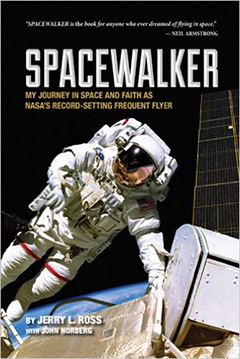 Explanations include the fact that it was the first university in the country with its own airport (beginning in 1930) and the reputation of its engineering program, which included early leadership in aero engineering.
Explanations include the fact that it was the first university in the country with its own airport (beginning in 1930) and the reputation of its engineering program, which included early leadership in aero engineering.
John notes that when Grissom arrived on campus in 1946 - and Armstrong a year later - the word "astronaut" was "an obscure, science fiction term." Rather than dreaming of flying in space, they hoped to be military fighter pilots and test pilots.
By the way, not all of the Indiana natives who became astronauts have been Purdue grads. Three attended the University of Notre Dame, and one went to DePauw University.
According to our guest John Norberg, Purdue has had a total of 23 astronaut graduates. Its rival as a non-military "Mother of Astronauts" institution is the Massachusetts Institute of Technology (MIT). The U.S. Air Force Academy and the Naval Academy have graduated the most astronauts.
Of the 12 people who have walked on the moon, two have been Purdue grads. They are Neil Armstrong, who was 17 years old when he arrived at Purdue in the fall of 1947, and Eugene Cernan, the last man to have walked on the moon. Although Armstrong cherished privacy, John notes he returned often to the Purdue campus before his death in 2012.
"In the late 1990s, when he started seeing his autograph selling for thousands of dollars, he stopped signing them," John says. "However, he spent much time talking to students and always posed for photographs with them. ... The last time I saw him, I had pizza at Bruno's in West Lafayette with him and Gene Cernan."
John adds that Purdue's history in flight stretches clear back to a 1908 graduate, Cliff Turpin, who helped the Wright Brothers redesign their airplane and controls.
Other books by John Norberg include Wings of Their Dreams: Purdue in Flight (Purdue University Press, 2003).
Previous Hoosier History Live shows that have featured John as a studio guest include a program in 2013 about aviator Amelia Earhart's connections to Indiana, including Purdue.
Roadtrip: Fort Ouiatenon
Guest Roadtripper Jeff Kamm tells us that with Hoosier History Live's topic focusing on the "final frontier" with astronauts from Purdue, he'll take us to an "early frontier" settlement near Purdue: Fort Ouiatenon.
The fort was established by the French in 1717 as a stronghold against British expansion. The settlement thrived and may have had some 3,000 residents, including Native Americans, and it was central to a hub of five Wea and two Kickapoo villages. In September of 1760 New France surrendered to the British during the French and Indian War.
As late as 1778, Ouiatenon was a staging ground for war parties fighting on behalf of the British government. During the 1780s, however, local Indian tribes used it as a base of operations to stage raids against American settlers pushing westward.
The fort was eventually destroyed by American militia forces and forgotten about. In 1930, the fort blockhouse was reconstructed and serves as a museum.
History Mystery
In 2003, international attention focused on a popular astronaut who grew up in Bedford, Indiana.
 This astronaut did not attend Purdue University, though. After graduating from Bedford High School in 1974, he attended the U.S. Naval Academy and earned a degree in aerospace engineering.
This astronaut did not attend Purdue University, though. After graduating from Bedford High School in 1974, he attended the U.S. Naval Academy and earned a degree in aerospace engineering.
Worldwide attention focused on him in 2003 because he was living on the International Space Station when an explosion of the Challenger shuttle killed seven astronauts as they were returning to Earth. The tragedy grounded the shuttle fleet and delayed the return to Earth of the astronaut. Finally, he and two crew members returned in a tiny space capsule that missed its targeted landing site.
His capsule eventually came down on land in Kazakhstan. Previously, every U.S. capsule had landed in water. Fortunately, the astronaut from Bedford was not injured.
In 2010, he was inducted into the Astronaut Hall of Fame.
Question: Who is he?
The prize pack includes two admissions to the Indianapolis Museum of Art, four admissions to the Indiana Experience at the Indiana History Center, and a gift certificate to Bee Coffee Roasters, all courtesy of Visit Indy.
The grave in the road
|
(June 18, 2016) - It has been a landmark for nearly 185 years in Johnson County.
A county road splits to avoid the burial site of a farmer's wife who died in 1831. Her grandson guarded the grave with a shotgun during the early 1900s when county officials were moving other graves to a new cemetery so they could create County Road 400S near the town of Amity.
Known as "The Grave in the Road", the burial site is in the news again because archaeologists have been excavating as part of a project to widen the road and make it safer for motorists. The team is being led by University of Indianapolis archaeologist and biological anthropologist Dr. Christopher Schmidt. Chris, the director of the Indiana Prehistory Laboratory, is Nelson's studio guest.
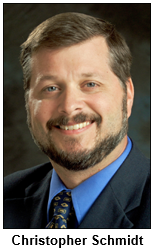 So is David Pfeiffer, executive director of the Johnson County Museum of History. He shares insights about county history during the era and early pioneers. They included Nancy Kerlin Barnett, the farmer's wife who died in 1831. According to news reports, her final request was to be buried on the site near Sugar Creek, which then was a grassy hill. After the county road was created, a marker was erected on the gravesite to signify its local importance.
So is David Pfeiffer, executive director of the Johnson County Museum of History. He shares insights about county history during the era and early pioneers. They included Nancy Kerlin Barnett, the farmer's wife who died in 1831. According to news reports, her final request was to be buried on the site near Sugar Creek, which then was a grassy hill. After the county road was created, a marker was erected on the gravesite to signify its local importance.
As the work has progressed, Chris and his UIndy archaeology team have discovered the remains of at least six other people in the gravesite, according to news accounts. As it turns out, the gravesite of Mrs. Barnett actually may have been part of a small Barnett family cemetery. The remains are of two women, a man and four children.
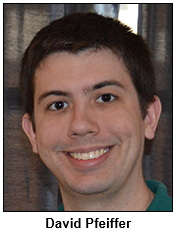 In addition to sharing insights about the temporary move of Nancy Barnett's remains - which will be lowered for increased protection - Chris discusses general issues involved in sensitive excavations. Credited with discovering the oldest known man-made tool on Hoosier soil, Chris has been a popular guest on previous Hoosier History Live shows. They include a program in September 2012 that explored the ancient people who lived more than 10,000 years ago in the densely wooded forests that became Indiana.
In addition to sharing insights about the temporary move of Nancy Barnett's remains - which will be lowered for increased protection - Chris discusses general issues involved in sensitive excavations. Credited with discovering the oldest known man-made tool on Hoosier soil, Chris has been a popular guest on previous Hoosier History Live shows. They include a program in September 2012 that explored the ancient people who lived more than 10,000 years ago in the densely wooded forests that became Indiana.
"What makes this so important is it's in the hearts of so many people," Chris told The Franklin Daily Journal, referring to the excavation of Nancy Kerlin Barnett. The examination of her remains - before reburial - is expected to result in insights about Indiana life during the 1830s.
According to our guest David Pfeiffer, a history of Johnson County written in the 1880s "lists William Barnett as arriving in the county, presumably with Nancy Kerlin Barnett, in 1822."
David reports that Johnson County's population at its founding in 1822 was about 500; it had increased to about 4,000 by 1830, the year before Nancy Kerlin Barnett died.
Her descendants were consulted about the excavation and roadway widening process. According to news accounts, the gravesite has been disrupted by accidents when motorists missed the jog as well as by large vehicles, including farm equipment, as they traveled along the county road. 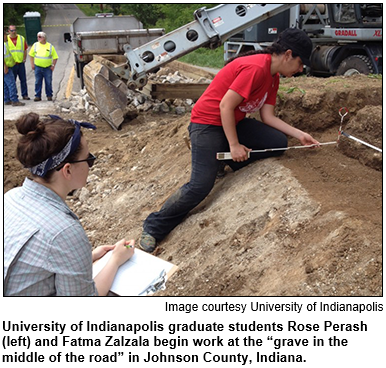 After the road is made safer, Barnett's gravesite will remain in the middle of it.
After the road is made safer, Barnett's gravesite will remain in the middle of it.
A portion of the project's cost was funded by the Johnson County Historical Society. It's the non-profit that also supports the Johnson County Museum of History, which is located in a former Masonic temple in Franklin. The museum has interactive exhibits, including a replica Conestoga wagon that children can walk through to experience pioneer life during the 1800s; it also houses a genealogy and local-history library.
"The Grave in the Road" came up during a Hoosier History Live show; a caller asked about it during a program in June 2013 about Lost Cemeteries across Indiana.
According to the marker on the burial site, several nearby graves were moved in 1905 when the county road was created. Donald Doty, the grandson of Nancy Kerlin Barnett (1793-1831), stood vigil with a gun to protect her remains.
Nancy and William Barnett lived in Blue River Township, according to David Pfeiffer. When Johnson County was created in 1822, he reports, "Settlements centered on the White River in the northwest, the Blue River and Nineveh."
The first white pioneer of Johnson County is considered to have been John Campbell, who settled near Edinburgh in 1820.
The project underway, in addition to widening the county road, involves lowering the gravesite of Nancy Kerlin Barnett and adding a protective barrier to the burial site, which, as The Indianapolis Star put it, "looks like a short highway median."
Learn more:
- Lost cemeteries - June 1, 2013 Hoosier History Live program.
- "Remains of seven found in grave in middle of road" - News account in The Indianapolis Star, June 14, 2016.
- "Shocking discovery at gravesite of woman buried in middle of Amity road" - WISH-TV story from June 13, 2016.
Roadtrip: Heslar Naval Armory on White River in Indianapolis
|
Guest Roadtripper Robin Knop, Community Relations Director of Herron High School in Indianapolis, suggests a Roadtrip to Heslar Naval Armory, formerly Naval Reserve Armory, which was constructed on the banks of the White River in Indianapolis in 1936 as a WPA project. It was designed by architect Ben H. Bacon and reflects an Art Moderne style. It is located just north of where 29th Street crosses the White River.
The armory was taken over from the U.S. Navy Reserves by the Department of the Navy in 1940 at the onset of World War II. The Naval Reserve Armory became a national training center for the next five years, turning out more than 1,000 radio operators. The sailors, who referred to the armory as "the ship," trained on a simulated navigation bridge, with actual signal hoists, lights, magazine, battle telephones, boiler room, radio communications room, ship's ladder and galley. The only thing missing was the ocean!
And men from outside Indiana were likely to be amused at the idea of a naval installation so far away from salt water; they referred to themselves as "White River Commandos."
Rumors persist that the armory may have been a top-secret planning site in developing the U.S. Navy's war strategy during World War II.
Robin will also be asking Hoosier History Live listeners to attend an open house and tour of Heslar Naval Armory on Thursday, June 23, from 5:30 to 7:30 p.m. Herron High School is hoping that the Naval Armory could become a potential new site for a second Herron High School campus.
Herron's current site is at the former historic home of the Herron School of Art and Design, just north of downtown Indianapolis.
And when you come, bring your historic Indiana photos for another scan-a-thon by the Indiana Album!
History Mystery
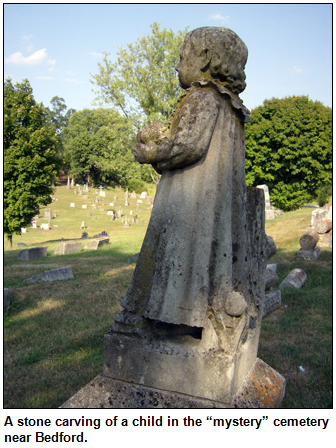 A cemetery in southern Indiana has been called a "tombstone tourist's delight" and an "outdoor sculpture park."
A cemetery in southern Indiana has been called a "tombstone tourist's delight" and an "outdoor sculpture park."
The cemetery, which dates to the 1880s and is located near Bedford in Lawrence County, features dozens of personalized monuments that were created for the gravesites of local residents.
Because the area is known as the "Limestone Capital of the World," generations of highly skilled stone cutters were available to carve sculptures memorializing the deceased. For example, the cemetery, which is on scenic, rolling terrain, includes sculptures of a golfer, a World War I doughboy and the tools of a limestone cutter on various burial sites.
Question: Name the historic cemetery near Bedford.
The prize pack includes two tickets to the Catacombs Tour under the Indianapolis City Market, and a gift certificate to Burgerhaus on the downtown canal in Indianapolis, all courtesy of Visit Indy.
Bicentennial bucket list
(June 11, 2016) - Do your pipe dreams involve sleeping in a historic building that served as a county jail for nearly 120 years? Would you enjoy donning vintage jail clothes and uniforms during your visit?
En route to the Old Jail Inn in Parke County, you could swing by the largest railroad bridge in the nation.  Constructed in 1906 by Italian immigrant laborers, the Tulip Trestle Bridge is in Greene County in western Indiana. The steel-girded railroad bridge is 2,307 feet long and 157 feet tall.
Constructed in 1906 by Italian immigrant laborers, the Tulip Trestle Bridge is in Greene County in western Indiana. The steel-girded railroad bridge is 2,307 feet long and 157 feet tall.
According to Visit Greene County, that makes the Tulip Trestle (known locally as "the Viaduct") the largest in the country. Graffiti on it includes the question: "Michelle, Will You Marry Me?"
The Old Jail Inn, which was built in the 1870s, and the Tulip Trestle Bridge are among 200 "bucket list" destinations or experiences that Visit Indiana is touting as "musts" as Indiana celebrates its bicentennial this year.
The bucket list by Visit Indiana (the Indiana Department of Tourism) includes well-known destinations such as the West Baden Springs Hotel in Orange County, the Indiana High School Basketball Hall of Fame in New Castle and the Decatur County Courthouse, which has a tree growing out of its roof in Greensburg.
Rather than exploring those sites - which have been the focus of previous Hoosier History Live shows - we delve into little-known destinations or fresh experiences on the bucket list, particularly those with historic aspects.
They include a trip to the restaurant considered the oldest in Indiana.
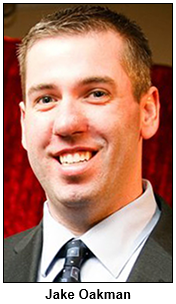 It's the Log Inn, which was built as a stagecoach stop and trading post in 1825 in the tiny town of Haubstadt about 12 miles north of Evansville. According to folklore, the Log Inn was patronized by Abraham Lincoln in 1844 during a speaking tour to tout Henry Clay as the Whig Party's presidential candidate. (By then, Lincoln would have been a resident of Illinois for more than 20 years. But young Abe had lived with his family in southern Indiana beginning in 1816, the same year we became the 19th state.) The Log Inn serves fried chicken, ham and roast beef.
It's the Log Inn, which was built as a stagecoach stop and trading post in 1825 in the tiny town of Haubstadt about 12 miles north of Evansville. According to folklore, the Log Inn was patronized by Abraham Lincoln in 1844 during a speaking tour to tout Henry Clay as the Whig Party's presidential candidate. (By then, Lincoln would have been a resident of Illinois for more than 20 years. But young Abe had lived with his family in southern Indiana beginning in 1816, the same year we became the 19th state.) The Log Inn serves fried chicken, ham and roast beef.
To share details about the Log Inn and other "bucket list" sites and experiences, Nelson is joined in studio by Jake Oakman, who has been Visit Indiana's communications director. Jake recently became media relations director for Lt. Gov. Eric Holcomb, who oversees tourism.
The bucket list is topped by the Old Jail Inn, an Italianate structure that served as the Parke County Jail from 1879 to 1998; for much of that time, it also was the residence of county sheriffs and their families. In 2010, the Old Jail Inn opened as a bed-and-breakfast where guests are encouraged to don original jail clothes and uniforms.
The state's bucket list is divided into destinations and "must do" experiences, such as dining at the Log Inn. Experiences also include participating in the massive raft race at Fort Wayne's popular Three Rivers Festival. Fort Wayne, Indiana's second-largest city, is located at the confluence of three rivers (the St. Mary, St. Joseph and the Maumee), accounting for the name of the festival. It has been a popular annual event since 1969; this year's Three Rivers Festival will be July 8-16.
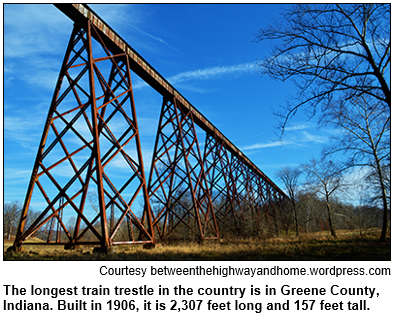 In addition to the oldest restaurant in the state, the bucket list includes the oldest billboard. Erected during the 1930s, the billboard touts Clabber Girl Baking Soda and is located just east of Terre Haute. (The billboard still has a working clock.) In downtown Terre Haute, Clabber Girl, owned by the Hulman family, also has a museum about the baking powder and the company, which diversified tremendously under Tony Hulman (1901-1977). A multimillionaire, Hulman bought the Indianapolis Motor Speedway after World War II and revitalized the racetrack.
In addition to the oldest restaurant in the state, the bucket list includes the oldest billboard. Erected during the 1930s, the billboard touts Clabber Girl Baking Soda and is located just east of Terre Haute. (The billboard still has a working clock.) In downtown Terre Haute, Clabber Girl, owned by the Hulman family, also has a museum about the baking powder and the company, which diversified tremendously under Tony Hulman (1901-1977). A multimillionaire, Hulman bought the Indianapolis Motor Speedway after World War II and revitalized the racetrack.
Terre Haute also is the home of another bucket list destination, the CANDLES Holocaust Museum. Founded by Terre Haute resident Eva Mozes Kor, a survivor of the Nazis' notorious experiments on twins during World War II, the museum is dedicated to telling the stories of the experiments overseen by Dr. Josef Mengele and preventing future atrocities.
During our show, Jake and Nelson also discuss Wolf Park in the town of Battle Ground near Lafayette. A bucket list destination, Wolf Park is an education and research facility that is the home for packs of gray wolves, coyotes and foxes. The park periodically hosts "Howl Nights" with the wolves.
During previous Hoosier History Live shows about the bicentennial, we have focused on grassroots projects under way in counties and towns across the state. Our guests have included Indiana's first lady, Karen Pence, who is serving as the bicentennial ambassador, and Perry Hammock, executive director of the Indiana Bicentennial Commission.
Learn more:
- Visit Indiana - Website of the Indiana Office of Tourism Development, Indiana's official travel-planning source.
Roadtrip: RV life in Central Indiana
|
Guest Roadtripper and foodie favorite Daina Chamness tells us: "We all know about state parks, but what about some of the private campgrounds in central Indiana as getaway spots?"
Daina and husband Larry are retired, or semi-retired, and enjoy visiting "bucket list" attractions across the country, as well as locally, in a travel trailer. They spent a couple of winter months in New Mexico, and they are looking to possibly live completely on wheels in a 5th-wheel recreational vehicle.
"Like gypsies," says Daina. "We can spend summers at a campground in central Indiana, and our kids can come to visit us there."
Last week Daina and Larry looked at Greenfield KOA, S&H Campground and Heartland Resort, all very near to Indianapolis but also out in the country. You also can find information about RV camping in central Indiana at Camp Indiana.
History Mystery
The bicentennial "bucket list" put together by Visit Indiana includes a popular museum of classic cars that's located in a small town in a far corner of the state.  The town, which has a population of about 13,000 people, was the headquarters of an automobile company during the 1930s.
The town, which has a population of about 13,000 people, was the headquarters of an automobile company during the 1930s.
The museum, which typically exhibits 120 cars made in Indiana, is located in the former company's Art Deco-style headquarters building. It has been designated a National Historic Landmark.
Question: Name the small Indiana town known for its museum of vintage cars.
Hints: It is not South Bend or Kokomo, which also have museums devoted to auto heritage.
The prize pack includes two tickets to the Indianapolis Zoo, a gift certificate to Claddagh Irish Pub, and four admissions to The Indiana Experience at the Indiana History Center, all courtesy of Visit Indy.
8-year soiree on Feb. 25 was historical fun
|
(March 2016) - Photos continue to roll in from the Feb. 25 Hoosier History Live party to celebrate our 8 years on the air. This week's featured image is of Indianapolis Mayor Joe Hogsett with the four fine young musicians of the Herron String Quartet who provided such lovely music in the entry hall at Indiana Landmarks Center as the event got under way.
If you have a good photo that you would allow us to use for publication in our e-newsletter and website, please consider emailing it to us at news@hoosierhistorylive.org. Do include the name that is to receive credit.
Thanks again to corporate supporters Indiana Landmarks and Jacquie's Gourmet Catering, as well as event sponsor Core Redevelopment.
Thanks also to individual contributors Anne Laker, Jim and Marjorie Kienle, Dennis Arbuckle, Joe Young, Kathleen Angelone, J. Scott Keller, Jennifer Q. Smith of AvantGarb, Georgia Cravey and Jim Lingenfelter, Barbara and Michael Homoya, Margaret Smith, Peggy Hollingsworth, Lorraine Vavul, Rita Kohn and William McNiece.
Presenters included CEO of Indiana Landmarks Marsh Davis, Indianapolis Mayor Joe Hogsett, WICR program director Henri Pensis and Indiana Bicentennial Commission Executive Director Perry Hammock, as well as host Nelson Price and producer Molly Head of Hoosier History Live.
Catering was provided by Jacquie's Gourmet Catering, and entertainment was provided by Shirley Judkins, Herron High School String Quartet and Janet Gilray of Voices in Time. Thanks to corporate supporters Indiana Landmarks and Core Redevelopment.
As a nod to the many Indiana ethnic heritage shows produced by Hoosier History Live over the years, guests were invited to dress to portray their ethnic heritage. A shout-out to the Scots, Greeks, and Germans in attendance! And thanks to Jan Wahls for portraying May Wright Sewall.
Your encouragement and participation, on all fronts and in myriad ways, are what keep us going - on the air, in your in-box and on the web. Thanks!
|
World War II vets look back
|
(June 4, 2016) - Periodically on Hoosier History Live, we salute Hoosiers who served during what has been called "the most significant and influential event of the 20th century" by inviting survivors to share insights about their lives before, during and after World War II.
 Our guests on this show are two central Indiana residents in their 90s - veterans of the Army Air Force and the Navy - as well as a chaplain who has included their stories in a new book.
Our guests on this show are two central Indiana residents in their 90s - veterans of the Army Air Force and the Navy - as well as a chaplain who has included their stories in a new book.
Ron May, a chaplain and pastor based in Avon, is the author of Our Service, Our Stories (Fideli Publishing). Ron, who spent 22 years as a Navy reserve chaplain, joins Nelson in studio, along with:
- Paul Maves, a retired civil engineer who lives on the west side of Indianapolis. During World War II, he was a bombardier with the Army Air Force and served with a squadron that provided aerial support during the Battle of the Bulge in December 1944.
- And Walter Dreyfus of Greenwood, who is retired from the insurance industry. A Navy veteran, Walter served on ships off North Africa, Italy, England and France. He helped ready some minesweeper ships for the D-Day invasion and helped retrieve - and do sea burials for - bodies found after the historic invasion.
As a bombardier, Paul flew on 41 missions in France, Holland and Germany. According to Our Service Our Stories, he initially was disqualified for bombardier training because he was left-handed. ("Bombardiers had to learn to use the Norden Bomb Sight, which could only be operated by the right hand.")
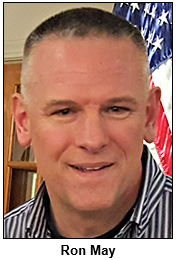 He persevered and went on to serve on B-26 bombers; close calls included a mission on a hobbled aircraft that endured more than 300 strikes from German artillery.
He persevered and went on to serve on B-26 bombers; close calls included a mission on a hobbled aircraft that endured more than 300 strikes from German artillery.
Walter served in radio communications on the Navy ships; on land in France, he was part of a reconnaissance party ambushed by Germans. 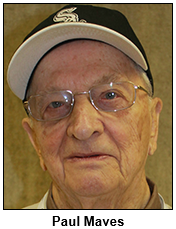 (He survived by hiding in a ditch.) In Cherbourg, Walter met Catherine Fox, a WAC from Indianapolis. They later married and, before Catherine's death in 2013, returned to France for the 50th and 60th anniversaries of Cherbourg's liberation.
(He survived by hiding in a ditch.) In Cherbourg, Walter met Catherine Fox, a WAC from Indianapolis. They later married and, before Catherine's death in 2013, returned to France for the 50th and 60th anniversaries of Cherbourg's liberation.
Both Paul and Walter have participated on Indy Honor Flights to Washington D.C. Our guest Ron May accompanied Hoosier veterans on one of the flights.
In the prelude to his book, Ron notes that of the 16 million service members who fought in WWII, only about 850,000 are still alive. About 500 pass away daily.
As a Navy reserve chaplain, Ron served 10 military units before retiring in 2012. He currently serves as the chaplain at Hoosier Village Retirement Community in Zionsville and as the hospice chaplain at Paradigm Living Concepts in Indianapolis. His book Our Service Our Stories features the memories of 36 World War II veterans; he is working on a second volume.
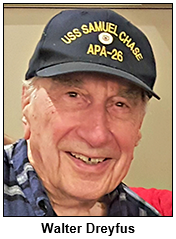 According to Paul Maves' account in the book, the close call with his B-26 occurred over Germany when the aircraft's engine started malfunctioning, forcing the crew to descend to a low and dangerous altitude. They were unable to keep up with other planes in their squadron and found themselves alone over enemy territory in twilight. After 300 strikes on their B-26, the crew was able to guide it safely back to France.
According to Paul Maves' account in the book, the close call with his B-26 occurred over Germany when the aircraft's engine started malfunctioning, forcing the crew to descend to a low and dangerous altitude. They were unable to keep up with other planes in their squadron and found themselves alone over enemy territory in twilight. After 300 strikes on their B-26, the crew was able to guide it safely back to France.
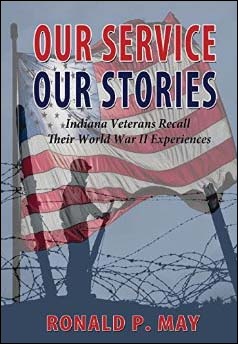 After returning from the war, Paul married his wife, Shirley, who died in 2003.
After returning from the war, Paul married his wife, Shirley, who died in 2003.
Our guest Walter Dreyfus installed and maintained radio and radar equipment on Navy ships during World War II. As D-Day approached, Walter and other radio techs went from one minesweeper ship to another, changing radio crystals so Germans could not intercept their communications.
Two weeks after D-Day, Walter and other Navy personnel had the task of retrieving bodies still on Omaha Beach after the amphibious landing. Then, the bodies were buried at sea in canvas bags.
The 72nd anniversary of D-Day will be June 6.
Previous Hoosier History Live shows featuring interviews with veterans of WWII have included programs in January 2014 and February 2015. Guests on those shows included veterans whose stories are shared, respectively, in the books World War II: Duty, Honor, Country and World War II Legacies: Stories of Northeast Indiana.
Learn more:
- Reflections of World War II veterans - Hoosier History Live newsletter for the Feb. 28, 2015 show featuring WWII vets Don Shady, Bob Foster (now deceased) and author Kayleen Reusser, all of northern Indiana.
- World War II veterans remember - Hoosier History Live newsletter for the Jan. 11, 2014 show featuring WWII veteran Merrill "Lefty" Huntzinger of Noblesville (now deceased) and authors Steve Hardwick and Duane Hodgin.
- Indy Honor Flight - This non-profit organization transports Indiana veterans to Washington, D.C. to visit and reflect at their memorials. Top priority is given to the senior veterans - World War II survivors, along with those veterans who may be terminally ill.
Roadtrip: Evansville's riverfront esplanade
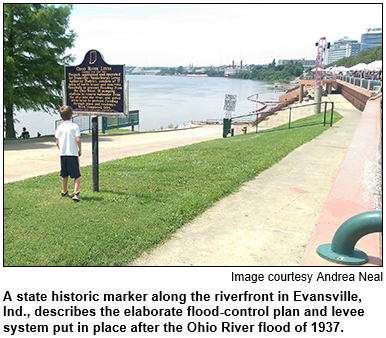 Guest Roadtripper and author and educator Andrea Neal tells us: "A walk along Evansville's riverfront esplanade evokes memories of the worst natural disaster in the history of the Ohio River: The Great Flood of 1937."
Guest Roadtripper and author and educator Andrea Neal tells us: "A walk along Evansville's riverfront esplanade evokes memories of the worst natural disaster in the history of the Ohio River: The Great Flood of 1937."
The levee is the most visible reminder. It was built by the U.S. Army Corps of Engineers to protect the city from a future catastrophe. For 17 miles, earth embankments and concrete floodwalls serve as a border between the people of Vanderburgh County and the river. There's a staff gauge on the pump house hash-marked to 54 feet, the height where the 1937 floodwaters finally stopped rising after 22 days above flood level.
"For the people who experienced the flood, this was the most dramatic experience of their life, other than World War II," says historian Robert L. Reid. "The rains started in December, and they kept coming and they kept coming and they kept coming until, by the middle of January, the Ohio was above flood stage virtually everywhere."
The rain combined with sleet and snow to create a hazardous scene all along the Ohio, from Pittsburgh to Cairo, Illinois.
Water covered 70 percent of Louisville, 90 percent of Jeffersonville and most of New Albany. The flood killed 385 people in all, leaving 1 million homeless and causing $250 million in property damage ($3.4 billion today), according to one National Weather Service estimate. Amazingly, though Evansville was among the hardest hit, no one drowned in Vanderburgh County.
In August of 1937, Congress passed the Flood Protection Act to ensure nothing like the Great Flood would happen again. Evansville's $55 million project, begun in 1939 and not completed until 1994, features raised levees, 20 pumping stations and a system of closeable gates and sandbag structures that automatically activate when the river reaches a level that prevents normal drainage.
Sightseers can read about the flood thanks to historic markers along the 1.5-mile walkable riverfront trail that starts at Sunrise Park at the intersection of Waterworks Road and Riverside Drive and goes by the Evansville Museum of Art, History and Science at 411 S.E. Riverside Drive.
History Mystery
A World War II veteran who returns to his Indiana hometown is the major character in a movie that was filmed during the late 1950s in the Hoosier state.  The Army veteran was portrayed by Frank Sinatra, who, along with other major celebrities, came to a city in Indiana for on-location filming.
The Army veteran was portrayed by Frank Sinatra, who, along with other major celebrities, came to a city in Indiana for on-location filming.
The movie, which was based on a bestselling novel, was nominated for five Academy Awards. Although the veteran's Indiana hometown had a fictional name in the novel and movie, the real city that served as the filming site reaped significant publicity during the late 1950s. Several of the city's landmarks, including its courthouse, are visible in the movie.
Question: Name both the movie and the Indiana city where it was filmed.
The prize pack includes two tickets to the James Whitcomb Riley Museum and Home and a gift certificate to Arni's Restaurant, all courtesy of Visit Indy.
Roadside architecture
|
(May 28, 2016) - In this show, Hoosier History Live "patronizes" drive-in restaurants that have been cherished by generations of Hoosiers in West Lafayette, Logansport and the eastside of Indy.
The show also explores drive-in movie theaters that still are going strong in Morgan County and on Bass Lake in far-northern Indiana.
 And we make a "pit stop" at a miniature golf course that opened during the 1930s on what's now the suburban south eastside of Indy. For decades, though, getting there involved a jaunt to the "countryside" for patrons.
And we make a "pit stop" at a miniature golf course that opened during the 1930s on what's now the suburban south eastside of Indy. For decades, though, getting there involved a jaunt to the "countryside" for patrons.
All are surviving examples of roadside architecture that has been vanishing from the Indiana landscape as chain-owned eateries and retailers - with standardized buildings and signage - have multiplied. Roadside architecture, both bygone and lingering across the Hoosier state, is the focus of our show, with two historic preservationists as Nelson's guests.
Triple XXX Family Restaurant, which opened in 1929 in West Lafayette and touts itself as "Indiana's oldest drive-in," isn't just known for its root beer, burgers and shakes. The landmark, which has been featured on the Food Network's "Diners, Drive-Ins and Dives" show, also is cherished for its roadside ambience.
Ditto for the Char-Bett Drive In in Logansport, with its eye-catching red and white awning and distinctive sign that features a looping red arrow.
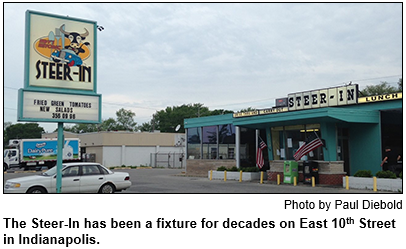 To share details about these and other roadside gems - as well as reasons to preserve vestiges of vanishing Americana - Nelson is joined in studio by:
To share details about these and other roadside gems - as well as reasons to preserve vestiges of vanishing Americana - Nelson is joined in studio by:
- Paul Diebold of the Indiana DNR's division of historic preservation and archaeology. Paul recently gave a presentation about the need to preserve roadside architecture to the Irvington Historical Society. Previously on Hoosier History Live, he has been a guest on shows about Sears Kit Homes and the historic Irvington neighborhood in Indy.
- And public historian Glory-June Greiff, an author who has been a frequent guest (and Roadtripper) on Hoosier History Live programs. They include shows about the history of Indiana's state parks - Glory is the author of People, Parks and Perceptions (Trafford Publishing) and the heritage of U.S. 40 (the National Road) and the Lincoln Highway. Her other books include Remembrance, Faith and Fancy (Indiana Historical Society Press), which explores outdoor statues and sculptures across Indiana.
Sometimes distinctive statues - or other signage - are part of the roadside appeal of the sites we explore.
But in some cases, the roadside destination's distinction is due other factors.  That's so, Paul says, with the miniature golf course known as Rustic Gardens when it opened in far-southeastern Marion County in 1932. It's now called Rustic Driving Range & Miniature Golf Inc.
That's so, Paul says, with the miniature golf course known as Rustic Gardens when it opened in far-southeastern Marion County in 1932. It's now called Rustic Driving Range & Miniature Golf Inc.
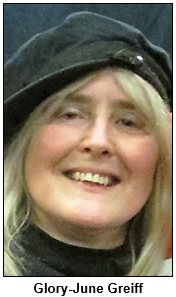 "The roadside appeal of Rustic Gardens is that, when founded and until the 1960s, it was a trip to the countryside to get there," Paul says. "And by 'trip,' I mean there were no rail lines to get there. It was a 'destination' roadside place."
"The roadside appeal of Rustic Gardens is that, when founded and until the 1960s, it was a trip to the countryside to get there," Paul says. "And by 'trip,' I mean there were no rail lines to get there. It was a 'destination' roadside place."
Other roadside destinations include drive-in movie theaters that survive even as so many have closed across Indiana during the last 30 years. Glory discusses the CenterBrook Drive-In (which opened in 1950 with a name derived from its location between the Morgan County towns of Centerton and Brooklyn) and the Melody Drive-In on U.S. 35 at Bass Lake in Starke County.
Speaking of the derivation of names: According to the Triple XXX, the restaurant was named for a brand of root beer popular during the early 1900s. Root beers then were ranked with X ratings, with one X being good, two better "and three X's best of all."
Other drive-in restaurants on our roadside show's menu include the Steer-In, which opened in 1960 at 5130 E. 10th Street in Indy. With a sign that depicts the head of a steer (horns and all), the Steer-In also has been featured on the Food Network, which praised its meatball sandwiches and beef and noodles.
Several years ago, our guest Glory-June was the central Indiana escort for John Margolies, generally considered the country's premiere author-photographer of roadside architecture. His books include See The USA (Chronicle Books) and Fun Along the Road (Bulfinch Press).
Roadside stops on our radio journey include:
- The Sycamore Drive-In in Logansport.
- The Original Frozen Custard, an ice cream parlor in Lafayette. It opened as a custard stand in 1932.
- And Mrs. Curl Ice Cream Shop and Outdoor Cafe in Greenwood.
Also during the show, our host, Nelson, shares details about mimetic architecture, in which a building's design mimics the roadside services or products it offers. Several long-gone examples of mimetic architecture are featured in his Indianapolis Then and Now visual history book (Pavilion Books), including Polks Sanitary Milk Company. The corners of the bygone dairy's headquarters on the near-northside of Indy were shaped like giant milk bottles.
Learn more:
- Ice Cream Sodas, a Carousel, and Two Rivers: My Logansport - Blog entry by Glory-June Greiff.
- Lincoln Highway and U.S. 40 Heritage - Hoosier History Live newsletter, Sept. 21, 2013.
- RoadsideArchitecture.com - "Buildings, signs, statues and more."
|
Roadtrip: McCormick's Creek near Spencer
 Guest Roadtripper Terri Gorney of Fort Wayne tells us that Indiana is celebrating the centennial of our state parks.
Guest Roadtripper Terri Gorney of Fort Wayne tells us that Indiana is celebrating the centennial of our state parks.
"The idea of a state park system was conceived by Richard Lieber in 1910," says Terri. "He wanted at least one state park for the 100th birthday of Indiana's statehood in 1916."
Lieber would later be named the "Father of Indiana State Parks."
The distinction of the first state park goes to McCormick's Creek State Park. It was named after the first owner of the property, John McCormick, who purchased 450 acres in Owen County in 1816. In 1888, the land was purchased and a sanitarium was built. The land was offered to the state for a bargain price of $5,250. Private funds paid for the land in May 1916.
McCormick's Creek has beautiful limestone canyons, waterfalls and forests. A Stone Arch Bridge was created by the Civilian Conservation Corps (CCC) in the 1930s. The park also includes a nice inn and a nature center.
Today, all Hoosiers live within a one-hour drive from a state park.
Many special events are planned this summer to celebrate the park's Centennial.
Says Terri: "I would encourage everyone to enjoy McCormick's Creek or one of our other parks this year."
Learn more:
History Mystery
 For generations of Indianapolis residents, the Tee Pee Restaurant was a distinctive roadside landmark near the Indiana State Fairgrounds. Marsh Davis, president of Indiana Landmarks, has called the Tee Pee, which was demolished in the late 1980s, a "fine example of whimsical roadside architecture."
For generations of Indianapolis residents, the Tee Pee Restaurant was a distinctive roadside landmark near the Indiana State Fairgrounds. Marsh Davis, president of Indiana Landmarks, has called the Tee Pee, which was demolished in the late 1980s, a "fine example of whimsical roadside architecture."
The drive-in restaurant was so popular - particularly during the heyday of the "cruising" era of the 1950s and ‘60s - that a second Tee Pee was opened on the city’s south side with nearly the same, distinctive architectural design.
But when the original restaurant opened during the 1930s, its name was not the Tee Pee. Instead, the iconic restaurant had a different name associated with Native Americans.
Question: What was the Tee Pee Restaurant's initial name?
The prize pack includes two tickets to the Indiana Medical History Museum and two tickets to ComedySportz, courtesy of Visit Indy, and a gift certificate to Empire Pizzeria in Kirklin, Indiana, (with lots of antique shops on Main Street!), courtesy of Empire Pizzeria.
Tell them Hoosier History Live sent you!
Postcards from Indiana
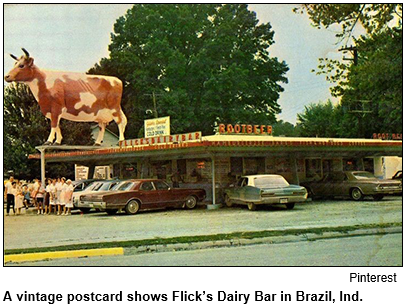 (May 21, 2016 - encore presentation) - Here's a dispatch to send far and wide: Beginning in the late 1800s and early 1900s, almost every small town in Indiana had its own postcard.
(May 21, 2016 - encore presentation) - Here's a dispatch to send far and wide: Beginning in the late 1800s and early 1900s, almost every small town in Indiana had its own postcard.
So did landmark buildings and institutions. Not just hotels, spas, restaurants and drug stores, but sanitariums, prisons and asylums, as well.
Also during that era, one of the country's most popular postcard artists was based in Indianapolis, as Nelson and his guests discuss during this show, which originally was broadcast Aug. 15, 2015.
"In the century before Twitter, text messaging and Snapchat, people who wanted to send a short and concise message simply picked up a postcard at the newsstand or drugstore and dropped it in the mail," notes Indianapolis attorney Libby Cierzniak in an article for historicindianapolis.com. Libby, a partner at Faegre Baker & Daniels, collects vintage photos, postcards, advertising and other memorabilia about the Hoosier capital.
During our show, she shares insights about Cobb X. Shinn, an Indy-based artist of the early 1900s who designed nationally distribute postcards. Although her research indicates Shinn was creating more than 400 different designs annually by 1912, he specialized in postcards that depicted frogs dressed in formal attire.
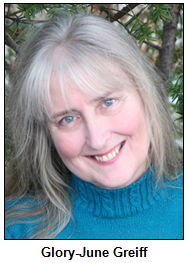 In addition to Libby, Nelson's guests are two members of the Indianapolis Postcard Club:
In addition to Libby, Nelson's guests are two members of the Indianapolis Postcard Club:
- Glory June Greiff, a public historian and author who uses Indiana postcards (Glory estimates that she owns more than 2,000) for her research about Indiana state parks, outdoor sculptures, roads and roadside attractions.
- And Dr. Chuck Hazelrigg, a dentist and pharmacist who collects vintage Indiana postcards of small towns, drug stores, sanitariums, asylums and even prisons.
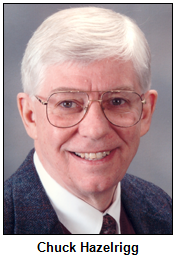 According to the Smithsonian Institution, the postcard era began in the early 1870s with the debut of government-produced, pre-stamped postal cards. (During earlier eras, so-called "mailed cards" were sent by some people who wrote notes on them.)
According to the Smithsonian Institution, the postcard era began in the early 1870s with the debut of government-produced, pre-stamped postal cards. (During earlier eras, so-called "mailed cards" were sent by some people who wrote notes on them.)
In Libby's article, she notes that the popularity of postcards boomed to such an extent that, by 1912, the U.S. Postal Service was processing an average of 8 million postcards daily.
Shinn, who was born in 1887 and studied at what was then called the John Herron Art Institute, designed thousands of the postcards. Many of his designs, according to Libby, appeared in a series of four to 16 cards that were sold as sets. They included a "Tin Lizzy" series that featured the Model T Ford. Shinn's small studio was at the corner of Ohio and Alabama streets.
Lavish buildings in Indiana that were promoted with postcards included the two world-famous resort hotels in southwestern Indiana, the French Lick Springs Hotel and the West Baden Springs Hotel. Some postcards were devoted exclusively to promoting the mineral waters available at the hotels, including Pluto water sold at French Lick.
Learn more:
- Tichnor Brothers Postcard Collection, Indiana cards.
- Smithsonian Institution.
- Indiana Historical Society.
'Hoosiers' vs. 'Indianans'
(May 14, 2016) - Are there any residents of the Hoosier state who refer to themselves as "Indianans"?
Very few, surely. That's why, in an unusual bipartisan effort these days, the state's U.S. senators, a Republican and a Democrat, are asking the federal government to change its official style manual, dropping "Indianan" in favor of "Hoosiers".
 So it's timely for Hoosier History Live to explore the origins and evolution of the terms, as well as their connotations. If "Indianans" is a mouthful, consider there were eras when an some people used an even more odd-sounding word - "Indianians" - to refer to residents of the 19th state.
So it's timely for Hoosier History Live to explore the origins and evolution of the terms, as well as their connotations. If "Indianans" is a mouthful, consider there were eras when an some people used an even more odd-sounding word - "Indianians" - to refer to residents of the 19th state.
To tackle the "Hoosiers vs. Indianans" issues, Nelson is joined in studio by:
- Ray Boomhower of the Indiana Historical Society. He's the editor of Traces of Indiana and Midwestern History, a magazine that has published articles delving into various aspects of the evolution of "Hoosier." Ray also is the author of Jacob Piatt Dunn, Jr .: A Life in History and Politics(Indiana Historical Society Press, 1997), a biography of an influential historian who researched and wrote extensively about the topic.
- And Libby Cierzniak, an Indianapolis attorney who writes for historicindianapolis.com. In a recent article, Libby described the evolution of "Indianian" and "Indianan." She also noted that, during the early 1900s, some newspapers referred to residents of the Hoosier capital as "Indianapolitans".
The word "Hoosier" has been traced to letters written during the 1820s. By the 1830s, when Richmond, Ind., poet John Finley wrote a popular poem called The Hoosier's Nest, the term apparently didn't even need to be defined for general readers.
Its origins, though, remain unclear - and probably never will be known for certain, experts say. Most Indiana natives have been told since childhood about the various theories.
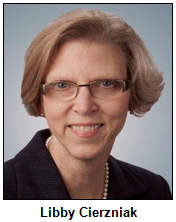 Some accounts contend "Hoosier" is a slurring of a question that early Indiana settlers asked in response to a knock on their cabin door: "Who's there?"
Some accounts contend "Hoosier" is a slurring of a question that early Indiana settlers asked in response to a knock on their cabin door: "Who's there?"
Others attribute the nickname to the slurring of a canal contractor's name; an Anglo-Saxon dialect term for "hill" and "highlander," or a Native American term for "maize."
James Whitcomb Riley, who became nationally famous as the "Hoosier Poet," even joked that the word had its origins in the brawls at taverns on the Indiana frontier. When a patron pulled out a knife and cut off another person's ear, which fell to the floor, others in the tavern supposedly inquired, "Whose ear?"
Regardless of its roots, the word "Hoosier" long ago became entrenched, and even embraced, among Indiana residents - despite the fact that some people in other regions of the country may regard it as a synonym for "rustic" or "hick." Perhaps to avoid a term that could be considered derogatory, some media outlets have used the seldom-heard "Indianans"; The New York Times has used it in stories as recently as this month.
And the style manual of the U.S. Government Publishing Office designates "Indianan" as the official term for the state's residents. U.S. Senators Dan Coats and Joe Donnelly, a Republican and Democrat respectively, are lobbying the federal government to switch to "Hoosiers" as the official term.
"This style bible for bureaucrats requires the use of the term 'Indianan' to refer to Hoosiers in all official publications of Congress, the White House and other federal agencies," our guest Libby Cierzniak, a partner at Faegre Baker & Daniels, writes in her historicindianapolis.com article.
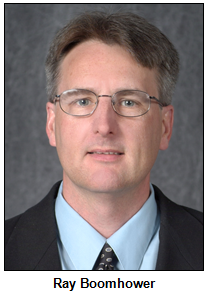 Jacob Piatt Dunn (1855-1924), the pre-eminent Indiana historian of his era, wrote a five-volume series titled "Indiana and Indianans" in which he argued for the use of "Indianan." (He particularly objected to the early use of "Indianians.")
Jacob Piatt Dunn (1855-1924), the pre-eminent Indiana historian of his era, wrote a five-volume series titled "Indiana and Indianans" in which he argued for the use of "Indianan." (He particularly objected to the early use of "Indianians.")
In any case, the term "Hoosiers" took hold and is spoken with pride by most residents of the state. It has been used in everything from the title of an iconic movie - Hoosiers (1986) often is considered the best sports movie of all time - to the nickname of Indiana University's sports teams and the initial name of the stadium for the Indianapolis Colts, the Hoosier Dome.
And "Hoosier hospitality" has been a catch phrase touted by generations of residents.
Learn more:
- Indianapolitans - As We See 'Em - A 1905 book featuring 109 full-page cartoonist caricatures of leading Indianapolis citizens. The book may be viewed in its original form on the Internet Archive.
- The Word Hoosier - Jeffrey Graf of the Indiana University Library.
- What Is a Hoosier? - Indiana Historical Society.
- The Origin of the Word "Hoosier": A New Interpretation - William D. Piersen, history professor of Fisk University, Nashville, Tenn., in the June 1995 Indiana Magazine of History.
- Introducing Black Harry Hoosier: The History Behind Indiana's Namesake - Stephen H. Webb, associate professor of religion and philosophy at Wabash College, in the March 2002 Indiana Magazine of History.
- Origin of the Word Hoosier - Jacob P. Dunn Jr. in the June 1905 Indiana Magazine of History.
Roadtrip: Oswell Wright marker in Corydon
|
Guest Roadtripper and historic preservationist Maxine Brown of Corydon is always encouraging Hoosier History Live listeners to visit the many historic sites in Corydon and southern Indiana, and especially those that have to do with early African Americans.
The Oswell Wright historical maker in downtown Corydon pays tribute to free African American Oswell Wright, who was born in Maryland in the early 1810s and bought land in Corydon in May 1849.
As did many free blacks of the time, Oswell Wright assisted other African Americans in Underground Railroad activity, and he was arrested in the process.
Learn more from Maxine Brown on Saturday. Some of her own African-American ancestors came to Corydon and Harrison County in 1814 as a group of about 100 former slaves. The group had been emancipated by their former owners, Paul and Susanna Mitchem, white farmers originally from North Carolina.
History Mystery
A distinctive type of cabinet - made in Indiana and popular across the country during the late 1800s and early 1900s - was known as a "Hoosier."
 Marketed as "step savers," Hoosier Cabinets consisted of several parts, including a slide-out shelf and multiple drawers or compartments with doors.
Marketed as "step savers," Hoosier Cabinets consisted of several parts, including a slide-out shelf and multiple drawers or compartments with doors.
Although several companies made Hoosier Cabinets, they primarily were associated with a furniture-making business located in a town east of Indianapolis. The name for the Hoosier Cabinet was derived from a company (which also had Hoosier in its name) based in the town.
Question: What is the town primarily associated with making Hoosier Cabinets?
The prize pack includes a Family 4-Pack to Conner Prairie Interactive History Park, including four tickets to the 1859 Balloon Voyage, and a gift certificate to Arnie's Restaurant, courtesy of Visit Indy.
Postcards from Indiana
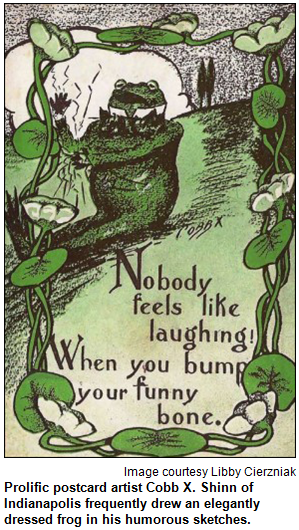 (May 21, 2016 - encore presentation) - Here's a dispatch to send far and wide: Beginning in the late 1800s and early 1900s, almost every small town in Indiana had its own postcard.
(May 21, 2016 - encore presentation) - Here's a dispatch to send far and wide: Beginning in the late 1800s and early 1900s, almost every small town in Indiana had its own postcard.
So did landmark buildings and institutions. Not just hotels, spas, restaurants and drug stores, but sanitariums, prisons and asylums, as well.
Also during that era, one of the country's most popular postcard artists was based in Indianapolis, as Nelson and his guests discuss during this show, which originally was broadcast Aug. 15, 2015.
"In the century before Twitter, text messaging and Snapchat, people who wanted to send a short and concise message simply picked up a postcard at the newsstand or drugstore and dropped it in the mail," notes Indianapolis attorney Libby Cierzniak in an article for historicindianapolis.com. Libby, a partner at Faegre Baker & Daniels, collects vintage photos, postcards, advertising and other memorabilia about the Hoosier capital.
During our show, she shares insights about Cobb X. Shinn, an Indy-based artist of the early 1900s who designed nationally distribute postcards. Although her research indicates Shinn was creating more than 400 different designs annually by 1912, he specialized in postcards that depicted frogs dressed in formal attire.
In addition to Libby, Nelson's guests are two members of the Indianapolis Postcard Club:
- Glory June Greiff, a public historian and author who uses Indiana postcards (Glory estimates that she owns more than 2,000) for her research about Indiana state parks, outdoor sculptures, roads and roadside attractions.
- And Dr. Chuck Hazelrigg, a dentist and pharmacist who collects vintage Indiana postcards of small towns, drug stores, sanitariums, asylums and even prisons.
According to the Smithsonian Institution, the postcard era began in the early 1870s with the debut of government-produced, pre-stamped postal cards. (During earlier eras, so-called "mailed cards" were sent by some people who wrote notes on them.)
 In Libby's article, she notes that the popularity of postcards boomed to such an extent that, by 1912, the U.S. Postal Service was processing an average of 8 million postcards daily.
In Libby's article, she notes that the popularity of postcards boomed to such an extent that, by 1912, the U.S. Postal Service was processing an average of 8 million postcards daily.
Shinn, who was born in 1887 and studied at what was then called the John Herron Art Institute, designed thousands of the postcards. Many of his designs, according to Libby, appeared in a series of four to 16 cards that were sold as sets. They included a "Tin Lizzy" series that featured the Model T Ford. Shinn's small studio was at the corner of Ohio and Alabama streets.
Lavish buildings in Indiana that were promoted with postcards included the two world-famous resort hotels in southwestern Indiana, the French Lick Springs Hotel and the West Baden Springs Hotel. Some postcards were devoted exclusively to promoting the mineral waters available at the hotels, including Pluto water sold at French Lick.
Learn more:
- Tichnor Brothers Postcard Collection, Indiana cards.
- Smithsonian Institution.
- Indiana Historical Society.
In the news
Nelson's Ryan White book receives award
Hoosier History Live host Nelson Price's book The Quiet Hero: A Life of Ryan White (2015, Indiana Historical Society Press) has received one of the highest national honors in independent publishing. The Quiet Hero is a gold medalist in the Independent Book Publishers Association's 2016 Benjamin Franklin Book Awards.
 The book, which explores the courage Hoosier Ryan White and his mother Jeanne displayed after learning the 13-year-old boy was diagnosed with AIDS, took home gold in the Teen Nonfiction category. Ryan was diagnosed in 1985 after receiving contaminated blood-based products used to treat his hemophilia. He died in 1990 at the age of 18.
The book, which explores the courage Hoosier Ryan White and his mother Jeanne displayed after learning the 13-year-old boy was diagnosed with AIDS, took home gold in the Teen Nonfiction category. Ryan was diagnosed in 1985 after receiving contaminated blood-based products used to treat his hemophilia. He died in 1990 at the age of 18.
"Ryan became the 'face' of young people with AIDS in the country because he was such an effective communicator, whether speaking to an assembly of thousands of attendees, a national TV audience or just one-on-one with a peer," said author Nelson Price. "He taught tolerance during an era of panic when tolerance was desperately needed."
Ryan's mother, Jeanne White-Ginder, who now lives in Florida, was a guest on Hoosier History Live on July 25, 2015.
According to the Indiana Historical Society, The Quiet Hero: A Life of Ryan White was one of nearly 1,400 entries from across the publishing industry that were submitted to the 2016 awards program for consideration. The finalists were narrowed down to one gold medalist from each of the 54 categories.
Hoosiers who competed in early Indy 500s
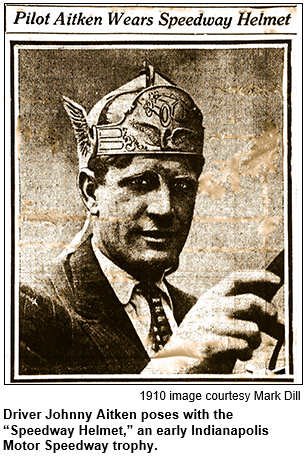 (April 30, 2016) - After 22-year-old native Hoosier Joe Dawson won the Indianapolis 500 in 1912, he hurried from the Indianapolis Motor Speedway to his family's home at 2828 N. Illinois St. to hug his mom.
(April 30, 2016) - After 22-year-old native Hoosier Joe Dawson won the Indianapolis 500 in 1912, he hurried from the Indianapolis Motor Speedway to his family's home at 2828 N. Illinois St. to hug his mom.
Charlie Merz, the son of an Indianapolis police officer, survived horrific accidents early in his racing career to complete the final lap of the Indy 500 in 1913 - with his car on fire. He died in 1952 and is buried in Crown Hill Cemetery.
In 1919, the Indy 500 was won by popular Howdy Wilcox, a pioneer race driver born in Crawfordsville. His son Howard S. Wilcox, also known as Howdy, founded the Little 500 bicycle race at Indiana University in the early 1950s.
As the countdown continues to the 100th running of the Indy 500, Hoosier History Live explores the colorful lives and careers of these and other early race drivers who had deep connections to Indiana.
Our guest is Indy native and lifelong racing enthusiast Mark Dill, the creator of firstsuperspeedway.com, an extensive website about auto racing, including the sport's pre-1920 history.
Mark, who is based in Cary, N.C., has worked in marketing and public relations for various high-tech companies; he also previously worked for the Indianapolis Motor Speedway and, when he was an Indiana University student, as news director of Indianapolis Raceway Park. Mark and his wife, Esther, own Mark Dill Enterprises Inc., which helps market the rapidly growing sport of vintage auto racing.
Speaking of vintage: Many Hoosiers know a bit about Ray Harroun, a Pennsylvania native who won the inaugural Indy 500 in 1911 with a Marmon car made in Indianapolis. 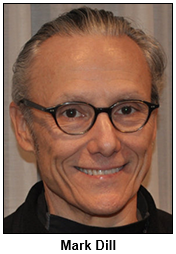 That race has been the focus of Hoosier History Live shows, including some with Speedway historian extraordinaire Donald Davidson. Most recently, Donald was Nelson's studio guest on April 4, 2015 for a program that explored the impact of track announcer Tom Carnegie and popular driver Jimmy Clark, the "Flying Scot" who won the Indy 500 in 1965.
That race has been the focus of Hoosier History Live shows, including some with Speedway historian extraordinaire Donald Davidson. Most recently, Donald was Nelson's studio guest on April 4, 2015 for a program that explored the impact of track announcer Tom Carnegie and popular driver Jimmy Clark, the "Flying Scot" who won the Indy 500 in 1965.
For this show, we explore some Hoosiers whose legacies are not as well remembered by the general public today - as well as others such as Wilcox and Barney Oldfield, an Ohio native who, as our guest Mark Dill puts it, was "embraced by Indiana like a native son." A confidant of Speedway founder Carl Fisher, Oldfield (1878-1946) was a racing pioneer and showman who even starred in silent movies.
Although Harroun won the inaugural Indy 500 in 1911, the first lap was led by driver Johnny Aitken, an Indianapolis native whose life and racing achievements Mark will discuss during our show. (According to Donald Davidson's Official History of the Indianapolis 500 with co-author Rick Shaffer, Aitken stayed in front for the first four laps of the 1911 race.)
Mark also shares insights about Joe Dawson, the winner of the second Indy 500 who went home to hug his fretful mother, an anecdote celebrated in local newspapers in 1912. Described as a "simple, modest man," Dawson (at age 22 years and 10 months) remained the youngest Indy 500 winner for several decades.
According to Mark's research, Dawson lived with his parents in a house with "the 1912 version of a man cave" that featured college football and baseball pennants.
Other early Indy 500s drivers we will explore include "Farmer" Bill Endicott, whose nickname, Mark says, derived from his ownership of a farm near Crawfordsville.
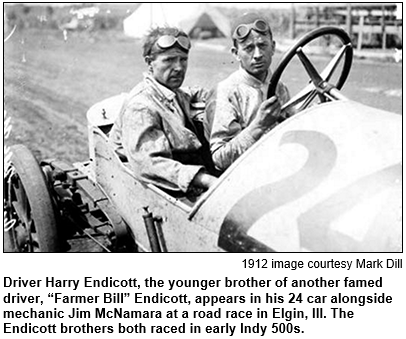 In addition to his firstsuperspeedway.com website, Mark oversees a Facebook page on the same subjects.
In addition to his firstsuperspeedway.com website, Mark oversees a Facebook page on the same subjects.
Earlier in his career, Mark was vice president of Nortel and, in that capacity, worked with former Indy 500 driver Scott Goodyear on sponsorships. Mark also is a regular guest and commentator about racing for radio and TV and has been active in the SportsCar Vintage Racing Association.
Before the inaugural Indy 500 in 1911, there were several other auto races at the Speedway after the track opened in 1909.
Some of these races were won by a talented young driver, Tommy Kincaid, who had been born in Indianapolis; he drove for the Indianapolis-based National Motor Vehicle Company race team owned by Arthur Newby. Our guest Mark Dill will share insights about Kincaid, even though he never raced in the Indy 500; that's because he was killed at age 23 at the Speedway in 1910 while testing his car. (If Tommy Kincaid had been alive in 1912, Mark suspects that he - rather than Joe Dawson, who hugged him mom after the victory - might have driven the winning car, which also was owned by National.)
Barney Oldfield, who even starred in a Broadway musical, generally is considered to have been the first American auto racing celebrity. According to the website of the Henry Ford Archive of Innovation, Oldfield "helped to democratize not only racing entertainment, but also the automobile in general, as the vehicles moved out of the carriage houses and into backyard sheds."
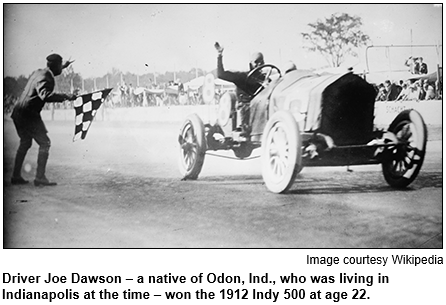 The website also notes that Oldfield "flouted the conventions of his time, both on and off the track. He was notorious for his post-race celebrations, womanizing and bar fights."
The website also notes that Oldfield "flouted the conventions of his time, both on and off the track. He was notorious for his post-race celebrations, womanizing and bar fights."
Charlie Merz, who finished the 1913 race with his car on fire, later became a successful businessman, engineer and chief steward of the Indy 500. According to a description of the 1913 Indy 500 on Mark's website, Merz's car burst into flames just before the final lap. Instead of stopping, he "forged ahead for the final lap ... with the riding mechanic swatting the flames with his jacket."
Learn more:
- Vanderbilt Cup Races - Author Howard Kroplick's website with information, images and events concerning the Vanderbilt Cup Races held on Long Island from 1904 to 1910.
- The Old Motor - A vintage-automobile "Internet magazine."
- Motor Sport Retro - A website that celebrates "classic motorsport, racing cars, motorcycles and gear."
- "The World When IMS Opened" - The Speedway's official website takes a look back at the year 1909.
- Donald Davidson on the Speedway's 100 years - Full audio (show length 26:27) from the March 5, 2011 Hoosier History Live interview with the Indianapolis Motor Speedway's track historian, Donald Davidson.
- Indianapolis Motor Speedway founder Carl Fisher's colorful life - Full audio (show length 29:42) from the May 16, 2009 Hoosier History Live show featuring Indianapolis historian Glory-June Greiff.
- Cruise-In.com - A website that celebrates Indiana car culture.
Roadtrip: Running events highlight Indy historic landmarks
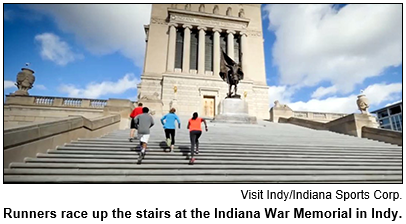 Guest Roadtripper and Indy-based history writer and enthusiast Jeff Kamm tells us that Saturday, April 30 is a first for Indianapolis. A new running event, the Indy Ultimate, will see runners compete through a course that features obstacles in our shimmering sports venues, as well as traversing some of our historic landmarks, such as the Soldiers and Sailors Monument and the Indiana War Memorial.
Guest Roadtripper and Indy-based history writer and enthusiast Jeff Kamm tells us that Saturday, April 30 is a first for Indianapolis. A new running event, the Indy Ultimate, will see runners compete through a course that features obstacles in our shimmering sports venues, as well as traversing some of our historic landmarks, such as the Soldiers and Sailors Monument and the Indiana War Memorial.
You can kick a field goal at Lucas Oil Stadium, take a shot at a basket at Bankers Life Fieldhouse, and run up, around and down the Indiana War Memorial steps as fast as you can.
This new event is just another of the several that have popped up in recent years. The running events owe this legacy to the 500 Festival Mini Marathon which will be run for the 39th time this coming weekend.
The half marathon, originally intended to be a bicycle race, was created by city leaders in 1977 at the insistence of Tony Hulman as a grand way to kick off the monthlong celebration of the Indianapolis 500. It has grown to be one of the largest running events in the nation and features some 35,000 participants from around the world looking to cross the yard of bricks at the historic Indianapolis Motor Speedway, which will celebrate the 100th running of the Greatest Spectacle in Racing on May 28th.
Oh, and yes, Jeff is a runner.
History Mystery
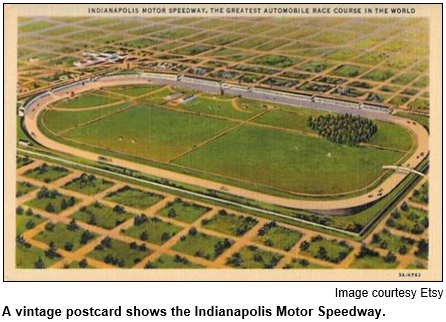 In 1909, two years before the first Indianapolis 500, the Indianapolis Motor Speedway opened.
In 1909, two years before the first Indianapolis 500, the Indianapolis Motor Speedway opened.
The first competition at the racetrack did not involve cars. Carl Fisher, the flamboyant founder of the Speedway, not only organized the first race in June 1909, he was among the competitors in it.
Question: What was raced?
Hint: Not only did the race, a national competition, not involve any kind of car, it also did not involve motorcycles.
The prize pack includes a Family 4-Pack to Conner Prairie Interactive History Park, including four tickets to the 1859 Balloon Voyage, and two tickets to the Indianapolis Motor Speedway Track Tour, courtesy of Visit Indy.
A bicentennial guide to backroads Indiana
|
(April 23, 2016) - In South Bend, there is a 38-room historic home of a nationally known family that made farm equipment, including the chilled plow. An industrial park has an open-air exhibit and a smokestack from the Oliver Chilled Plow Works, the factory owned by the Oliver family. The patriarch, J.D. Oliver, founded the factory in 1853.
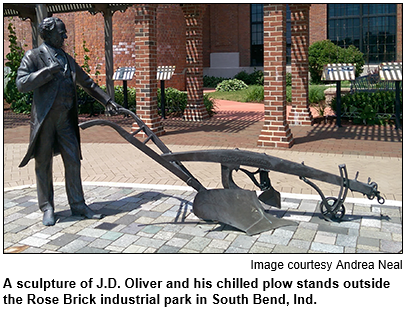 In Bloomington, historic houses in the Vinegar Hill neighborhood near the Indiana University campus showcase the use of Indiana limestone in several architectural styles, from Greek Revival to Art Deco.
In Bloomington, historic houses in the Vinegar Hill neighborhood near the Indiana University campus showcase the use of Indiana limestone in several architectural styles, from Greek Revival to Art Deco.
"Many of the homes were built by big names in the limestone industry, including master carvers whose decorative skills were reflected in carvings, ornamental panels and sculptures adoring the facades," notes Andrea Neal, an Indianapolis-based journalist, historian and educator. She joins Nelson in studio to share an array of sites the public can explore to savor the state's heritage.
Dozens of the sites are featured in Andrea's book, Road Trip: A Pocket History of Indiana, that the Indiana Historical Society Press will publish in May. She also has been describing the sites in "Indiana at 200", a syndicated column Andrea has been writing for newspapers across the state in connection with this year's bicentennial.
 All corners of the 19th state are represented, from South Bend (where the Oliver mansion has special exhibits) to Jeffersonville on the Ohio River, where Andrea recommends a visit to the Howard Steamboat Museum. It's located in a historic mansion built by the son of steamboat entrepreneur James Howard. He founded Howard Shipyards in 1834. River traffic remains important to Indiana's economy, Andrea says, noting the legislature recently increased investment in the state's ports.
All corners of the 19th state are represented, from South Bend (where the Oliver mansion has special exhibits) to Jeffersonville on the Ohio River, where Andrea recommends a visit to the Howard Steamboat Museum. It's located in a historic mansion built by the son of steamboat entrepreneur James Howard. He founded Howard Shipyards in 1834. River traffic remains important to Indiana's economy, Andrea says, noting the legislature recently increased investment in the state's ports.
Elsewhere in southern Indiana, Andrea recommends a visit to the Museum of the Coal Industry in Lynnville. "It tells the story of the southern Indiana company town and has lots of coal industry memorabilia," Andrea reports.
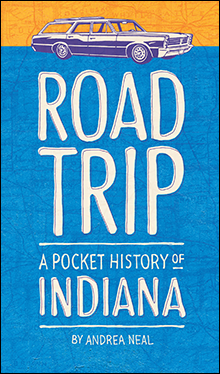 Andrea, an eighth-grade teacher at St. Richard's Episcopal School, and our host Nelson were colleagues for many years at The Indianapolis Star, where Andrea was editor of the editorial page. On Hoosier History Live, Andrea was a co-host in 2014 for one of our all call-in "Ask Nelson" shows. In addition, Nelson and Andrea are board members of the Society of Indiana Pioneers. Andrea also is a board member of the Benjamin Harrison Presidential Site.
Andrea, an eighth-grade teacher at St. Richard's Episcopal School, and our host Nelson were colleagues for many years at The Indianapolis Star, where Andrea was editor of the editorial page. On Hoosier History Live, Andrea was a co-host in 2014 for one of our all call-in "Ask Nelson" shows. In addition, Nelson and Andrea are board members of the Society of Indiana Pioneers. Andrea also is a board member of the Benjamin Harrison Presidential Site.
In this show, she shares tips about sites that many Hoosiers many not know about. They include an exhibit about aviation pioneer Horace Hickam at the Owen County Heritage and Cultural Center. A native of Spencer, Hickam (1885-1934) is the namesake of a U.S. Air Force base in Hawaii.
During the bicentennial year, Andrea urges Hoosiers to tour the Indiana Statehouse, which was built in the 1880s. The statehouse features busts of - and information about - historic Hoosiers.
They include James Hinton (1834-1892), the first African-American elected to the Indiana General Assembly. A Republican who represented Indianapolis in the House of Representatives, Hinton fought for the Union Army in the Civil War and helped organize the 28th U.S. Colored Troops regiment from Indiana. He was elected to the state legislature in 1880, just 10 years after the 15th Amendment to the U.S. Constitution was ratified, allowing African-Americans to vote.
For those interested in our state's Native American heritage, Andrea recommends a visit to the Twin Lakes region in northern Indiana that once was the homeland of the Potawatomi Indians.
The Potawatomi were forcibly removed from Indiana in 1838 on what became known as the Trail of Death to Kansas. The heritage of the Potawatomi is honored every September in Rochester during the Trail of Courage Living History Festival. Historic markers along the Trail of Death commemorate camp sites and stops during the march of Potawatomi men, women and children. Many perished from exhaustion, disease and the effects of the weather during the 660-mile march, which was led by Gen. John Tipton. The markers describe the number of deaths recorded at the sites and the distance traveled between stops.
Roadtrip: Geneva in northeast Indiana
 Guest Roadtripper and film historian Eric Grayson suggests a Roadtrip to Geneva in northeast Indiana.
Guest Roadtripper and film historian Eric Grayson suggests a Roadtrip to Geneva in northeast Indiana.
"If coming from Indianapolis, go north on I-69 and then east on S.R. 18 to the town of Montpelier, where you can have lunch on the way at the Tin Lizzy," Eric tells us. "This is a seasonal place, open mostly in the summers, but it's full of architectural ornaments from closed and abandoned buildings.
"Outside it, at the intersection of Highways 3 and 18," he continues, "you'll see a giant Paul Bunyan holding a small ice cream cone. How can you beat that?"
Eric recommends the tenderloins, an Indiana tradition.
Then, going further east on S.R. 18 and then north on S.R. 27, one arrives at historic Geneva. Geneva always was a small town, and it still is, but it had a huge claim to fame: It's where Gene Stratton-Porter first fell in love with the Limberlost swamp. Her house still stands there, and it has been restored as the Limberlost State Historic Site.
They've just recently spruced up the whole place, and there's a new interpretive center in the back that opened a couple of years ago.
"I'm also told that they are restoring parts of the swamp, and it's now a haven for birds and other wetland wildlife," says Eric. "This is with the cooperation of Geneva's biggest industry, Red Gold, which is just outside of town. Red Gold is not offering tours at the moment, but you can drive by and see the huge factory there."
History Mystery
During a recent Hoosier History Live show, the Roadtrip report was about a state park in southern Indiana. The state park includes a natural landmark that served as the meeting place of two famous explorers in the early 1800s. In fact, the state park takes its name from the natural landmark. The state park also has 220 acres of ancient fossil beds.
Question: What is the Indiana state park?
The prize pack includes a four tickets to the Indiana Wine Fair on Saturday, April 30 in Brown County, courtesy of Story Inn, and two tickets to the Indianapolis Museum of Art and two tickets to the President Harrison Presidential Site, courtesy of Visit Indy.
Merle Bettenhausen on his racing family
(April 16, 2016) - With the 100th running of the Indianapolis 500 next month, all aspects of the history of Indy-car racing and its colorful personalities have become topics for water-cooler discussion.
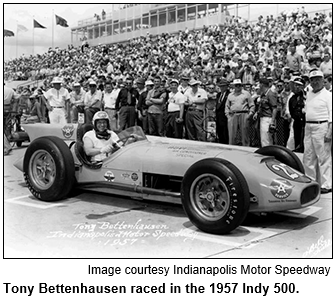 Significant racing personalities of the last half of the 20th century certainly include the Bettenhausen family, who have endured tragedy as well as triumphs at the Indianapolis Motor Speedway and elsewhere on the racing circuit. The patriarch, Tony Bettenhausen Sr. (1916-1961), a fan favorite who finished near the top in the 500-Mile Races of 1958 and '59, was killed in a crash at the Speedway during practice in 1961.
Significant racing personalities of the last half of the 20th century certainly include the Bettenhausen family, who have endured tragedy as well as triumphs at the Indianapolis Motor Speedway and elsewhere on the racing circuit. The patriarch, Tony Bettenhausen Sr. (1916-1961), a fan favorite who finished near the top in the 500-Mile Races of 1958 and '59, was killed in a crash at the Speedway during practice in 1961.
Nelson is joined in studio by the middle of Tony Sr.'s three sons, Merle Bettenhausen, who lives on the westside of Indy.
Merle has been working with veteran sportswriter Gordon Kirby on an upcoming photo-filled book about the family, Tony Bettenhausen & Sons: An American Racing Family Album (Racemaker Press).
 In 1972, Merle's brother, Gary Bettenhausen, nearly won the Indianapolis 500. Gary, who lived in Monrovia, was enjoying a comfortable lead at 175 laps when he was forced out with ignition problems.
In 1972, Merle's brother, Gary Bettenhausen, nearly won the Indianapolis 500. Gary, who lived in Monrovia, was enjoying a comfortable lead at 175 laps when he was forced out with ignition problems.
Also in 1972, Merle Bettenhausen was involved in a major accident at Michigan International Speedway in which his right arm was torn off. With a prosthetic arm, Merle made a comeback the next year, competed in midget races and pulled off wins.
 The youngest brother, Tony Bettenhausen Jr., competed 11 times in the Indy 500. His best finish was in 1981, his rookie year, when Tony Jr. came in seventh. Gary and Tony Jr. drove in their final Indy 500 as teammates in 1993.
The youngest brother, Tony Bettenhausen Jr., competed 11 times in the Indy 500. His best finish was in 1981, his rookie year, when Tony Jr. came in seventh. Gary and Tony Jr. drove in their final Indy 500 as teammates in 1993.
Tragedy followed the family even after the brothers retired as drivers. In 2000, Tony Jr., by then the owner of a racing team based in Indy, was killed along with his wife, Shirley, and two business associates in the crash of a private plane.
Merle, our guest, was 17 years old when his father was killed in May of 1961. Tony Sr. was test-driving the car of a fellow driver when the fatal accident occurred.
Gary Bettenhausen also endured a major accident. He suffered serious, permanent injuries to his left arm during a crash in Syracuse, N.Y., in 1974. Yet he continued his career as a race driver for nearly 20 more years. Gary Bettenhausen died at age 72 in 2014.
The upcoming book is divided into sections (with on- and off-track photos) focusing on Tony Sr., Gary, Merle and Tony Jr., along with personal recollections and commentary by Merle.
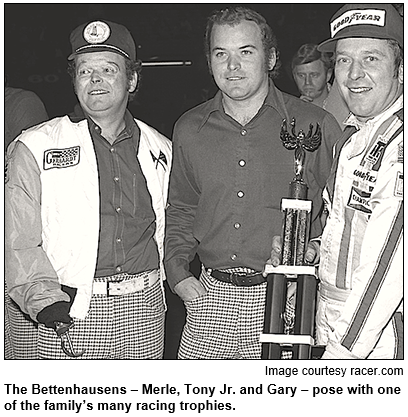 "It's doubtful there's ever been a more determined or star-crossed family in auto racing history than the Bettenhausens," Robin Miller, the well-known sportswriter and racing commentator, has written. "But throughout their victories, gut-wrenching defeats and tragedies, it was a family shaped by hard work and heart."
"It's doubtful there's ever been a more determined or star-crossed family in auto racing history than the Bettenhausens," Robin Miller, the well-known sportswriter and racing commentator, has written. "But throughout their victories, gut-wrenching defeats and tragedies, it was a family shaped by hard work and heart."
The Bettenhausens started out in Tinley Park, Ill., where Tony Sr. was born in 1916. He made his Indy 500 debut in 1946, the first race after the competition had been discontinued during World War II. During the 1950s, Tony Sr. won two national Indy-car championships, as well as hundreds of midget and stock car races.
Gary Bettenhausen not only is remembered as a fiercely competitive driver, but as a compassionate and valiant one. During the Indy 500 in 1971, he slammed on his brakes and leaped from his still-moving car to help a rival, driver Mike Mosley, who was pinned in a burning car. Gary pulled Mosley from the wreckage.
Our guest Merle Bettenhausen became the guardian of his two nieces, the daughters of Tony Jr. and Shirley, after the fatal plane crash. Although Merle competed in midget races after the accident in which he lost his arm, he eventually stopped racing and lived in Wisconsin for several years.
Merle moved back to Indianapolis and has been involved in the retail auto business. A popular public speaker, Merle - along with his sister, Susan - supplied many of the 350 photos that will be included in Tony Bettenhausen & Sons. The book also will include complete statistical data of the family's racing careers.
Additional research by Jeff Kamm.
History Mystery
 Unlike the Bettenhausens, who settled in Indiana, most of the Andretti family was based in Nazareth, Pa. That's where Mario Andretti has lived for most of his adult life and where his son, Michael, and grandson, Marco, grew up.
Unlike the Bettenhausens, who settled in Indiana, most of the Andretti family was based in Nazareth, Pa. That's where Mario Andretti has lived for most of his adult life and where his son, Michael, and grandson, Marco, grew up.
But Mario's twin brother, Aldo Andretti, has lived in Central Indiana for more than 40 years. Aldo's son, John Andretti, became a well-known Indy car and NASCAR driver, competing in both the Indy 500 (where his top finish was fifth in 1991) and the Brickyard 400.
John Andretti, now 53, attended a high school in the Indianapolis area. He even met his future wife, Nancy, at the high school.
Question: What high school is John Andretti's alma mater? Hint: It is located less than two miles from the Speedway.
The prize pack includes a two tickets to the Indianapolis Motor Speedway Track Tour and two tickets to the Indiana Experience at the Indiana History Center, courtesy of Visit Indy, and four tickets to the premier of the "Roots of Destiny" documentary about the Indiana ancestral home of Barack Obama in Tipton County, courtesy of the Dunham House Educational Foundation. The premier is Saturday evening, April 30, at the Ricks Centre in Greenfield.
Roadtrip: Twin Swamps in Posey County
|
Guest Roadtripper Michael Homoya, who is a botanist and plant ecologist with the Indiana Department of Natural Resources, suggests a Roadtrip to Twin Swamps Nature Preserve, where you will think you're in the Deep South instead of the Hoosier state!
Twin Swamps is a cottonwood-bald cypress swamp and an overcup oak swamp, with an area of southern flatwoods between the two. This preserve is one of the few existing remnants of such communities, which once occurred over large portions of the Ohio and Wabash River Valleys. The natural bald cypress swamp occurs near the northern limit of its range.
Michael tells us that we won't see alligators or Spanish moss, but otherwise we'll see many species in common with the southern states. Twin Swamps is located in Posey County, near where the Wabash River and Ohio River merge, about 25 miles southwest of Evansville and 20 miles south of New Harmony.
There's a boardwalk into the swamp that is part of a mile-long loop trail. And for our bird-loving friends, you'll see the Blue-gray Gnatcatcher and the brilliantly colored Prothonotary Warbler.
Columbus architecture and city history
|
(April 9, 2016) - The American Institute of Architects once asked its members to rank U.S. cities on architectural quality and innovation. Columbus, Ind., finished sixth - behind only the significantly larger cities of Chicago, New York City, Washington D.C., San Francisco and Boston.
 The modern architecture in Columbus (pop.: 45,000) has been showcased in national media ranging from CBS Sunday Morning and USA Today to Travel & Leisure and Smithsonian magazines.
The modern architecture in Columbus (pop.: 45,000) has been showcased in national media ranging from CBS Sunday Morning and USA Today to Travel & Leisure and Smithsonian magazines.
Now it's Hoosier History Live's turn to explore the architectural heritage of the Bartholomew County city with one of its best-known media figures/historians as our guest.
Nelson is joined in studio by Bartholomew County historian Harry McCawley, the retired associate editor of The Columbus Republic; he continues to write a popular weekly newspaper column that often focuses on local history. Harry, a civic leader who has been president of the Bartholomew County Historical Society, also has edited several books focusing on Columbus history.
Key figures in the story of the Columbus architectural heritage include renowned Finnish architect Eliel Saarinen, who designed the city's First Christian Church in 1942, and his son, Eero Saarinen, who designed the Irwin Union Bank and Trust in 1955 - several years after having designed the Gateway Arch in St. Louis.
Columbus business and civic leaders who spearheaded the crusade to lure top architects with diverse, innovative designs included J. Irwin Miller (1909-2004). For nearly 50 years, Miller was at the helm of Cummins, Inc., a Fortune 500 company based in Columbus that manufactures diesel engines.
Eero Saarinen also designed the Miller House, the former residence of the Miller family that is located on more than 13 acres of landscaped gardens. 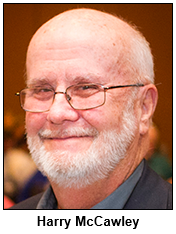 The Miller House, which has been featured in Architectural Digest, is owned today by the Indianapolis Museum of Art and has become a popular destination for tours. (Famous furniture designer Charles Eames created furnishings for the Miller family.)
The Miller House, which has been featured in Architectural Digest, is owned today by the Indianapolis Museum of Art and has become a popular destination for tours. (Famous furniture designer Charles Eames created furnishings for the Miller family.)
In downtown Columbus, historic structures include the Irwin family's ancestral home, which was built during the Civil War era. Today, it is a bed-and-breakfast called the Inn at Irwin Gardens.
 Our guest Harry McCawley shares details about the origins of the city's architectural heritage. Much of the trigger was the critical need for new schools for children of the baby boom generation; Miller is said to have looked at the unimpressive design for a school and said, "We certainly can do better than this."
Our guest Harry McCawley shares details about the origins of the city's architectural heritage. Much of the trigger was the critical need for new schools for children of the baby boom generation; Miller is said to have looked at the unimpressive design for a school and said, "We certainly can do better than this."
The eventual result has been dozens of award-winning designs and sites listed on the National Register of Historic Places.
In addition to First Christian Church, a National Historic Landmark that is considered to be the first American church designed in a contemporary style (it has indirect lighting and interior brick walls, both considered cutting-edge in 1942), several other houses of worship are architecturally significant. They include North Christian Church (designed by Eero Saarinen with a hexagonal roof topped by a towering spire); St. Peter's Lutheran (Gunnar Birkerts was its architect), and First Baptist Church, designed by Harry Weese of Chicago, who also was the architect for some local schools.
The glass-walled Columbus Republic newspaper building also is considered architecturally significant; according to Harry McCawley, it "spurred downtown redevelopment."
During our show, Harry also shares insights about the beginnings during the 1800s of Columbus, which has marketed itself with the slogan: "Different By Design."
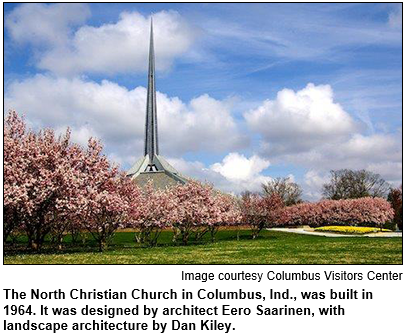 When the city was founded in the 1820s, it briefly was known as Tiptonia in honor of Gen. John Tipton, an early landowner. Following a dispute between Tipton and county officials, he left the area ("In a huff," according to our guest Harry McCawley) and the town was renamed Columbus; the disgruntled general allowed his name to be attached to Tipton and Tipton County farther north in Indiana. For various reasons - including his ruthless treatment of the Potawatomi Indians - Gen. Tipton is a controversial figure in Indiana history.
When the city was founded in the 1820s, it briefly was known as Tiptonia in honor of Gen. John Tipton, an early landowner. Following a dispute between Tipton and county officials, he left the area ("In a huff," according to our guest Harry McCawley) and the town was renamed Columbus; the disgruntled general allowed his name to be attached to Tipton and Tipton County farther north in Indiana. For various reasons - including his ruthless treatment of the Potawatomi Indians - Gen. Tipton is a controversial figure in Indiana history.
Fast-forward to issues in the 20th century about attitudes toward minorities. Under the leadership of J. Irwin Miller during the 1960s, "Cummins used corporate muscle in forcing Realtors and landlords" to end discriminatory practices toward African Americans, Harry McCawley says. "(Miller) wanted the community opened to people of all colors mostly because it was the right thing to do, but also because Cummins was trying to attract top young executives and engineers from elsewhere."
That also was part of the motivation for encouraging impressive architecture in Columbus, Harry notes. Miller and other business officials, he says, "felt the need to provide prospective leaders of their community with surroundings that might keep them in the community for decades instead of using Columbus as a stepping stool on their individual career resumes."
The distinctive architecture, Harry emphasizes, "was as much a business decision as it was to provide residents with a model community."
History Mystery
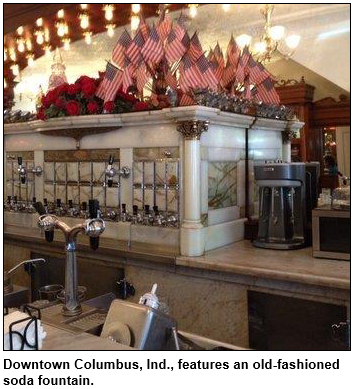 A popular destination for visitors to Columbus is an ice cream parlor that opened in 1900. Founded by three brothers from Greece, the landmark eatery has a tin ceiling, a self-playing pipe organ, a mahogany back bar, stained-glass windows and a soda fountain museum.
A popular destination for visitors to Columbus is an ice cream parlor that opened in 1900. Founded by three brothers from Greece, the landmark eatery has a tin ceiling, a self-playing pipe organ, a mahogany back bar, stained-glass windows and a soda fountain museum.
Although the historic ice cream parlor no longer is owned by descendants of the three Greek brothers, the family's name has been retained on the landmark eatery. In 2009, the ice cream parlor reopened after being closed for two years for a major renovation.
Question: Name the landmark ice cream parlor in Columbus.
The prize pack includes a gift certificate to the Claddagh Irish Pub and Restaurant, two tickets to the Benjamin Harrison Presidential Site, courtesy of Visit Indy, and four tickets to the premier of the "Roots of Destiny"documentary about the Indiana ancestral home of Barack Obama in Tipton County, courtesy of the Dunham House Educational Foundation. The premier is Saturday evening, April 30, at the Ricks Centre in Greenfield.
Roadtrip: DeMotte in northwestern Indiana
Guest Roadtripper and public historian Glory-June Greiff suggests a Roadtrip to Demotte and Jasper County in northwestern Indiana. She tells us that "this part of the state was, for the most part, settled much later than the rest of the state, owing to the vast and seemingly impassable swamps, which were largely drained in the late 19th century."
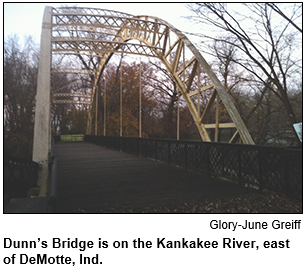 Glory continues: "Today we call those wetlands, and some are being restored. Driving in this country of wide open spaces can be disconcerting! Jasper County, at the southern edge of this region, has many interesting sights."
Glory continues: "Today we call those wetlands, and some are being restored. Driving in this country of wide open spaces can be disconcerting! Jasper County, at the southern edge of this region, has many interesting sights."
Founded in 1882, DeMotte owes its existence to the railroad that still runs through town. At the corner of 9th and Birch is the DeMotte Library, a branch of the Jasper County Public Library system, housed in a former Catholic church that was expanded to four times its original size in 1992. The library is also home to the DeMotte Historical Society.
Hungry? Just off Highway 231 at the south edge of DeMotte is Jim's Cafe, open for breakfast, lunch and supper.
"This my kind of small-town cafe," Glory says, "but if it doesn't float your boat, DeMotte has plenty of other restaurants. Just cruise the main drag, which is 231."
Several miles due east of DeMotte is the fascinating Dunn's Bridge, which several years ago was in a decrepit state.
"This is the so-called Ferris Wheel bridge," Glory says, "and there is a good case to be made. The bridge is looking much better these days, and the county has created a very nice little park around it, with a picnic area and canoe launch into the Kankakee River."
Farther east is Jasper-Pulaski Fish & Wildlife Area, where in spring, but especially in late fall, you can see thousands of sandhill cranes. They're harder to predict in spring, but always worth a look!
Historic markers across Indiana
|
(April 2, 2016) - Currently under way: plans for Indiana historic markers in Brown County to honor the bluegrass music heritage (including what's now called the Bill Monroe Bean Blossom Music Festival) and in Bloomington (near the basketball stadium on the Indiana University campus) to commemorate the racial barrier in Big Ten basketball shattered by Shelbyville native Bill Garrett during the late 1940s.
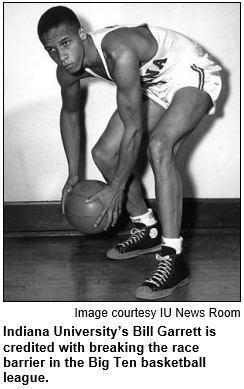 Surprising omissions among the 603 state historic markers: There are none commemorating Madam Walker, James Dean and Booth Tarkington.
Surprising omissions among the 603 state historic markers: There are none commemorating Madam Walker, James Dean and Booth Tarkington.  An organization, group or individual has never initiated a proposal for a marker on a site associated with those famous Hoosiers.
An organization, group or individual has never initiated a proposal for a marker on a site associated with those famous Hoosiers.
To explore all aspects of state historic markers, Nelson is joined in studio by two guests from the Indiana Historical Bureau, which administers the marker program. His guests are Chandler Lighty, the historical bureau's new executive director, and Casey Pfeiffer, the marker program's manager.
Note: To be commemorated with a state historic marker, an event must have occurred at least 50 years ago; an individual must be dead for 20 years. (So a site associated with a notable like Kurt Vonnegut, who died in 2007, won't be eligible for 11 more years.)
State historic markers cover a range of topics, from military and women's history to milestones in industry and business. Our guest Chandler Lighty, who became the historical bureau's director earlier this year, says he wants to "ramp up" the marker program and, in particular, increase the number of markers related to cultural and sports history, as well as the heritage of ethnic and minority groups that now are "not equitably represented."
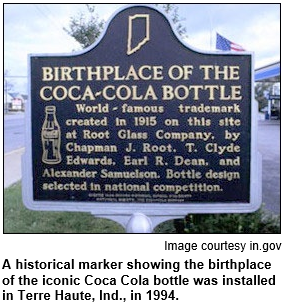 The text on some markers - including several involving Native American history that were erected more than 40 years ago - is dated or even inappropriate, our guests concede. Examples include the marker at a Grant County site of a Miami Indian cemetery. The text inaccurately implies that white pioneers introduced the Miami to the practice of burying their dead; in fact, the Miami and other Native American tribes had burial practices long before whites arrived.
The text on some markers - including several involving Native American history that were erected more than 40 years ago - is dated or even inappropriate, our guests concede. Examples include the marker at a Grant County site of a Miami Indian cemetery. The text inaccurately implies that white pioneers introduced the Miami to the practice of burying their dead; in fact, the Miami and other Native American tribes had burial practices long before whites arrived.
Some marker insights:
- To initiate consideration of a state historic marker, visit the historical bureau's "apply for a marker" page.
- Not all historical markers you see across Indiana are state markers. "State historical markers are distinguished by the outline of the state of Indiana in the crest at the top of the marker," our guest Casey Pfeiffer notes.
- The 603 markers have been installed since the mid-1940s. Before that, a WPA project during the 1930s involved the erection of a much different style of historic signage; most of those markers were removed to be used as scrap metal during World War II. (Even before the WPA project, a state effort during the 1910s and '20s encouraged communities to erect plaques and other signage that would mark important sites in state history.)
- The $2,200 cost of a new state marker is assumed by the nominating organization, group or person. Permission of the property owner of the desired site is required.
State markers have been approved in recent years for sites associated with the Indianapolis Times (the long-gone newspaper won a Pulitzer Prize in 1928 for exposing the KKK's influence in Indiana politics) and, in Allen County, for Philo Farnsworth, a pioneer in the invention of television.
 According to the Indiana Historical Bureau, events or people commemorated with state markers must have had statewide significance, not just an impact on a local community.
According to the Indiana Historical Bureau, events or people commemorated with state markers must have had statewide significance, not just an impact on a local community.
"Sometimes, counties or local communities will install their own markers if the topic is not eligible for a state marker," Casey Pfeiffer notes.
State markers, in addition to the crest featuring the shape of Indiana, have a dark blue background with gold lettering; the signs are cast aluminum.
During the 1990s, several historic markers were erected on sites associated with the Underground Railroad; state officials looked at extensive documentation before the markers were approved. (Hoosier History Live explored myths and folklore about questionable Underground Railroad sites during a show in 2013.)
A few state historic markers feature a visual image in addition to text. These include a marker in Terre Haute that commemorates the iconic design of the Coca Cola bottle. In 1915, Root Glass Works in Terre Haute won a national competition to create the design.
Learn more:
- History of the Indiana State Historical Marker Program - Indiana Historical Bureau.
|
History Mystery
No state historic marker pays tribute yet to famous Indianapolis novelist and playwright Booth Tarkington, who won two Pulitzer Prizes.  If a marker ever is erected, several choices for a site would be logical. One option would be near the historic mansion on North Meridian Street where Tarkington lived from the early 1920s until his death in 1946.
If a marker ever is erected, several choices for a site would be logical. One option would be near the historic mansion on North Meridian Street where Tarkington lived from the early 1920s until his death in 1946.
Another appropriate site for a marker would be a distinctive Indianapolis neighborhood often identified with Tarkington. That's because he used the historic neighborhood as the setting for his masterpiece, The Magnificent Ambersons (1918). He changed the names of both Indianapolis and the neighborhood in his bestselling novel - calling the city "Midland" and the neighborhood "Amberson Estates."
Question: The elegant homes of the central characters clearly are modeled after the spacious houses in what neighborhood?
The prize pack includes a gift certificate to the Slippery Noodle Inn and two admissions to the Indiana Experience, courtesy of Visit Indy, and two tickets to the premier of the "Roots of Destiny"documentary featuring the Indiana ancestral home of Barack Obama.
Roadtrip: Camp Atterbury
|
Guest Roadtripper Ken Marshall tells us that Camp Atterbury, just north of Columbus, Ind., offers surprising options for visitors. Think camping, hiking, a shooting range and even a small museum that tells the story of the historic WWII military base.
Horseback riding? It's available to the public nearby at Hoosier Horse Park. Ken will be making a personal visit to Camp Atterbury and will have a full report for us on Saturday.
Monika Herzig on Indiana women jazz musicians
 (March 26, 2016) - Plenty of Hoosiers - and certainly many WICR-FM listeners - are aware of Monika Herzig, one of Indiana's best-known and most acclaimed jazz musicians.
(March 26, 2016) - Plenty of Hoosiers - and certainly many WICR-FM listeners - are aware of Monika Herzig, one of Indiana's best-known and most acclaimed jazz musicians.
But Monika, a jazz pianist and composer, emphasizes that many of her predecessors (including some whose accomplishments came during the ragtime era of the early 1900s) and peers have been overlooked. So, during Women's History Month, Monika has been paying tribute in performances across the state to an array of women jazz musicians, particularly composers and instrumentalists who often were overlooked.
 She is Nelson's studio guest to share insights about the women musicians, including some who were part of the heyday of the Indiana Avenue jazz scene in Indianapolis.
She is Nelson's studio guest to share insights about the women musicians, including some who were part of the heyday of the Indiana Avenue jazz scene in Indianapolis.
A native of Germany, Monika has been a faculty member at Indiana University since 2002, has toured internationally (opening for the likes of Bette Midler and Sting) and has performed at countless jazz festivals, including Indy Jazz Fest. Her upcoming release is titled The Whole World in Her Hands.
During our show, Monika shares insights about jazz musicians, including:
- May Aufderheide (1888-1972), an Indianapolis native who is generally considered to have been the most important woman composer of ragtime music. Her compositions included The Thriller, Dusty, The Richmond Rag (she lived in Richmond for several years) and Novelty Rag.
- Flo Garvin, an Indianapolis-based pianist and singer who enjoyed a devoted fan base beginning in the 1950s. (During the late 1950s, she often performed on Channel 6, then WFBM-TV.) A fixture at clubs on Indiana Avenue and at other piano bars, Flo Garvin was considered a pioneer for African-American women musicians. She died in 2005.
- The Hampton Sisters. The beloved sisters - Aletra, Virtue, Dawn and Carmelita - enjoyed a long career that also was intertwined with the Indiana Avenue jazz scene. Their recording of Route 66 often is played on WICR-FM. The sisters were instrumentalists as well as vocalists.
- And Cathy Morris, a contemporary Indy-based violinist, composer and arranger. She has performed at the Indianapolis 500 and has opened for such notables such as Burt Bacharach and George Benson.
 Our guest Monika Herzig has organized more than 40 concerts with internationally known artists. Regular and upcoming performances include:
Our guest Monika Herzig has organized more than 40 concerts with internationally known artists. Regular and upcoming performances include:
- With her Monika Herzig Trio, she performs every Saturday from 7 to 11 p.m. at Rick's Cafe Boatyard.
- Her next Women's History Month tribute to women jazz musicians will be March 31 from 5:30 to 8 p.m. at Bear's Place in Bloomington.
- The Monika Herzig Acoustic Project will perform from 2 to 3 p.m. on April 17 at the Artsgarden in downtown Indy.
For her Women's History Month events about jazz musicians, Monika often has been joined by musicians such as violinist Carolyn Dutton, who lives in Brown County, and Indianapolis-based saxophonist Amanda Gardier and clarinetist Shawn Goodman. Their careers and impact also are explored during our show.
Among historic women composers during the ragtime era, Monika shares insights about Julia Niebergall (1886-1968) of Indianapolis. A friend of May Aufderheide, Niebergall was a pianist whose compositions included Hoosier Rag (1907). She periodically taught music at Manual High School.
The Indiana jazz scene recently lost a popular vocalist. Mary Moss - who had been a longtime regular performer at the Jazz Kitchen and the Chatterbox, two Indianapolis jazz clubs - died in January. During our show, Monika will discuss the legacy of Mary Moss, who was known as "The Lady with a Song."
Learn more:
- Jazz History in Indy with Chuck Workman - Hoosier History Live newsletter, Feb. 25, 2011.
- Local women in jazz - Nuvo newsweekly article by Chuck Workman, March 23, 2011.
- The many sides of Monika Herzig - Nuvo newsweekly article by Scott Shoger, May 18, 2011.
- Hoosier Rag, by Julia Niebergall, 1907 - Listen to the song on YouTube.
History Mystery
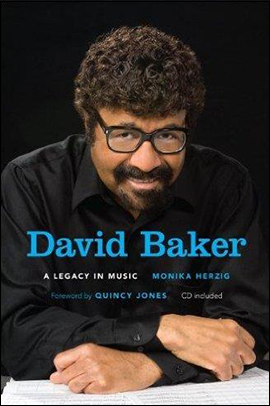 Our guest Monika Herzig has collaborated on several projects with legendary jazz composer, musician and educator David Baker. In fact, she is the author of a book titled David Baker: A Legacy in Music.
Our guest Monika Herzig has collaborated on several projects with legendary jazz composer, musician and educator David Baker. In fact, she is the author of a book titled David Baker: A Legacy in Music.
A native of Indianapolis and graduate of Attucks High School, David Baker began his career as a trombonist and toured with several big bands.
After suffering a broken jaw in a car accident, he stopped playing the trombone and switched to another instrument - one that rarely had been heard in jazz music. David Baker is credited with pioneering the use of the musical instrument in jazz.
Question: What is the instrument?
Please do not call in to the show until you hear Nelson pose the question on the air, and please do not try to win the prize if you have won any other prize on WICR during the last two months. You also must give your first name to our engineer in order to be placed on the air.
The prize pack includes a gift certificate to Arni's Restaurant and two admissions to the Benjamin Harrison Presidential Site, courtesy of Visit Indy.
Roadtrip: Rochester in northern Indiana
|
Guest Roadtripper and film historian Eric Grayson recommends a Roadtrip to the town of historic Rochester, which was founded in 1835. Eric tells us, "It's way up north on the new U.S. 31, and the first sign we've arrived will be the Fulton County Historical Society. This is a large museum with a number of outdoor exhibits, including a barn that they just had to restore after some damage last year. See if you can time your visit to one of the events that they have several times a year."
For lunch, consider a stop at the Rochester Flagpole, which is a local stop that has been open since 1949. They've had some ownership changes, but they're still open, and it's Eric's firm opinion that they have the best strawberry sundae in the state.
Not far away is the 1895 Fulton County Courthouse, which notable for its 10 lion sculptures.
And just outside of town is a historic lake - Lake Manitou. This is a natural lake that was dammed to expand it in the 1800s. Says Eric: "Beautiful lake, full of fish, great for swimming and canoeing."
James Alexander Thom on 1865 steamboat tragedy
|
(March 19, 2016) - One of Indiana's most acclaimed novelists is our studio guest to share insights about the Hoosier state's links to a tragedy on the Mississippi River during the aftermath of the Civil War and President Abraham Lincoln's assassination.
The fire and explosion in 1865 of the Sultana - a steamboat carrying about 2,000 passengers, including many Union Army soldiers who had survived the horrific Andersonville prisoner-of-war camp - has been called "America's worst maritime disaster."
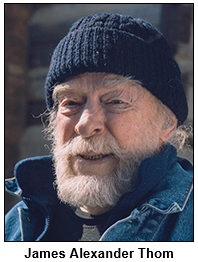 It's the focus of Fire in the Water (Blue River Press/Cardinal Publishing), the newest novel of historical fiction by James Alexander Thom, 82, whose great-grandfather survived the infamous Andersonville camp in Georgia.
It's the focus of Fire in the Water (Blue River Press/Cardinal Publishing), the newest novel of historical fiction by James Alexander Thom, 82, whose great-grandfather survived the infamous Andersonville camp in Georgia.
Jim and his wife, author Dark Rain Thom, are Nelson's guests for a show that also, as a salute to the state's bicentennial this year, includes insights about the Native American presence here in 1816, when Indiana became the 19th state. Dark Rain, a Shawnee, is the co-author with her husband of Warrior Woman (2004), a novel about the life of a real Shawnee leader of the 18th century.
The Thoms are renowned for the extensive historical research they undertake in writing their books. For several years, they provided riverboat commentary on the Delta Queen as historical lecturers.
 The Sultana, a wooden steamboat, exploded near Memphis, Tenn., while transporting five times the legal maximum of passengers; Jim describes them as "a pathetic human cargo of 2,000 sick and ragged survivors" of Andersonville. The explosion on April 27, 1865, happened the day after John Wilkes Booth was killed. The protagonist in Fire in the Water boards the Sultana to travel from the Deep South to Illinois to meet up with Lincoln's funeral train.
The Sultana, a wooden steamboat, exploded near Memphis, Tenn., while transporting five times the legal maximum of passengers; Jim describes them as "a pathetic human cargo of 2,000 sick and ragged survivors" of Andersonville. The explosion on April 27, 1865, happened the day after John Wilkes Booth was killed. The protagonist in Fire in the Water boards the Sultana to travel from the Deep South to Illinois to meet up with Lincoln's funeral train.
Some chapters in Fire in the Water also are set in Madison, the scenic Indiana town on the Ohio River. In addition, Madison is the hometown of some major characters in the novel.
Jim and Dark Rain Thom live in a 170-year-old log cabin in Owen County that he reconstructed on ancestral property.
He was the recipient of the inaugural Indiana Authors Award in 2009 by the Indianapolis Public Library Foundation. The byline "James Alexander Thom" first gained national fame with his novel Follow the River (1981), which landed on The New York Times bestseller list.
His other works of historic fiction include Long Knife (1979), which focuses on the exploits of George Rogers Clark during the Revolutionary War, and Panther in the Sky (1989), which focuses on the great Shawnee Leader Tecumseh.
Along with Dark Rain, Jim was a Hoosier History Live guest on April 2, 2011, for a show that tapped their advice about writing historic fiction. Jim had recently written The Art and Craft of Writing Historical Fiction (Writers Digest Books, 2011), for which he has subsequently won awards. He also has been inducted into the Indiana Journalism Hall of Fame.
In Fire in the Water, the protagonist, a war correspondent, describes the Sultana as a "Tub of Doom." Of the 2,000 passengers aboard the tremendously overcrowded steamboat, about 1,700 died - more fatalities than occurred with the sinking of the Titanic in April 1912. (Hoosier History Live explored the Titanic tragedy - and the 14 passengers aboard the ocean liner with Hoosier connections - during a radio show in 2010.)
 According to historians, the significance of the Sultana disaster was overshadowed by other enormously consequential events that also happened during April 1865, including the Lincoln assassination. Fire in the Water opens with news of the assassination reaching people in the Deep South, including the war correspondent, who is on his honeymoon. To cover the slain president's funeral, he decides to board the Sultana with his bride in Vicksburg, Miss.
According to historians, the significance of the Sultana disaster was overshadowed by other enormously consequential events that also happened during April 1865, including the Lincoln assassination. Fire in the Water opens with news of the assassination reaching people in the Deep South, including the war correspondent, who is on his honeymoon. To cover the slain president's funeral, he decides to board the Sultana with his bride in Vicksburg, Miss.
Hundreds of POWs recently released from the Andersonville camp, including many Hoosiers, also boarded the Sultana in Vicksburg. As one of the largest Confederate military prisons, Andersonville held more than 45,000 Union Army soldiers. Nearly 13,000 died, even though the camp existed for only 14 months; fatalities were attributed to malnutrition, disease and poor sanitation.
The fire on the Sultana, which occurred seven miles north of Memphis, began with the explosion of the boilers on the side wheel steamboat.
Learn more:
- "Victorian mourning and the Lincoln funeral train" - Hoosier History Live show, Feb. 14, 2015.
- "James Alexander Thom and Dark Rain on historical fiction" - Hoosier History Live show, April 2, 2011.
- "The Sultana, Titanic of the Mississippi" - Hoosier State Chronicles.
- "The Titanic and Hoosiers" - Hoosier History Live show.
- Sultana Disaster Museum - located in Marion, Ark.
History Mystery
Our distinguished guest, historical fiction author James Alexander Thom, was a Marine during the Korean War. So was an Indianapolis native who later became a well-known political figure.  Like our guest James Alexander Thom, he was sent to Korea during the war. He was a Marine from 1950 to 1952, saw combat and endured two fierce winters in Korea.
Like our guest James Alexander Thom, he was sent to Korea during the war. He was a Marine from 1950 to 1952, saw combat and endured two fierce winters in Korea.
The future politician had been born in Indy in 1932. He graduated from Shortridge High School in 1949, then served in the Marines. After that, he enrolled in Indiana University. In addition to a long political career - he held public office almost without interruption from 1964 until retiring in 1997 - he worked as a deputy sheriff in Marion County, a lawyer, an author and a college instructor.
Question: Who was he?
The prize pack includes a gift certificate to the Greek Islands Restaurant, courtesy of the Greek Islands, and two tickets to the Indianapolis Motor Speedway Track Tour, courtesy of Visit Indy.
Roadtrip: Falls of the Ohio State Park
|
Guest Roadtripper and Indy-based history writer and enthusiast Jeff Kamm suggests we enjoy spring at the beautiful Falls of the Ohio State Park on the banks of the Ohio River in Clarksville, Ind., across from Louisville.
The Falls were an early river navigation landmark for Ohio River traffic, and Merriwether Lewis and William Clark of the Lewis and Clark Expedition met for the first time at this location, and they set off westward just past the Falls.
The exposed fossil beds of the Jeffersonville Limestone, dated from the Devonian period, also are a major feature of the park. Click here to read Jeff's articles in Historic Indianapolis.
Ask Nelson and fellow author Doug Wissing
 (March 12, 2016) - This all call-in show is another in our occasional "Ask Nelson" format - an opportunity to inquire about any aspects of our Indiana heritage, particularly "connections - sometimes unexpected - that bind us Hoosiers to the outside world."
(March 12, 2016) - This all call-in show is another in our occasional "Ask Nelson" format - an opportunity to inquire about any aspects of our Indiana heritage, particularly "connections - sometimes unexpected - that bind us Hoosiers to the outside world."
Those are the words of an award-winning Hoosier author/journalist who joins our host, Nelson Price, a fellow author/journalist, on this show.
 Nelson's co-host is Bloomington-based Douglas Wissing, whose new book, IN Writing: Uncovering the Unexpected Hoosier State (a joint publication of Indiana University Press and the Indiana Historical Society Press), explores everything from Indiana's links to Tibet to a fruit known as "Indiana's banana" and a brewery in the Calumet Region that some have called the "world's best."
Nelson's co-host is Bloomington-based Douglas Wissing, whose new book, IN Writing: Uncovering the Unexpected Hoosier State (a joint publication of Indiana University Press and the Indiana Historical Society Press), explores everything from Indiana's links to Tibet to a fruit known as "Indiana's banana" and a brewery in the Calumet Region that some have called the "world's best."
In between taking phone calls from listeners, Nelson and Doug delve into all of those topics, as well as the legendary Studebaker Brothers from South Bend.
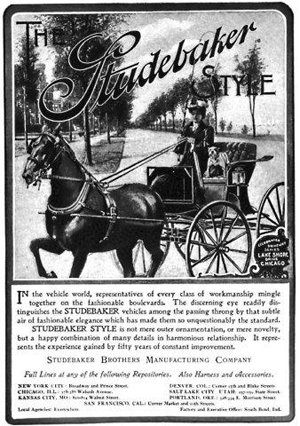 Topics covered include the unlikely connections between Indiana and Tibet. In IN Writing, Doug includes observations about the Tibetan Cultural Center, which was established near Bloomington by the late Thubten Norbu, the older brother of the Dalai Lama, in the 1980s.
Topics covered include the unlikely connections between Indiana and Tibet. In IN Writing, Doug includes observations about the Tibetan Cultural Center, which was established near Bloomington by the late Thubten Norbu, the older brother of the Dalai Lama, in the 1980s.
Nelson also interviewed Norbu several times during the evolution of the distinctive cultural center, which has been visited by celebrity Buddhists like Richard Gere, as well as by the Dalai Lama.
Also among Doug's 10 books is Pioneer in Tibet (Palgrave Macmillan, 2004), which chronicles the adventures of Dr. Albert Shelton (1875-1922), an Indianapolis-born explorer, physician and Protestant missionary. According to Doug, the only place in America during the early 1900s to learn the Tibetan language was, of all unlikely places, Indianapolis.
Doug's other books include Indiana: One Pint at a Time (IHS Press, 2010), which, like IN Writing, tells the story of Three Floyds Brewing, a brewery in Munster. In IN Writing, Doug notes that the company - located in a former warehouse in an industrial park - in 2010 "received perhaps the ultimate honor when judges at ratebeer.com ranked the brewery the best in the world."
Elsewhere in northern Indiana, the Studebaker Brothers thrived for generations as the largest employer in South Bend. The five wagon-making brothers, the sons of a blacksmith, are profiled in Nelson's book Indiana Legends: Famous Hoosiers from Johnny Appleseed to David Letterman (Hawthorne Publishing, 2005). During this show, Nelson plans to share insights about the brothers, whose business, later the Studebaker Corp., eventually made popular cars in South Bend until the assembly line shut down in 1963.
During an "Ask Nelson" show in November, the influx of phone calls from listeners meant our host never had the opportunity to talk about the five brothers. One of them initially become affluent, thanks to the California Gold Rush - but not for the reason you might expect.
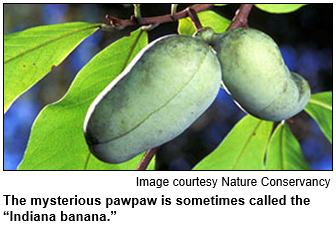 We certainly appreciate the phone calls during these shows; in fact, they are encouraged. So the phone lines remain open throughout the entire program, even as Nelson and Doug share a cornucopia of insights about all things Indiana, including the rather obscure pawpaw. In IN Writing, Doug describes his first taste of the "greenish yellow, oblong fruit" as a 5-year-old boy in southern Indiana.
We certainly appreciate the phone calls during these shows; in fact, they are encouraged. So the phone lines remain open throughout the entire program, even as Nelson and Doug share a cornucopia of insights about all things Indiana, including the rather obscure pawpaw. In IN Writing, Doug describes his first taste of the "greenish yellow, oblong fruit" as a 5-year-old boy in southern Indiana.
Nicknamed the "Indiana banana," the pawpaw is thought to have been brought to the Hoosier state and elsewhere by Native Americans. They are credited, according to Doug, with bringing pawpaw trees from northern Florida.
In IN Writing, Doug also devotes a chapter to the use of a famous Indiana product - limestone - in the construction of the Empire State Building in New York City.
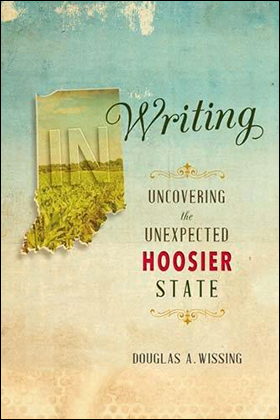 As part of his research, Doug apparently stood on a swaying catwalk on the 60th floor of the Empire State Building a couple of years ago. The building was the world's tallest "skyscraper" when it opened with 103 floors in the early 1930s. During our show, Nelson asks Doug to describe his experiences on the catwalk, as well as insights about Indiana's limestone companies and quarries he has visited.
As part of his research, Doug apparently stood on a swaying catwalk on the 60th floor of the Empire State Building a couple of years ago. The building was the world's tallest "skyscraper" when it opened with 103 floors in the early 1930s. During our show, Nelson asks Doug to describe his experiences on the catwalk, as well as insights about Indiana's limestone companies and quarries he has visited.
Limestone from the Hoosier state also was used to construct the Indiana State Capitol Building, which was built for $2 million in 1888. With a design similar to the U.S. Capitol Building in Washington D.C., the Indiana Statehouse is featured in Indianapolis Then and Now (Pavilion Books), a visual history book put together by a team consisting of Nelson, co-author Joan Hostetler and photographer Garry Chilluffo. (An extensively revised edition of the book has just been released.)
So Nelson shares details about the Statehouse - our third, and the second one located in Indy - during the show. The initial Indiana State Capitol Building in Indianapolis was built during the 1830s with, among other materials, stucco - which did not hold up well.
As with previous "Ask Nelson" shows - which have featured media co-hosts like gardening guru Jo Ellen Meyers Sharp, "Indiana's Weatherman" Paul Poteet and Will Higgins, history reporter for The Indianapolis Star - the phone lines are open throughout the entire program.
History Mystery
Not only are there several connections between Tibet and Indiana, the Hoosier state also has a link to Singapore. During the last 30 years, a well-known public figure in Indiana served as the U.S. ambassador to Singapore, an island nation in southeast Asia.
Question: Who was he?
The prize pack includes a gift certificate to the Rathskeller Restaurant, courtesy of Visit Indy, and two tickets to the Indiana State Museum, courtesy of the Indiana State Museum.
Women military veterans and memoirs
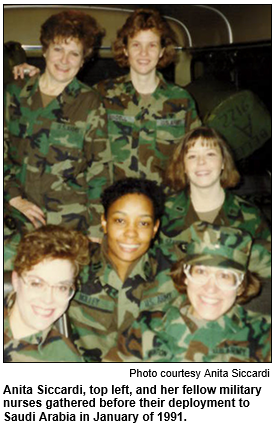 (March 5, 2016) - Not all of them have "war" stories per se, because some served in peacetime. But all of the members of a special group of diverse Hoosier women are military veterans. And they are working on their memoirs.
(March 5, 2016) - Not all of them have "war" stories per se, because some served in peacetime. But all of the members of a special group of diverse Hoosier women are military veterans. And they are working on their memoirs.
As Hoosier History Live salutes Women's History Month, Nelson is joined in studio by two of the military veterans, as well as by their instructor. She is Shari Wagner, Indiana's poet laureate, who is guiding the veterans with their memoirs in a series of workshops by the Indiana Writers Center.
The women, who range from 30-somethings to a 93-year-old veteran, meet at the Kurt Vonnegut Memorial Library. In addition to Shari, Nelson's guests are:
- Anita Siccardi, dean of the Marian University School of Nursing. An active-duty Army nurse from 1989 to 1992, Anita was deployed twice to the 98th General Hospital in Nuremberg, Germany during the Persian Gulf War. While in Nuremberg, Anita volunteered to be one of seven nurses to augment the 128th Combat Support Hospital in Saudi Arabia during Desert Storm.
- And Leslie Bales, director of customer services at the Defense Finance and Accounting Service housed at the former Fort Harrison. She began her military career at 17 years old in 1978 when Leslie and her late brother both joined the U.S. Air Force. During her service with the Air Force (1978-84), Leslie became the first woman to qualify as a loadmaster on a C-5 transport aircraft in her unit. The 301st Military Airlift Command was based at Travis Air Force Base in California.
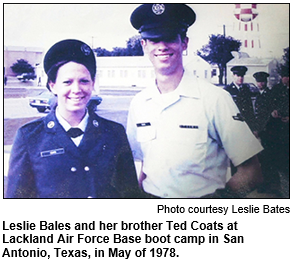 Leslie also has been a "Navy wife" because her husband, Ronald, a Noblesville native, is a veteran; he served 12 years aboard advanced attack nuclear submarines. The Bales' two grown sons, like their parents, also work at the Defense Finance and Accounting Service.
Leslie also has been a "Navy wife" because her husband, Ronald, a Noblesville native, is a veteran; he served 12 years aboard advanced attack nuclear submarines. The Bales' two grown sons, like their parents, also work at the Defense Finance and Accounting Service.
 The group of memoir-writing women served in almost every branch of the military. According to instructor Shari Wagner, their memoirs will be published by the Indiana Writers Center in a book this summer. The memoirs include poetry as well as prose; the project to tell the women's military stories is funded by the Allen Whitehall Clowes Charitable Foundation.
The group of memoir-writing women served in almost every branch of the military. According to instructor Shari Wagner, their memoirs will be published by the Indiana Writers Center in a book this summer. The memoirs include poetry as well as prose; the project to tell the women's military stories is funded by the Allen Whitehall Clowes Charitable Foundation.
Shari, who is not a military veteran, is Indiana's fifth poet laureate and the author of two books of poetry, The Harmonist at Nightfall: Poems of Indiana (Bottom Dog Press, 2013) and Evening Chore (Cascadia Publishing, 2005). She grew up near a 10-acre woods in Wells County and now lives in Hamilton County with her husband, Chuck, a poet and English teacher at Brebeuf Jesuit Preparatory School.
 During our show, Anita and Leslie discuss everything from their enlistment experiences in the military to their transition to civilian life and the process of writing their memoirs.
During our show, Anita and Leslie discuss everything from their enlistment experiences in the military to their transition to civilian life and the process of writing their memoirs.
Last November, their writing group was the focus of a story in The Indianapolis Star. In the article, some of the women shared insights about the rigors of survival training during their military service; the training often included, as The Star put it, "intense physical and mental challenges that few women attempted 30-plus years ago."
Our guest Leslie Bales writings include accounts of survival training and sexual harassment. In addition, she says her experiences as a staff sergeant in the Air Force and that of a Navy wife have helped her "understand and support the challenges service members and their families face today."
 Our guest Anita Siccardi, who is in her mid-70s, began her career as a school nurse in Pennsylvania and was an instructor at the IU School of Nursing when she decided to be an Army nurse at about age 50.
Our guest Anita Siccardi, who is in her mid-70s, began her career as a school nurse in Pennsylvania and was an instructor at the IU School of Nursing when she decided to be an Army nurse at about age 50.
After returning to civilian life - and before becoming the nursing school dean at Marian University - Anita also held various posts at the University of Indianapolis, including director of graduate nursing.
Our guest Shari Wagner teaches memoir writing to people of all ages and backgrounds. During our show, Shari also discusses her activities as poet laureate, which involve traveling around the state.
Shari's poetry is featured in the anthology And Know This Place: Poetry of Indiana (Indiana Historical Society Press, 2011); her projects currently underway include a book of poems in the voices of various men and women from Indiana history.
Learn more:
- Through the Sycamores - website of Shari Wagner, Indiana's poet laureate.
- Female veterans write their war stories - Indianapolis Star, Nov. 2015.
- War Stories - by Dan Carpenter in Sky Blue Window.
- One-day women's history symposium, "Hoosier Women at Work" - conference will be March 26 in the Indiana State Library in Indianapolis.
History Mystery
 A city in Indiana is particularly known for the contributions during World War II of "Rosie the Riveters," women who went to work in factories. That's because factory production in the city sharply increased during the war, with women undertaking many of the jobs, including welding.
A city in Indiana is particularly known for the contributions during World War II of "Rosie the Riveters," women who went to work in factories. That's because factory production in the city sharply increased during the war, with women undertaking many of the jobs, including welding.
More than 5,000 workers, mostly female, built various fighter aircraft at a factory in the Indiana city during World War II. Thousands of other women built ships, including battleships. A welding school was quickly set up in the city to train new factory workers, the majority of whom were women.
Question: What is the Indiana city?
The prize pack includes a gift certificate to the Hard Rock Cafe, two admissions to the NCAA Hall of Champions, and two admissions to the Indianapolis Motor Speedway Hall of Fame Museum, courtesy of Visit Indy.
Roadtrip - Colored Women's Federation Club
|
Guest Roadtripper Dona Stokes-Lucas, a researcher, tour guide and co-chair of Indiana Freedom Trails, suggests a visit to the former clubhouse of the Colored Women's Federation Club at 2034 N. Capitol Ave. in Indianapolis.
The Club was founded by African-American journalist Lillian Fox (1866-1917), a civic leader who first wrote for the Indianapolis Freeman, a leading national black newspaper at the time. She later joined the The Indianapolis News as Indiana's first black columnist. In 2014, she was inducted into the Indiana Journalism Hall of Fame.
Interested in other stops along the Indiana Women's History Trail? Here's a map put together by The Indianapolis Star.
How to furnish an historic home
(Feb. 27, 2016) - Maybe your home's interior has a Victorian-era theme. Or is your preference for an even earlier period, like the Colonial era? Perhaps, though, a much later era, such as the 1950s or '70s, is your decorative dream.
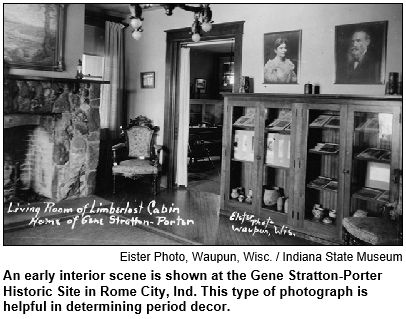 To offer advice about furnishing homes with "period" themes, Hoosier History Live calls in three experts with track records of making period-appropriate decorating decisions about distinctive homes, including some of Indiana's historic sites. Our topics include plenty of do's and don'ts. We also will explore the care, treatment and placement of period furniture in this information-packed show, which originally aired Jan. 10, 2015.
To offer advice about furnishing homes with "period" themes, Hoosier History Live calls in three experts with track records of making period-appropriate decorating decisions about distinctive homes, including some of Indiana's historic sites. Our topics include plenty of do's and don'ts. We also will explore the care, treatment and placement of period furniture in this information-packed show, which originally aired Jan. 10, 2015.
Nelson's guests are:
- David Buchanan of Indianapolis, curator of decorative objects and furniture for the Indiana State Museum and Historic Sites.
- Link Ludington of Madison, director of historic preservation for the state museum and historic sites. He also is an architectural historian.
- And Greg Ziesemer of Madison, an antique furniture conservator and owner of Antique Furniture Restoration Inc.
Along with advice for homeowners, our guests share anecdotes related to their restoration, furnishing and conservation experiences.
Regarding antique furniture, they talk about reproductions - along with, as our guest Link Ludington puts it, "reproductions that area now legitimate antiques." In addition, he discusses whether "investing" in antiques is a good idea; tips about starting collections; fakes and forgeries, and "matching furnishings to the period and style of a house versus eclectic collections."
Some other tidbits:
- David Buchanan lives in an Italianate home built in 1870 that is considered the closest private residence to Monument Circle in downtown Indianapolis.
- Among the conservation experiences Greg Ziesemer regards as his most cherished: helping conserve a corner cupboard made in Indiana by Thomas Lincoln, father of future president Abraham Lincoln. (During a Hoosier History Live show in February 2014, we explored Abe Lincoln's relationships with his parents and Thomas' outstanding skills as a furniture maker.)
- Greg Ziesemer also has been involved with historic furnishings at the Lanier Mansion in Madison (where our guest Link Ludington once was the curator); the Benton House in the Irvington neighborhood of Indianapolis, and the IU Memorial Union in Bloomington.
Feb. 25 is our anniversary party!
Indiana is 200, and Hoosier History Live is 8
|
Can you believe it? Hoosier History Live has been on the air eight years.
To celebrate, we are throwing another of our famous anniversary parties!
- When: Thursday, Feb. 25, 2016, from 5 to 7:30 p.m. (Please note that this is a revised date!)
- Where: Indiana Landmarks Center, 1201 Central Ave., Indianapolis.
- Mayor Joe Hogsett to speak at 5:30 p.m.
- Jacquie's Gourmet Catering providing delicious eats and cash bar.
- Herron String Quartet to entertain in lobby.
- Guest appearance by "Babe," the Bicentennial Bison.
- Live History Mystery questions from Nelson Price with fabulous prizes.
If you have not yet RSVPed for "Indiana 200, Hoosier History Live 8," please RSVP today!
Scan-a-thon! In addition to all of the soiree featured events listed above, you also have an opportunity to bring your interesting old Indiana photographs, along with description, to a Scan-a-thon at the party presented by the Indiana Album. Trained volunteers will register and scan your photos while you celebrate, and you may pick them up before you leave.
We could also use a few more volunteers at the party. Email molly@hoosierhistorylive.org
The state of Indiana is turning 200, and Hoosier History Live is turning 8. Let's celebrate!
|
Please tell our event sponsors that you appreciate their support: Core Redevelopment | Indiana Landmarks | Jacquie's Gourmet Catering
What did Indiana look like 200 years ago?
|
(Feb. 20, 2016) - Amid the hoopla about the Indiana Bicentennial this year, have you been wondering what kinds of wildlife, trees and plant life were thriving here in 1816?
To offer a glimpse of the new state's landscape 200 years ago, botanist Michael Homoya of the Indiana Department of Natural Resources is Nelson's studio guest.
In addition to describing the dense forest that apparently prevailed in 80 percent of the state, Michael even has identified the species of trees that were thriving on what became the site of downtown Indianapolis. (The city was not platted until the 1820s. Corydon was the capital in 1816.)
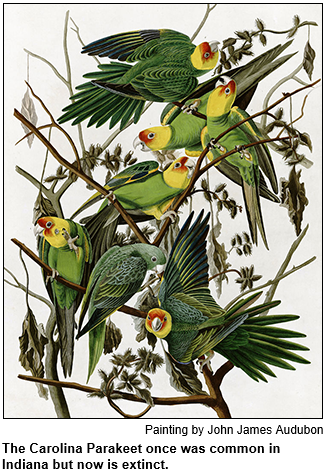 Bison could be found in various regions of the state in 1816, Michael notes. So could such now-gone or greatly diminished (in Indiana) animals and birds as the gray wolf, mountain lion, black bear, Carolina parakeet, ivory-billed woodpecker, prairie chicken, porcupine and avocet. (During a Hoosier History Live show in 2014, we explored passenger pigeons and other extinct species of birds.)
Bison could be found in various regions of the state in 1816, Michael notes. So could such now-gone or greatly diminished (in Indiana) animals and birds as the gray wolf, mountain lion, black bear, Carolina parakeet, ivory-billed woodpecker, prairie chicken, porcupine and avocet. (During a Hoosier History Live show in 2014, we explored passenger pigeons and other extinct species of birds.)
According to research by our guest Michael Homoya - who has studied accounts of pioneers and early travelers as well as surveyors' notes - major types of trees in the 1816 wilderness that became downtown Indy included American beech, black walnut, elm, ash and sugar maple.
What natural phenomenon occurred within five months of Indiana becoming the 19th state in 1816?
"A mass emergence of 17-year cicadas," Michael says. The next emergence of the cicadas, he adds, will be in 2021.
In 1816, the 20 percent of the state that wasn't forest consisted of prairies, barrens and marsh, according to Michael. Northwestern Indiana included, as he puts it, "vast prairies as far as the eye could see."
Michael Homoya, a plant ecologist, has written an article for Outdoor Indiana magazine's January/February issue that describes the new state's landscape in 1816. He is the author of Orchids of Indiana (Indiana University Press) and was our guest in 2014 for a show with gardening expert Jo Ellen Meyers Sharp about plants that are native to the Hoosier state and early botanical explorations.
During our What did Indiana look like 200 years ago? show, Michael discusses the importance of knowing the state's early natural landscape as a "baseline." He also shares details about the aspects of the natural vegetation that have been altered the most.
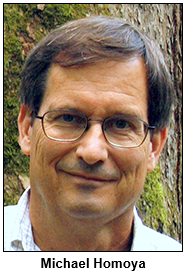 Some other landscape topics related to 1816 Indiana that Michael and Nelson explore:
Some other landscape topics related to 1816 Indiana that Michael and Nelson explore:
Canebrakes. "This is a grassland type essentially gone from Indiana's landscape," Michael notes. "Some were several thousand acres in size prior to settlement, occurring mostly along the lower Ohio and Wabash rivers."
Dense forests and streams. Michael will describe the water quality of the streams 200 years ago, as well as details about the timber lands, natural lakes and open wetlands then.
Landscape diversity. The Hoosier state, then and now, is said to be something of, in Michael's phrase, "an ecological mash-up." Plants and animals in various parts of the state reflect different regions of the country. Swamps in some parts of Indiana, for example, have species similar to those found in the Deep South.
Squirrel "invasions." Mass migrations of squirrels occurred during the 1800s, startling early Indiana residents. Accounts of early settlers described large numbers of squirrels swimming across the White River, Wabash River and Ohio River. This phenomenon, which Michael says "is essentially non-existent today," also was explored during a Hoosier History Live show in January 2014 about quirky aspects of our heritage.
In addition, Michael Homoya tackles the question: "Are there areas existing today that still look as they did in 1816?"
Learn more:
- Distribution and Composition of Canebrakes - Forest Encyclopedia.
- "History 101" article on Indy squirrel invasion of 1822 - Connie Zeigler, Urban Times.
- Where Have All the Forests Gone? - Indiana University.
- An Indiana Prairie - Indiana Department of Natural Resources.
- Squirrel invasion of 1800s and other quirky episodes - Jan. 4, 2014 Hoosier History Live show.
- A History Tour of the Wabash River - video from the Indiana Department of Natural Resources.
Additional research courtesy Jeff Kamm.
History Mystery
|
The oldest tree in Indianapolis is generally considered to be an oak tree located in a historic neighborhood. The tree, a bur oak, may be nearly 400 years old. Motorists often drive to the historic neighborhood to see the oak tree.
Question: In what historic neighborhood is it located?
The prize pack includes a gift certificate to Iaria's Italian Restaurant and two admissions to the Indianapolis Motor Speedway Hall of Fame Museum, courtesy of Visit Indy.
Roadtrip - New visitor center coming for Levi Coffin House
|
Guest Roadtripper Kisha Tandy of the Indiana State Museum tells us about upcoming improvements to the Levi Coffin House in Fountain City, a home once known as the "Grand Central Station of the Underground Railroad."
The home is about to become part of a $3.2 million improvement effort, and most of the money will go toward creating a 5,200-square-foot visitors center adjacent to the 1839 home.
The home's owners, Levi and Catherine Coffin, Quakers from North Carolina, were thought to have helped 2,000 enslaved persons escape to freedom in Canada prior to the Civil War. The house has hidden doors, secret nooks and a water well in the basement.
When completed, the improvement would be the largest to date at the handful of small, state-owned museums around Indiana known as Indiana State Historic Sites.
Maps of Indiana
|
(Feb. 13, 2016) - On a map created in 1778, the name "Indiana" appears for a region that later became part of West Virginia. Other maps from the late 1700s and early 1800s reflect border disputes between Michigan, Ohio, Illinois and the Hoosier state.
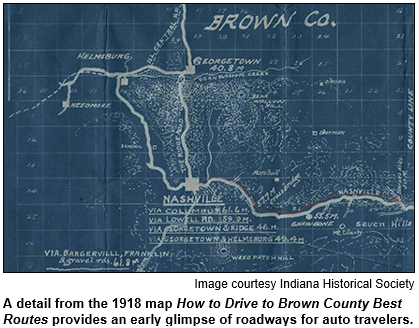 During the early auto era, the first so-called "highway map" of Indiana may have been one distributed in 1919. A map of Indiana's gravel roads was produced in 1895, while a bicycle route map helped 1901 travelers.
During the early auto era, the first so-called "highway map" of Indiana may have been one distributed in 1919. A map of Indiana's gravel roads was produced in 1895, while a bicycle route map helped 1901 travelers.
All of them are among the historic maps we explore as Nelson is joined in studio by two Indiana Historical Society staff members. Eric Mundell and Amy Vedra are co-authors of Mapping Indiana (IHS Press), a new book that features 107 of the more than 1,700 maps in the society's collections. A special exhibit, also titled "Mapping Indiana," has opened at the IHS; like the book, the exhibit includes Old World depictions of North America, including the area that became Indiana.
"Early mapmakers often were working with unknown areas," notes Eric, a sixth-generation Hoosier who is the director of collections management at the IHS. Amy, his colleague, is a native of Griffith in northwest Indiana and the IHS director of reference services.
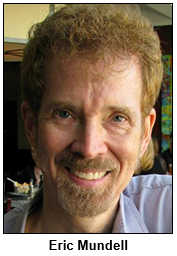 Among the oldest maps in the IHS collection - which spans five centuries - is one created in 1540 by Sebastian Munster, a well-known German mapmaker. Although its depiction of North America is "malformed," as Amy puts it, our guests report that the map has held up well because it, like others during the era, was created on "rag paper," a type of cloth.
Among the oldest maps in the IHS collection - which spans five centuries - is one created in 1540 by Sebastian Munster, a well-known German mapmaker. Although its depiction of North America is "malformed," as Amy puts it, our guests report that the map has held up well because it, like others during the era, was created on "rag paper," a type of cloth.
In Indianapolis, early mapmakers included civic leader William Sullivan (1803-86), an engineer and surveyor who created hand-drawn "bird's-eye view" depictions of the Hoosier capital during the 1830s. Mapping Indiana also includes early bird's-eye view" depictions of such Hoosier cities as Lafayette, South Bend, Greencastle and Madison.
How to Drive to Brown County is the title of a map produced in 1918 for early motorists. 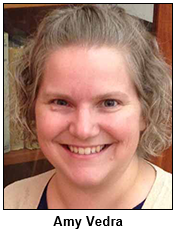 The map includes "road conditions" information as it guides travelers to the isolated, hilly county then becoming known for its colony of artists that included Hoosier Group painter T.C. Steele.
The map includes "road conditions" information as it guides travelers to the isolated, hilly county then becoming known for its colony of artists that included Hoosier Group painter T.C. Steele.
According to our guest Eric Mundell, investors in the undeveloped region labeled "Indiana" (that later became a portion of West Virginia) on the 1778 map included Benjamin Franklin. A settlement planned for the area in the late 1770s never happened.
But the word "Indiana" continued to pop up on maps of wilderness areas that eventually became parts of other states - indicating the name was being kept in mind as pioneers moved west.
Other map heritage facts:
- Some maps of Indiana indicated where Native American tribes once could be found. These maps included some created in the late 1800s and 1900s, long after the tribes had left - or been forcibly removed - from the state.
- In Indianapolis, William Sullivan, the early mapmaker, also was a surveyor and engineer. Eventually, he served on the boards of railroads; they became the focus of many maps beginning in the mid-1800s.
- Sanborn maps of cities were created for fire insurance purposes. Because they often include construction details of buildings, including their height, Sanborn maps have been extremely helpful to historic researchers.
- So-called blue books were created for automobile travelers across Indiana and other states beginning in the 1920s. Some maps from blue books are featured in Mapping Indiana.
- The map collections at the Indiana Historical Society include maps created to be more artistic than informational. Some artistic maps feature depictions of pioneers arriving in the Indiana Territory as well as other illustrations and flourishes.
Learn more:
- Mapping Indiana exhibit - Indiana Historical Society.
- Map of early Indianapolis by William Sullivan - Indiana Historical Society.
- Historic Indiana Maps - Indiana University.
|
History Mystery
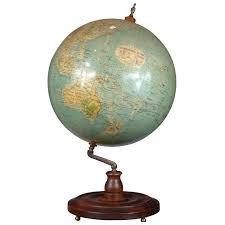 For much of the 20th century, a globe-making company was based in Indianapolis. Although the company became best known for globes, it also made and sold maps and atlases.
For much of the 20th century, a globe-making company was based in Indianapolis. Although the company became best known for globes, it also made and sold maps and atlases.
Its products included globes promoted as the "most usable" in school classrooms.
Beginning in 1921, the company moved several times within the Hoosier capital. For a while, it was located on West 62nd Street. Before that, the business was in a building on LaSalle Street. From the 1930s through the mid-1960s, the globe-making company was located in downtown Indy.
Question: What was the name of the company?
The prize pack includes two admissions to the Indianapolis Museum of Art and two admissions to the President Benjamin Harrison Presidential Site, courtesy of Visit Indy.
Roadtrip - Wander and reflect at St. Mary-of-the-Woods in Vigo County
|
Want to wander around a beautiful, quiet, heavily wooded spot? Guest Roadtripper and architectural historian William Selm suggests a visit to the beauty spot of Vigo County, Saint Mary-of- the-Woods College campus near Terre Haute.
Saint Mary-of-the-Woods College is a Roman Catholic, four-year liberal arts college, now co-educational. The college was founded in 1840 by Indiana's only canonized saint, Mother Theodore Guerin.
At age 93, memories of Walker Theatre, Indiana Avenue and more
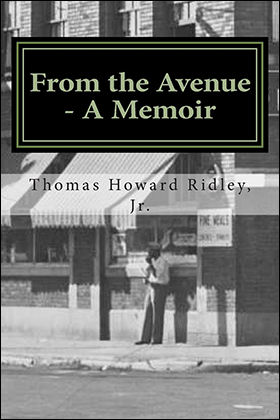 (Feb. 6, 2016) - In 1927, when the Madam Walker Theatre in Indianapolis opened with a gala event, 5-year-old Tom Ridley was in the audience with his parents.
(Feb. 6, 2016) - In 1927, when the Madam Walker Theatre in Indianapolis opened with a gala event, 5-year-old Tom Ridley was in the audience with his parents.
Now 93 years old, Mr. Ridley lived through the heyday of Indiana Avenue, when nightclubs featured jazz musicians who became national stars. He attended Attucks High School before and after service during World War II. That military service included disembarking from a ship on Utah Beach on D-Day in June 1944.
So Mr. Ridley truly has lived through history - local, national and international. He is Nelson's studio guest to share insights as Hoosier History Live salutes Black History Month.
 These days, Mr. Ridley is a beloved docent at the Walker Theatre, where he shares memories from the very beginning of the cultural landmark. During his boyhood in the 1920s and '30s, the Walker building included a basement shop, the Coffee Pot, that Mr. Ridley says became a popular hangout for his friends.
These days, Mr. Ridley is a beloved docent at the Walker Theatre, where he shares memories from the very beginning of the cultural landmark. During his boyhood in the 1920s and '30s, the Walker building included a basement shop, the Coffee Pot, that Mr. Ridley says became a popular hangout for his friends.
"Outside the Coffee Pot, on the corner, the young men would come and look at pretty ladies, who were all dressed up in their finery," he writes in his self-published memoir, From the Avenue. "These same ladies could enjoy the attention of the gentlemen in their zoot suits, which sported very full-legged pants and were narrow at the cuff. Some of us guys wore more conservative clothes, but all were custom made by the local tailors. ... The idea was definitely to see and be seen on this corner."
To this day, Mr. Ridley lives not far away, in the neighborhood now known as Ransom Place.
 Like the Walker Theatre, Attucks High School opened in 1927. One of Mr. Ridley's older brothers, Martin, was in the first group of freshmen.
Like the Walker Theatre, Attucks High School opened in 1927. One of Mr. Ridley's older brothers, Martin, was in the first group of freshmen.
Mr. Ridley began attending Attucks in 1936 but did not graduate until 1947. That's because his high school years were interrupted by World War II. In his memoir, Mr. Ridley writes that his first experience with "blatant, hard-core" bigotry came during military training at camps in Georgia and Mississippi.
After the war, Mr. Ridley returned to Indianapolis and spent most of his career working for the U.S. Postal Service. In his memoir, he describes becoming "one of the first African Americans to work as a window clerk" in the Hoosier capital.
"I have lived through the Depression, World War II, the Civil Rights movement, integration, Vietnam, Afghanistan and the election of a black man as president of the United States," Mr. Ridley writes in his memoir. "When I stop to think about it, it is a bit overwhelming."
Mr. Ridley was born on Dec. 19, 1922. When he attended the grand opening in 1927 of the Madam Walker Theatre as a 5-year-old boy, the building's namesake had been dead for eight years.
But Madam Walker (1867-1919) had the vision for the landmark building. When it opened, it included - in addition to a stage and movie theater - corporate offices for her Madam C.J. Walker Manufacturing Co., a beauty salon, a ballroom and the Coffee Pot cafe.
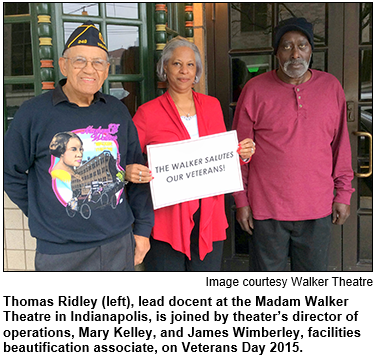 Madam Walker became wealthy by founding a company that created popular hair-care products, including shampoos, ointments and combs. While patronizing a downtown Indy theater in 1914, Madam Walker was startled when she was told tickets for blacks had increased sharply higher than admission for whites. She promptly instructed her attorney to sue the theater.
Madam Walker became wealthy by founding a company that created popular hair-care products, including shampoos, ointments and combs. While patronizing a downtown Indy theater in 1914, Madam Walker was startled when she was told tickets for blacks had increased sharply higher than admission for whites. She promptly instructed her attorney to sue the theater.
"Legend has it that she also vowed that day to build her own movie theater," writes A'Lelia Bundles, the great-great granddaughter of Madam Walker, in one of several books about her famous ancestor and the historic theater building.
As a docent at the Walker, Mr. Ridley has shared the building's history to hundreds of visitors. He also shares memories about growing up near "The Avenue," as Indiana Avenue was known during its musical and cultural heyday.
Among the popular musicians who performed in clubs on Indiana Avenue was Mr. Ridley's future father-in-law, Ben Holliman. He played the banjo, ukulele, saxophone, mandolin and other instruments. Holliman, who performed in bands with jazz notables such as Noble Sissle and Reggie Duvall, died in 1975. His daughter, Mr. Ridley's wife, Louise, a teacher for Indianapolis Public Schools, died in 2010.
Mr. Ridley met his future wife when they attended kindergarten at former IPS School 4.
Learn more:
- Madam Walker: her life, business and theater building - Hoosier History Live newsletter for March 1, 2014 show.
- Jazz history in Indy with Chuck Workman - Hoosier History Live newsletter for Feb. 5, 2011 show.
- Attucks High School history - Hoosier History Live newsletter for Feb. 15, 2014 show.
Roadtrip - Chapel in the Meadow at Camp Atterbury
|
Guest Roadtripper Rachel Hill Ponko, director of public relations at the Indiana Historical Society, suggests a visit to Camp Atterbury, south of Indianapolis near Edinburgh and now a training base for the Indiana National Guard.
During World War II, about 3,000 Italian POWs were housed at Camp Atterbury and were allowed to work on farms within a 25-mile radius. The Italian POWs also used scrap materials to build a chapel called the Chapel in the Meadow. There are four frescoes on the walls and two cross-shaped windows on either side of the building.
The Indiana Historical Society will open an exhibit, You Are There 1943: Italian POWs at Atterbury that will allow visitors to walk through a life-sized replica of the chapel. The exhibit is set to open in the spring of 2017.
The small Camp Atterbury Museum also is open to the public; you can an learn more about the history of the Chapel in the Meadow and of Camp Atterbury.
History Mystery
 Famous graduates of Attucks High School include a singer who has been the star of concerts at the Madam Walker Theatre.
Famous graduates of Attucks High School include a singer who has been the star of concerts at the Madam Walker Theatre.
The soprano, an Indianapolis native who has been nominated for a Grammy Award, is best known for her opera performances, including at the Metropolitan Opera in New York City. She also has performed with symphonies and opera companies everywhere from Philadelphia and San Antonio to Paris.
She graduated from Attucks in 1982, then studied at the Indiana University School of Music. In addition to opera, she performs African-American spirituals and a range of popular music.
In 2009, she was inducted into the Indianapolis Public Schools Hall of Fame.
Question: Who is she?
The prize pack includes a gift certificate to Arni's Restaurant, courtesy of Visit Indy, and two tickets to the Indiana State Museum, courtesy of the State Museum.
Toys, toys and more toy heritage
(Jan. 30, 2016) - In terms of the social impact across the country and business impact across the state, Indiana's heritage with toys has not just been fun and games.
 Consider an early gyroscope, the Pet Tornado, cartoon characters Garfield and Clifford the Big Red Dog, Raggedy Ann, Lincoln Logs and croquet sets made in the 1870s, as well as a digital "animated version of the rubber duck" enjoyed today. All of them have had deep Hoosier roots.
Consider an early gyroscope, the Pet Tornado, cartoon characters Garfield and Clifford the Big Red Dog, Raggedy Ann, Lincoln Logs and croquet sets made in the 1870s, as well as a digital "animated version of the rubber duck" enjoyed today. All of them have had deep Hoosier roots.
To explore enough Indiana toy connections to fill a playroom, Nelson is joined by studio guests including Kara Reibel, a freelance writer and editor who has researched the links between nationally distributed toys and Hoosiers.
According to Kara, the "Original Gyroscope" was first manufactured in 1917 by Hoosiers. The gyroscope - as well as the Pet Tornado, the "Original Blocks and Marbles" and other "nostalgia toys" - are made today by TEDCO Toys in Hagerstown.
The South Bend Toy Company, which began by making croquet sets and expanded to products such as rocking horses known as "Shoo Fly Rockers," was one of the northern Indiana city's largest employers for more than 100 years. (After a series of corporate acquisitions and mergers, the plant in South Bend shut down in 1985.)
And talk about a big footprint: Guinness World Records lists Garfield, the comic strip about a cantankerous cat created by Jim Davis, who grew up on a farm near Fairmount, as the most widely syndicated comic strip in the world.
 Jim Davis and his team at PAWS Inc., which is headquartered on a wooded retreat near the town of Albany, draw the strip and create an array of Garfield products such as dolls with suction-cup paws, books and posters.
Jim Davis and his team at PAWS Inc., which is headquartered on a wooded retreat near the town of Albany, draw the strip and create an array of Garfield products such as dolls with suction-cup paws, books and posters.
Clifford the Big Red Dog was created by Kokomo native Norman Bridwell, who died in 2014 at age 86. Bridwell attended the Herron School of Art, then moved to the East Coast and reaped widespread success with Clifford, the slightly clumsy main character in read-aloud books for young children and a TV series. The books have been translated into 13 languages.
 Our guest Kara Reibel is the community relations specialist at Carmel-based pi lab, which is enjoying success with Edwin the Duck, a computer app-enhanced children's educational toy. Often touted as an "animated version of the classic rubber duck," Edwin was honored earlier this month at a "Last Gadget Standing" competition in Las Vegas.
Our guest Kara Reibel is the community relations specialist at Carmel-based pi lab, which is enjoying success with Edwin the Duck, a computer app-enhanced children's educational toy. Often touted as an "animated version of the classic rubber duck," Edwin was honored earlier this month at a "Last Gadget Standing" competition in Las Vegas.
Some fun facts related to our toy heritage:
- The Garfield balloon in the Macy's Thanksgiving Day Parade was filled with 18,907 cubic feet of helium, making it the biggest parade balloon in history, according to Kara's research.
- The "Original Blocks and Marbles" toys distributed by TEDCO include blocks made by Amish residents of Wayne County.
- Raggedy Ann was created by Johnny Gruelle (1880-1938), who grew up in the Lockerbie neighborhood of Indianapolis and was a cartoonist for The Indianapolis Star for several years before moving to the East Coast. Raggedy Ann made her debut in a book published in 1918; the dolls initially were spinoff products, hand-made by Gruelle family members with small hearts sewn into their chests. Gruelle descendants have told Nelson, our host, that the inspiration for the famous character was Johnny's recollection of his two favorite poems by family friend James Whitcomb Riley: Little Orphant Annie and The Raggedy Man.
So what's the Lincoln Logs link with Indiana?
The popular toy was invented by prominent architect John Lloyd Wright (1892-1972), the son of an even more famous architect, Frank Lloyd Wright. Shortly after Long Beach, Ind., was founded as a resort town on Lake Michigan during the early 1920s, John Lloyd Wright moved there to set up an architectural practice. 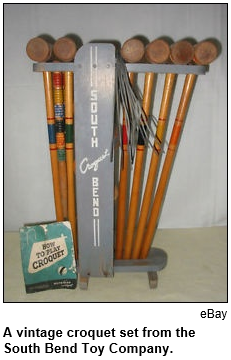 He designed several homes and other structures in Long Beach, which is in LaPorte County.
He designed several homes and other structures in Long Beach, which is in LaPorte County.
Lincoln Logs have been inducted into the National Toy Hall of Fame. So have Raggedy Ann and her "brother," Raggedy Andy, who made his debut in 1920.
Initially, Raggedy Ann and Andy dolls had hair made of brown yarn. Since the early 1950s, though, the siblings have been red-haired. In the beginning, when the dolls were hand-made, cardboard or candy hearts were sewn into their chests. The hearts could easily be felt when Raggedy Ann and Andy were hugged.
Clifford the Big Red Dog made his debut in 1963. His "owner" is a little girl named Emily Elizabeth, who rides her huge dog like a horse. (Bridwell named Clifford's owner as a tribute to his daughter, also Emily Elizabeth.)
Garfield was "born" in 1978, meaning the world-famous cat turns 38 this year. According to research by our guest Kara Reibel, eleven Garfield books have made The New York Times bestseller list; the first, Garfield at Large, was published in 1980.
Final fun fact: Also according to Kara's research, Academy Award-winning movie star Halle Berry has a Garfield tattoo.
Learn more:
- Indiana boasts big toy heritage - Inside Indiana Business.
- 100 Toys that Define Our Childhood - Indianapolis Children's Museum exhibit.
Additional research for this article provided by Jeff Kamm.
Roadtrip - Greensburg, more than a courthouse tree
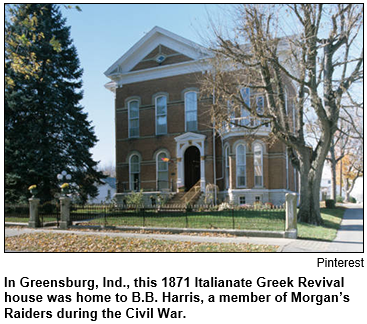 Guest Roadtripper John Pratt, a history teacher at Greensburg High School, suggests a Roadtrip to his hometown of Greensburg. Every visit to the small town of 11,000, southeast of Indianapolis in Decatur County, begins at the downtown courthouse to take a glimpse at the famous tree growing from the courthouse tower. But there is much more to see.
Guest Roadtripper John Pratt, a history teacher at Greensburg High School, suggests a Roadtrip to his hometown of Greensburg. Every visit to the small town of 11,000, southeast of Indianapolis in Decatur County, begins at the downtown courthouse to take a glimpse at the famous tree growing from the courthouse tower. But there is much more to see.
The town square is filled with restaurants, antique stores and an art gallery. A short walk to 413 N. Franklin St. takes you to the Italianate Greek Revival home of B.B.Harris, a member of Morgan's Raiders. And across the street is the Porter Oliger-Pearson Funeral Home. The funeral home building is the former home of former Lieutenant Governor Will Cumback, who cast Indiana's first ever Republican electoral vote, and that going to his friend Abraham Lincoln.
Heading south, you can enter the Decatur County Historical Museum, filled with a treasure trove of early Native American artifacts and local historical items. One block further south takes you back to the courthouse square, where presidential candidate Robert Kennedy gave a speech in 1968 as he marveled at the mulberry tree on top. Directly across the street, no visit is complete without a visit to Storie's Family Restaurant, the famous local eatery known for tenderloin sandwiches and homemade pie.
History Mystery
|
Garfield creator Jim Davis always has maintained that the cat's owner, socially awkward Jon Arbuckle, is based on Jim Davis himself. Like the cartoonist's parents, who owned a cattle farm near Fairmount, the parents of Jon Arbuckle have a farm.
Also like Garfield's owner, Jim Davis has a brother. The real-life brother has the same nickname as the brother character in the popular comic strip.
Question: What is the brother's nickname?
The prize pack includes a gift certificate to LePeep Restaurant and two admissions to the Benjamin Harrison Presidential Site, courtesy of Visit Indy.
Book release
Jill Ditmire of WFYI and Bookmamas feature Then and Now book
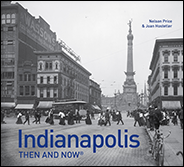 It's here! A major revision of the visual history book Indianapolis Then and Now (Salamander Press), written by our host Nelson Price, has become available.
It's here! A major revision of the visual history book Indianapolis Then and Now (Salamander Press), written by our host Nelson Price, has become available.
Nelson's collaborators are co-author and photo historian Joan Hostetler of Heritage Photo, who tracked down the vintage "Then" images, and Garry Chilluffo of Chilluffo Photography, who took the "Now" color photos. More than half of the book has been revised in the new edition of the book, which originally was published in 2004.
You can listen to Nelson Price and Joan Hostetler on WFYI 90.1 FM on Friday, Jan. 29, at about 5:44 p.m. with host Jill Ditmire, who also has been a guest host on Hoosier History Live.
And Bookmamas in Irvington will host a party for the book release at 2 p.m. on Sunday, Jan. 31, at its store at 9 S. Johnson Ave. in Indianapolis. The party is free and open to the public, and of course you get to meet Nelson, Joan and Garry in person. And you can buy a book and have it signed, if you so choose!
First Lady Karen Pence on Indiana's bicentennial
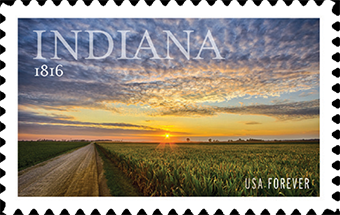 (Jan. 23, 2016) - She has been an art teacher and watercolor artist specializing in portraits of historic buildings and homes. Since Karen Pence became Indiana's first lady in 2012, she also has created a charitable foundation and, as an entrepreneur, has launched a small business that she oversees from an office in the governor's residence.
(Jan. 23, 2016) - She has been an art teacher and watercolor artist specializing in portraits of historic buildings and homes. Since Karen Pence became Indiana's first lady in 2012, she also has created a charitable foundation and, as an entrepreneur, has launched a small business that she oversees from an office in the governor's residence.
Mrs. Pence also is the official ambassador for Indiana's 2016 Bicentennial, a role she discusses as she joins Nelson in studio. Nelson also is joined by Perry Hammock, executive director of the Indiana Bicentennial Commission, who shares insights about projects and events underway or planned in communities as Hoosiers celebrate the state's 200th birthday.
Mrs. Pence, 60, grew up in the Broad Ripple neighborhood of Indianapolis and taught in Indianapolis-area schools for about 13 years. Her own educational background is intriguing: As an elementary student during the 1960s, Mrs. Pence - then Karen Batten - attended Park School, a forerunner of Park Tudor. (In that era, girls could attend Park School at the elementary level; Park did not become fully co-ed until its merger with Tudor Hall in 1970.) She is a graduate of Chatard High School and Butler University.
 During our show, Nelson asks Mrs. Pence about her life as a Hoosier. A bit of trivia: According to an Indianapolis Star profile in 2012, future Gov. Mike Pence proposed marriage as the two walked along the canal - and fed the ducks - near Broad Ripple. The Pences, who were married in 1985, are the parents of three grown children: a son, Michael, and two daughters, Charlotte and Audrey.
During our show, Nelson asks Mrs. Pence about her life as a Hoosier. A bit of trivia: According to an Indianapolis Star profile in 2012, future Gov. Mike Pence proposed marriage as the two walked along the canal - and fed the ducks - near Broad Ripple. The Pences, who were married in 1985, are the parents of three grown children: a son, Michael, and two daughters, Charlotte and Audrey.
As the Bicentennial Ambassador, Mrs. Pence has been traveling across the state. So during our show, Mrs. Pence and Perry Hammock discuss a range of local projects; Perry shared details about several others when he joined Nelson for a Hoosier History Live show last September that previewed the Bicentennial - or, in the case of some counties and towns that were organized before Indiana's statehood in 1816, followed up on local celebrations that already have occurred.
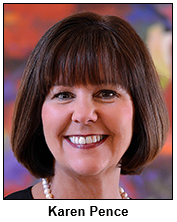 Mrs. Pence has created the Indiana First Lady's Charitable Foundation, a nonprofit that awards scholarships and grants working to help children and families; recipients have included Riley Hospital for Children's Art Therapy initiative. According to an article in The Indianapolis Star, $165,000 was awarded to groups and individuals in 68 counties in 2014.
Mrs. Pence has created the Indiana First Lady's Charitable Foundation, a nonprofit that awards scholarships and grants working to help children and families; recipients have included Riley Hospital for Children's Art Therapy initiative. According to an article in The Indianapolis Star, $165,000 was awarded to groups and individuals in 68 counties in 2014.
She also is the founder of That's My Towel Charm Inc., a small business. According to the Fort Wayne Journal-Gazette, the charms designed by Mrs. Pence are "similar to those used to differentiate wine glasses, but are aimed at bath and beach towels."
As a teacher during the 1980s and '90s, Mrs. Pence taught at schools ranging from Orchard School to John Strange Elementary, Acton Elementary and Fall Creek Elementary. 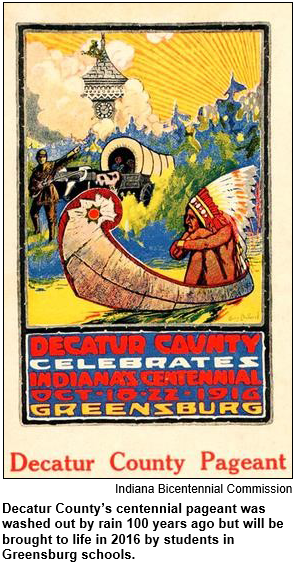 In addition to traveling across Indiana to promote the Bicentennial, Mrs. Pence also has been on the road to visit local schools to tout educational and art initiatives.
In addition to traveling across Indiana to promote the Bicentennial, Mrs. Pence also has been on the road to visit local schools to tout educational and art initiatives.
Another bit of trivia: According to the profile story in The Star, she was in the midst of painting a portrait nearly 20 years ago of the governor's residence - her current home at 4750 N. Meridian Street in Indianapolis - when security ordered her to leave. The Pences, by the way, have been living full-time in the residence, in contrast to their predecessors, Mitch and Cheri Daniels, who just used the historic mansion for special functions.
Certainly the Bicentennial will involve special events there, as well as at hundreds of other sites. As a tribute to the Bicentennial, the U.S. Postal Service a few weeks ago unveiled a new postage stamp set for release later this year. The image on the stamp is a photo depicting a brilliant sunset over a cornfield in northern Indiana.
In addition to sharing details about the Bicentennial postage stamp, our guest Perry Hammock highlights projects such as:
- A rescheduling, after 100 years, of a rain-delayed pageant in Decatur County. To celebrate the Centennial in 1916, an extensive, outdoor pageant, including a parade, was planned in the county that includes Greensburg. A 60-page booklet was published for the festivities. After the parade, though, continual rainfall resulted in postponements of the pageant for several days - at which point, cold weather set in. So the never-performed pageant will be staged with the help of students at Greensburg High School and Greensburg Junior High.
 (A key organizer of the revived pageant is John Pratt, a history teacher who was a Hoosier History Live guest last October for a show about the heritage of Greensburg and Decatur County.)
(A key organizer of the revived pageant is John Pratt, a history teacher who was a Hoosier History Live guest last October for a show about the heritage of Greensburg and Decatur County.) - In Blackford County, the collection of oral histories of women - many now in their 90s - who had business and professional careers, served in the military and were influential figures as local philanthropists or family matriarchs. The women are being interviewed by local youths. Their stories will be shared on the Blackford County Historical Society website, in exhibits and in other ways as part of a 2016 Women of Worth program.
- And in historic New Harmony, various events planned in the southwestern Indiana village that was the setting for two experiments in utopian living. Earlier this month, Perry Hammock attended an event with historic interpreters at the Working Men's Institute, Indiana's oldest continually operating public library. Interpreters portrayed such historic figures from New Harmony as Col. Richard Owen, a geologist, Civil War soldier and the son of social reformer Robert Owen, founder of one of the utopian experiments.
Roadtrip - Vincennes, the Old Cathedral and state preservation
Guest Roadtripper Suzanne Stannis, director of heritage education at Indiana Landmarks, suggests more to explore in Indiana's oldest town, Vincennes, which
pre-dates Indiana statehood by 84 years.
 She tells us: "Though its Native American history extends much further, the official date of European settlement for Vincennes is 1732, when it was established as a French fur trading post. Today French culture is reflected in early architecture and the traditional church fricassee dinners."
She tells us: "Though its Native American history extends much further, the official date of European settlement for Vincennes is 1732, when it was established as a French fur trading post. Today French culture is reflected in early architecture and the traditional church fricassee dinners."
The city also boasts the largest memorial monument west of Washington, D.C. and the first Catholic parish in Indiana. The George Rogers Clark Memorial, a National Historic Landmark and part of a National Park, was dedicated in 1936 to commemorate Clark's taking of the British-controlled Fort Sackville in 1779.
Construction of the Basilica of Saint Francis Xavier, also known as the Old Cathedral, began in 1826. Its crypt holds the remains of the four bishops, including that of Simon Bruté, who supervised the Cathedral's construction. Following structural repairs in 2006, artists renewed the interior of the Cathedral, including faux stone and wood finishes and gold gilding.
Grouseland, constructed 1802-1804 for territorial governor and ninth U.S. President William Henry Harrison, is an impressive Federal-style home built when most of the state's population still lived in log structures. The home is owned by the Daughters of the American Revolution, who recently received a grant to complete a historic structures report which will guide future preservation efforts.
Suzanne also tells us about Preserving Historic Places: Indiana's Statewide Historic Preservation Conference, which will be held in Vincennes April 27-29, 2016. Here's an opportunity to tour our oldest town, as well as learn more about our state's heritage. Online registration opens Feb. 1.
History Mystery
A major legacy from Hoosier state's centennial in 1916 is the creation of Indiana's state park system. The first two state parks created 100 years ago were McCormick's Creek and Turkey Run.
 During the 1920s, a state park was created that features a large grist mill built in 1817 and several historic cabins. The structures had been part of a flourishing village during the early 1800s. But for several reasons, including the coming of railroads that bypassed the small town, the village declined and was abandoned by the 1890s.
During the 1920s, a state park was created that features a large grist mill built in 1817 and several historic cabins. The structures had been part of a flourishing village during the early 1800s. But for several reasons, including the coming of railroads that bypassed the small town, the village declined and was abandoned by the 1890s.
Today, the state park features a "Brigadoon"-like recreation of a pioneer settlement. In addition to the grist mill and restored, historic cabins, the recreated village includes structures built elsewhere during the pioneer era and moved to the state park, as well as re-creations of historic buildings. Some of the cabins are furnished with oil paintings and historic quilts.
Question: What is the Indiana state park with the Brigadoon-like village created from a town that had been abandoned?
The prize pack includes a two tickets to the Indiana State Museum, courtesy of the Indiana State Museum, and tickets to Sky Zone Trampoline Park in Fishers and two tickets to Rhythm Discovery Center, courtesy of Visit Indy.
How to excite young people about history
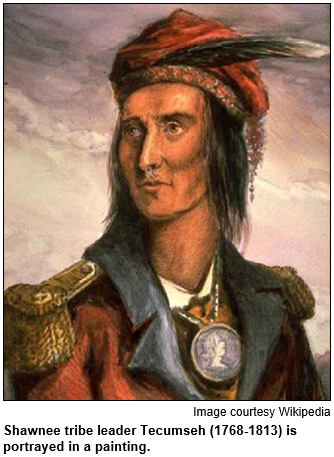 (Jan. 16, 2016) - With colorful and captivating characters, perpetual conflicts, unsolved mysteries and dramatic changes in everything from fashion to modes of transportation, history surely has the potential to be intriguing.
(Jan. 16, 2016) - With colorful and captivating characters, perpetual conflicts, unsolved mysteries and dramatic changes in everything from fashion to modes of transportation, history surely has the potential to be intriguing.
But sparking interest in previous generations and earlier eras can be a challenge. Even the word "history" can be a turn-off for teenagers and children.
To share advice for parents, grandparents, educators and anyone else seeking to ignite a history passion in young people, Nelson is joined in studio by two teachers hailed for success in this endeavor:
- Shane Phipps, an 8th-grade history teacher and social studies department chair at Decatur Middle School in Indianapolis. Shane is the author of The Carter Journals (Indiana Historical Society Press, 2015), a novel in which a 14-year-old boy, Cody Carter, embarks on adventures inspired by dusty, ancestral journals given to him by his grandfather. Like his fictional character, Shane developed an interest in history because of his grandfathers; also like Cody Carter, he discovered that some of his ancestors had been slave owners.
- And Chris Edwards, a world history teacher at Fishers High School. Chris, a resident of New Palestine, is the author of Connecting the Dots in World History (Rowman & Littlefield Education, 2015), a five-volume series.
Both of our guests say they use the compelling story of Tecumseh, the Shawnee chief based in Indiana during the early 1800s, as a way to intrigue young people. 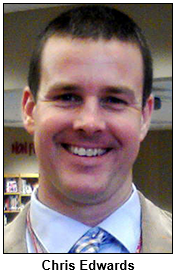 Often considered the greatest Native American leader in history, Tecumseh traveled from the Alleghenies to the Everglades to the Ozarks in his crusade to unite diverse tribes into a confederacy to stop the waves of white settlers.
Often considered the greatest Native American leader in history, Tecumseh traveled from the Alleghenies to the Everglades to the Ozarks in his crusade to unite diverse tribes into a confederacy to stop the waves of white settlers.
In fact, our guest Shane Phipps says he has posed this question to his students: "Should Andrew Jackson continue to be honored on the $20 bill or replaced by someone like Tecumseh?"
When dealing with students, Shane also stresses "big-picture topics that flow as an undercurrent" throughout the course of history and the connections between events in various eras.
"As an example," he says, "I begin teaching the causes of the Civil War while we are still studying the 13 colonies, because that is where the roots lie."
As a hobby, Shane's maternal grandfather researched the burial location of Hoosier veterans of the Revolutionary War and Civil War, seeking out cemeteries in remote locations.
"As he advanced in age, his eyesight began to fail, and it became impossible for him to read the information on the tombstones, many of which are so worn that they are difficult for those with perfect vision to read," Shane recalls.  "So I, as a teen, was called upon to be my grandfather's 'eyes' so that he could gather information."
"So I, as a teen, was called upon to be my grandfather's 'eyes' so that he could gather information."
Our guest Chris Edwards emphasizes that delving into history enhances young people's ability to analyze evidence, connect information to other subjects, present an argument and other skills. He wrote his history books when his youngest son, 6-year-old Ben, was a toddler and was being treated for a rare brain cancer at Riley Hospital for Children.
"I wasn't sleeping anyway, so I thought I would write a history of the world," Chris says. Ben has been in remission for five years.
Regarding enthusiasm for history: Both of our guests emphasize to young people that all of us, every day, are making history of our own.
The Carter Journals, the new book by Shane, focuses on the colorful lives of the young protagonist's ancestors on the frontiers of North Carolina, Tennessee and Indiana.
Several scenes are set in the Indiana Territory (before statehood was achieved in 1816), with episodes unfolding in Vincennes and on the Tippecanoe and Wabashrivers. Later episodes involve escaped slaves on a Whitewater River canal boat, with the southern Indiana towns of Brookville and Metamora as settings.
The Carter Journals concludes with young Cody Carter exploring the strife that unfolded in Indiana during the Civil War when Morgan's Raiders charged through towns and counties in the southern part of the state. In 1863, Confederate Gen. John Hunt Morgan led soldiers as they used steamboats to cross the Ohio River from Kentucky into Indiana. Then the Confederates ransacked homes, stores and farms, burning bridges as they charged.
Shane notes that fictional Cody Carter's grandfather is "loosely based" on his paternal grandfather.
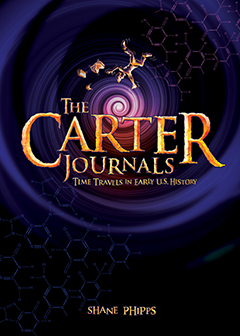
 |
Roadtrip - Enjoying the snow on Hoosier slopes
Sam Alderfer, Guest Roadtripper and Social Media Coordinator for the Indiana Bicentennial Commission, suggests we take a Roadtrip to one of Indiana's two major ski slopes in operation during the winter season, Perfect North Slopes and Paoli Peaks.
"Indiana is not the state you'd expect to have a ski industry, let alone ski resorts," Sam tells us. "This Midwestern state is better known for its steel production and agriculture. However, the state gets an average of 22 inches of snow each year. Southern Indiana, in particular, has hills that can reach more than 800 feet above sea level."
 He continues: "Nestled in these southern Indiana hills are Indiana's two unexpected ski slopes. Together with packages from the nearby hotels, the slopes offer a ski vacations that are more like what you might find in the Rocky Mountain ski facilities."
He continues: "Nestled in these southern Indiana hills are Indiana's two unexpected ski slopes. Together with packages from the nearby hotels, the slopes offer a ski vacations that are more like what you might find in the Rocky Mountain ski facilities."
Perfect North was formed by the Perfect Family and others in 1980 in Dearborn County in the southeastern part of the state. Initially funded by the sale of cattle by Clyde and Ella Mae Perfect, the ski resort began with two handle tows and a rope tow on two ski runs on the "big" hill, as well as two rope tows on the bunny slope. The resort now boasts five chairlifts, which includes one blue square (intermediate) and two black-diamond (expert) ski runs. Perfect North did not allow snowboarding until 2002.
Perfect North is also home to one of the country's most talented skiers, Nick Goepper, who won a bronze medal at the 2014 Winter Olympics. He also has won three gold medals and a silver at the Winter X Games in the Slopestyle contest.
If you are up for a special challenge, visit Paoli Peaks in Orange County. Paoli Peaks is one of the few resorts that has extensive night skiing. During most of the ski season they are open after dark until 9 p.m. on weeknights. A few times a year, however, they offer "Old School Midnight Madness," when they reopen the slopes starting at midnight up until 6 a.m.
History Mystery
A high school in Hendricks County is the alma mater of our guest Chris Edwards, who today lives in New Palestine and teaches at Fishers High School.  The Hendricks County high school resulted from the consolidation more than 40 years ago of high schools in three small towns.
The Hendricks County high school resulted from the consolidation more than 40 years ago of high schools in three small towns.
Each of the three towns had its own high school for decades prior to consolidation in the mid-1970s. The consolidated high school is located in one of the three towns. The school has a distinctive name that reflects its heritage as a result of a merger.
Question: Name the high school in Hendricks County and the town in which it is located.
The prize pack includes a gift certificate to Le Peep Restaurant and two passes to the NCAA Hall of Champions, courtesy Visit Indy.
Hidden history treasures
|
(Jan. 9, 2016) - Tucked away in an attic or closet, you discover long-forgotten diaries, photos, letters or a manuscript for a book.
How do you know if they are historic treasures, or of little interest beyond your family?
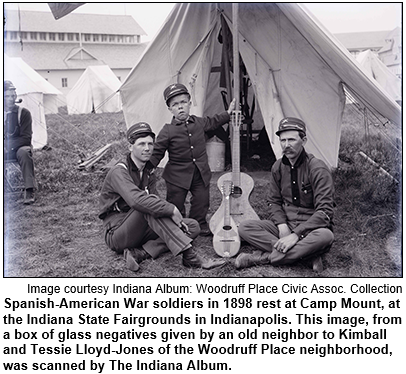 To offer advice, tips and anecdotes about what's valuable historically and what's not (note the emphasis on "historic"; our focus isn't on monetary worth), three guests join Nelson in studio. The guests have different areas of focus regarding hidden history treasures, ranging from vintage photos to Civil War letters of a Hoosier soldier to the manuscript of a novel forgotten for 65 years. Our guests are:
To offer advice, tips and anecdotes about what's valuable historically and what's not (note the emphasis on "historic"; our focus isn't on monetary worth), three guests join Nelson in studio. The guests have different areas of focus regarding hidden history treasures, ranging from vintage photos to Civil War letters of a Hoosier soldier to the manuscript of a novel forgotten for 65 years. Our guests are:
- Photo historian Joan Hostetler, founder of the Indiana Album, who has been traveling across the state - from South Bend and Huntington to Lafayette and Rushville - overseeing scan-a-thons to preserve vintage photos, postcards, maps and illustrations found in attics, drawers and scrapbooks. Although people tend to fixate on the accomplishments of ancestors, photos depicting them may be historic gems not because of the people. Instead, the images are "finds" because of a bygone landmark, house or other structure where the ancestors posed. The photo may be the only visual documentation of the demolished structure.
- Martha Sue Batt, a board member of the Society of Indiana Pioneers, who discovered the manuscript of an intensely descriptive novel of early Indiana written by her grandfather that had been passed from attic to attic.
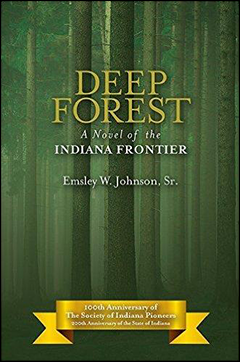 Described as Indiana's "lost book" equivalent of Harper Lee's forgotten manuscript Go Set a Watchman, the novel, titled Deep Forest, is being published to celebrate the state's Bicentennial by the Society of Indiana Pioneers, descendants of the original settlers, in partnership with Hawthorne Publishing. Martha Sue's grandfather, Emsley W. Johnson Sr., was a well-known Indianapolis civic leader and attorney who prosecuted politicians for accepting graft from the Ku Klux Klan. He died in 1950 after spending years researching Deep Forest, which spans decades from the Battle of Tippecanoe in 1811 to the Civil War.
Described as Indiana's "lost book" equivalent of Harper Lee's forgotten manuscript Go Set a Watchman, the novel, titled Deep Forest, is being published to celebrate the state's Bicentennial by the Society of Indiana Pioneers, descendants of the original settlers, in partnership with Hawthorne Publishing. Martha Sue's grandfather, Emsley W. Johnson Sr., was a well-known Indianapolis civic leader and attorney who prosecuted politicians for accepting graft from the Ku Klux Klan. He died in 1950 after spending years researching Deep Forest, which spans decades from the Battle of Tippecanoe in 1811 to the Civil War. - And historian Tom Krasean, a retired staff member for the Indiana Historical Society whose distinguished career also included serving as Indiana's state archivist and as a field representative for the Indiana State Library. In early jobs, Tom visited homes to examine diaries, letters and documents.
During our show, Tom describes his visit to a Delphi house whose owner wondered whether her ancestor's hand-written collection of recipes would be of general interest. Although that wasn't the case, Tom was intrigued when she mentioned that a trunk in her closet contained 660 letters.
They turned out to be extraordinarily significant: letters written by an Indiana soldier fighting in the Civil War, as well as mail to him from his relatives on the Hoosier home front. The latter is particularly rare, Tom says.
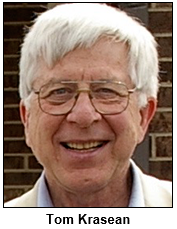 "Letters received by soldiers often didn't survive because they were carried from camp to camp and even into battle," he explains. "I went back to her house for days and days with a portable camera - this was in the 1960s - and photographed these Civil War letters."
"Letters received by soldiers often didn't survive because they were carried from camp to camp and even into battle," he explains. "I went back to her house for days and days with a portable camera - this was in the 1960s - and photographed these Civil War letters."
Tom, a native of South Bend, also once was contacted by a woman who had original letters from a famous American associated with his hometown. She owned six letters written by South Bend politician Schuyler Colfax, who served as vice president under Ulysses S. Grant. Before that, Colfax was speaker of the house during the presidency of Abraham Lincoln, who became a close friend. (Colfax, who was invited to accompany the Lincolns to Ford's Theater on the night of the president's assassination, is generally thought to have been the last public figure to shake his hand.)
Discoveries of historic gems like the Colfax letters are counterbalanced by letters, photos and manuscripts that have little significance other than just being old. 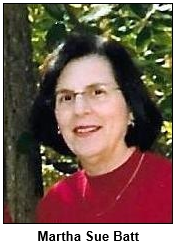 Experts also note the popularity of TV shows like Antiques Roadshow sometimes elevate expectations about the worth of more than just furnishings, collectibles and other artifacts in attics and closets.
Experts also note the popularity of TV shows like Antiques Roadshow sometimes elevate expectations about the worth of more than just furnishings, collectibles and other artifacts in attics and closets.
On the other hand, our guest Joan Hostetler of the Indiana Album notes that many ancestral photos have value beyond the immediate family because they depict neighborhood history, former fashions and hairstyles, architectural history or images of bygone restaurants (including drive-ins), schools and stores.
"As a society, we edit out embarrassing incidents," Joan adds. "For example, the KKK was huge in Indiana, yet it is difficult to find snapshots of Klan rallies, initiations and other events. After the downfall of the Indiana Klan ... members distanced themselves from the organization. They, or their descendants, often discarded photographs documenting their involvement with the Klan."
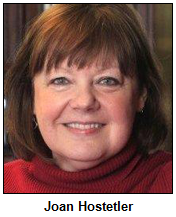 Joan also indicates another challenge with vintage images that may have been treasured by previous generations: "As our society has become more digital, younger people do not understand how traditional photography worked and are discarding items such as slides and glass negatives."
Joan also indicates another challenge with vintage images that may have been treasured by previous generations: "As our society has become more digital, younger people do not understand how traditional photography worked and are discarding items such as slides and glass negatives."
She notes that members of the Woodruff Place Civic League, which represents one of the most distinctive historic neighborhoods in Indy, have shared four boxes of glass negatives from 1895 to 1905. They depict everything from the nearby former U.S. Arsenal (now the site of Arsenal Tech High School) to Spanish-American War soldiers at a former camp located at the current Indiana State Fairgrounds.
Our guest Joan Hostetler collaborated with Nelson, our host, and photographer Garry Chilluffo on Indianapolis Then and Now (Salamander Books), a visual history of the Hoosier capital that originally was published in 2004; a substantially revised edition is being released this month.
Deep Forest, the book discovered as "hundreds of rumpled old papers" by our guest Martha Sue Batt, draws on the experiences of her grandfather's Hoosier ancestors. When her grandfather died in 1950, Martha Sue was in the first grade. Neither she nor other surviving relatives were aware that Emsley W. Johnson Sr. had spent years researching and writing a novel that reflected the state's earliest history.
History Mystery
Although some diaries have only sentimental value to family members, others are immensely valuable to historians. Those diaries include a multi-volume set written during the 1830s and '40s by an early Indianapolis civic leader.
 A lawyer, banker, and politician, he was born in New England and came to Indianapolis just as the new Hoosier capital was getting under way in the early 1820s. He owned a farm of nearly 270 acres just southeast of the Mile Square and may have begun writing extensive diaries soon after his arrival. But only his diaries written beginning in 1832 - about a dozen volumes - survive.
A lawyer, banker, and politician, he was born in New England and came to Indianapolis just as the new Hoosier capital was getting under way in the early 1820s. He owned a farm of nearly 270 acres just southeast of the Mile Square and may have begun writing extensive diaries soon after his arrival. But only his diaries written beginning in 1832 - about a dozen volumes - survive.
A devout Methodist who was dedicated to civic improvement in his adopted hometown, he served in the Indiana state legislature and helped organize everything from a bank to an early charitable organization called the Indianapolis Benevolent Society.
His extensive diaries - which describe the daily weather and a range of other aspects of life - are considered among the most important accounts of early Indianapolis.
Question: Who was the diarist?
The prize pack includes a gift certificate to Le Peep Restaurant and two passes to the Eiteljorg Museum, courtesy Visit Indy.
Roadtrip - Miller Beach in Gary
Guest Roadtripper and author and travel writer Jane Ammeson suggests a Roadtrip to Miller Beach, four miles east of downtown Gary on Lake Michigan. Jane will tell us that this jewel of a beach community, with some longtime family-owned restaurants and an art scene, used to be used as a setting for silent movies.
The fabulous the two-story beachfront structure now known as the Aquatorium is a former bathing pavilion; now renovated and open to the public for a stunning view of Lake Michigan. It is located in Marquette Park, which includes 241 acres of walking trails, lagoons, sand dunes, an indigenous oak savanna and 1.4 miles of beach. Remember that in Indiana, treasure is everywhere!
200 years, 200 influential Hoosiers
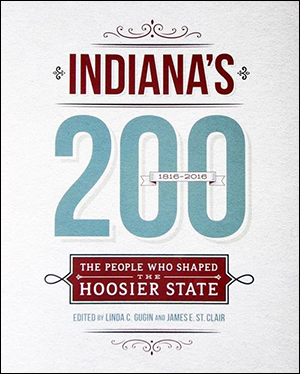 (Jan. 2, 2016) - You probably are aware of Holiday World, the popular tourist attraction in Spencer County that evolved from a theme park in the 1940s called Santa Claus Land.
(Jan. 2, 2016) - You probably are aware of Holiday World, the popular tourist attraction in Spencer County that evolved from a theme park in the 1940s called Santa Claus Land.
Did you know, though, the Breathalyzer was invented by a Hoosier?
Or that a teacher from Clinton County became known as the "Mother of the Dick and Jane books" used to teach Baby Boomers to read?
The influential people involved with these innovations are among the 200 deceased Hoosiers profiled in a new book published in connection with the state's 200th birthday during this new year.
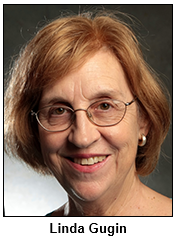 Indiana's 200: The People Who Shaped the Hoosier State (Indiana Historical Society Press) includes household names like Kurt Vonnegut, Madam Walker, James Whitcomb Riley and John Dillinger.
Indiana's 200: The People Who Shaped the Hoosier State (Indiana Historical Society Press) includes household names like Kurt Vonnegut, Madam Walker, James Whitcomb Riley and John Dillinger.
The book's co-editors - Linda Gugin and James St. Clair, emeritus professors at Indiana University Southeast - join Nelson in studio to kick off Hoosier History Live's eighth year on the air. Our focus primarily is on significant men and women who aren't typically discussed. Among those whose lives and impact are explored:
- The Koch family, founders and developers of Holiday World and Splashin' Safari, which, according to Indiana's 200, are patronized by more than 1.2 million visitors annually. Since patriarch Louis Koch (1882-1979) founded Santa Claus Land in 1946, three generations of the family have overseen its evolution. Louis' grandson married Pat Koch, the daughter of the park's long-time Santa Claus; she has served as "the public face of the park," as our guest Linda Gugin puts it in the profile of family members.
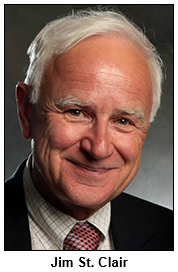 They also have been influential in the development of the Lincoln Boyhood National Memorial, located near Holiday World.
They also have been influential in the development of the Lincoln Boyhood National Memorial, located near Holiday World. - Fort Wayne native Robert Borkenstein (1912-2002), a scientist whose inventions include the Breathalyzer. Hired by the Indiana State Police to establish a lab in Indianapolis, Borkenstein developed the Breathalyzer in the basement workshop of his home in 1954.
- Mother Theodore Guerin, a pioneer nun who traveled from France to the Indiana wilderness in the 1840s. She established schools and helped the poor. In 2006, about 150 years after her death, she was named Indiana's first Catholic saint.
- African-American composer and musician Noble Sissle, an Indy native who became famous in the 1920s for his collaboration with Eubie Blake. Their hit musical Shuffle Along, which premiered in 1921, will be revived on Broadway in February. Sissle's music was performed by stars such as Lena Horne and Sophie Tucker.
- Little Turtle, the great Miami Indian leader who grew up in northeastern Indiana. Although he fearlessly lead Native American forces in war, Little Turtle also worked to achieve peace with white settlers before his death in 1812.
- Clinton County teacher Zerna Sharp (1889-1981), who created the Dick and Jane series of texts used to teach reading for nearly 40 years. Although she was not the author of the series, she was the educator who originated and designed both the format and the content of the stories.
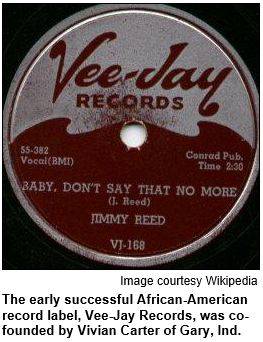 To put together Indiana's 200, our guests Linda Gugin and Jim St. Clair oversaw a massive project years in the making. The profiles of the 200 notables were written by dozens of authors, including Nelson, our host.
To put together Indiana's 200, our guests Linda Gugin and Jim St. Clair oversaw a massive project years in the making. The profiles of the 200 notables were written by dozens of authors, including Nelson, our host.
Linda and Jim have been co-editors of other anthology book projects for the IHS Press, including Governors of Indiana; in April 2013, they were guests on our radio show to share insights about an assortment of the Hoosier state's chief executives.
This time around, we focus on notables from an array of walks of life. In addition to the Koch family, Little Turtle and the others previously mentioned, we explore:
- Sherman Minton of New Albany, who became the first U.S. Supreme Court justice when President Harry Truman appointed him in 1949 to the nation's highest court.
- Vivian Carter of Gary (1921-1989), the founder of Vee-Jay Records, which Indiana's 200 calls "the first successful black-owned record label in America." She even entered into a licensing agreement with the Beatles, selling about 2.6 million of the Fab Four's records in early 1964 before losing them to Capitol Records as a result of contract loopholes.
- And Rachel Peden, who lived on a farm near Bloomington and wrote a popular, nationally syndicated column, The Hoosier Farm Wife Says, from the 1940s through the '70s. Peden described the challenges of family farms as they began to, in her words, "erode away into large farms, like unprotected topsoil into the rivers."
Learn more:
- One-on-one with the editors of Indiana's 200 - Indiana Historical Society.
- Governors of Indiana show with guests Linda Gugin and Jim St. Clair - Hoosier History Live enewsletter.
History Mystery
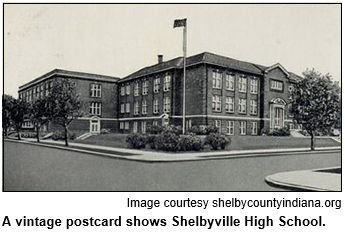 Hoosiers featured in the new book Indiana's 200 include an African-American athlete credited with breaking the color barrier in Big Ten college basketball.
Hoosiers featured in the new book Indiana's 200 include an African-American athlete credited with breaking the color barrier in Big Ten college basketball.
A star on Shelbyville High School's team that won the state tournament in 1947, he was named "Mr. Indiana Basketball" that year. Initially, though, no coach from a white college team even attempted to recruit him. Herman B Wells, then president of Indiana University, eventually pushed for the Shelbyville player to be recruited.
After becoming a fan favorite at IU, where he was named the Most Valuable Player, he played briefly for the Harlem Globetrotters. Then he became the coach at Attucks High School in Indianapolis, which won the state tournament in 1959. He died in 1974.
Question: Who was the history-making basketball player from Shelbyville?
The prize pack includes a gift certificate to Rick's Cafe Boatyard Restaurant and two tickets to the Indiana Experience at the Indiana History Center, all courtesy of Visit Indy.
Roadtrip - Red Skelton Museum in Vincennes
Guest Roadtripper Ken Marshall suggests a Roadtrip to Vincennes in western Indiana not only for its early territorial heritage, but for its fabulous Red Skelton Museum. Comedian Red Skelton, who starred in both radio and television, is yet another celebrated Hoosier and was a native of Vincennes.
The 3,500-square-foot interactive museum looks at the comedy much as Red would see it. It opened in 2013 and focuses on Red's life and the many characters, such as Freddie the Freeloader and Clem Kadiddlehopper, he brought to life through his radio and television shows.
The Red Skelton Museum Gift Shop includes "Red" DVDs, signed and numbered acrylic reproductions of Red Skelton's paintings and more.
The Museum is attached to the Red Skelton Performing Arts Center, featuring a European opera-style theater that seats more than 800. "The Red" is located on the campus of Vincennes University, just one block from Red Skelton's birthplace.

